Synology DS925+ NAS Review – Good News, Bad News
If you have been looking at making the move away from your cloud service provider to gain better ownership of your data, or are looking to upgrade your existing network storage system to something a tad more modern, chances are that Synology and the new DS925+ system have already appeared on your radar. Synology, a 25-year veteran in the world of network-attached storage, is arguably one of the biggest names in the game and has long commanded the largest market share in home and business purchases of NAS. The new DS925+ is the refresh of the late 2022 Synology DS923+, upgrading a few things and arguably clipping the wings of others. Whenever Synology refreshes its range of solutions every few years, it is normally a moment of largely universal praise as long-term Synology users consider upgrading their kit.
However, the Synology 2025 series of devices has been arguably more contentious and criticized internet-wide due to the brand’s changing stance on its support of hard drives in this newer generation, revamping the way in which users can choose which drives they can use in their systems. This change is still very much in its early days and could easily end up working out for the best — or being reversed — but nevertheless, the Synology DS925+ has arrived on the scene to a great deal more criticism and apprehension than most other Synology NAS devices ever launched in the brand’s two-and-a-half-decade-long history. But all of that aside, is the DS925+ actually any good? What can it do, what can’t it do, and does it deserve your money and your data?

Synology DS925+ NAS Review – Quick Conclusion
On a sheer hardware level, the Synology DS925+ is one of the strongest 4-bay systems the brand has ever released in this class. Whether compared to the 2023 refresh or earlier models, it delivers a noticeably better hardware package for the price. The long-overdue move to 2.5GbE is welcome, even if extremely late, and the upgrade from a dual-core, four-thread processor to a quad-core, eight-thread chip is ideal for VMs and containers. The continued inclusion of ECC memory (4GB, expandable to 32GB) reinforces its focus on reliability. DSM remains a standout — arguably still the best turnkey NAS OS on the market for stability, usability, and features. However, the removal of 10GbE upgrade options feels like a significant regression, especially as external 2.5G/5G USB network adapters are now commonplace. The hardware, while generally solid, will still feel underwhelming to users who expect more flexibility — especially given the price.
But it’s Synology’s aggressive stance on storage compatibility that casts the longest shadow. The DS925+ refuses to initialise DSM unless you’re using approved drives — a dramatic shift from previous generations using identical hardware that supported many third-party drives. Synology’s vague communication and inconsistent rollout of this policy only amplify user frustration. It’s hard to escape the sense that Synology is either hesitating to fully commit to bundling its NAS units with storage, or clumsily trying to control the ecosystem. The DS925+ is still a very good NAS, maintaining a decade-long price point while offering improved internals and software. But unless Synology quickly clarifies this compatibility policy, this release may be remembered more for controversy than capability — their biggest “Apple moment” yet, for good or for bad.
Where to Buy a Product





![]()
![]()

VISIT RETAILER ➤






![]()
![]()

VISIT RETAILER ➤






![]()
![]()

VISIT RETAILER ➤






![]()
![]()

VISIT RETAILER ➤
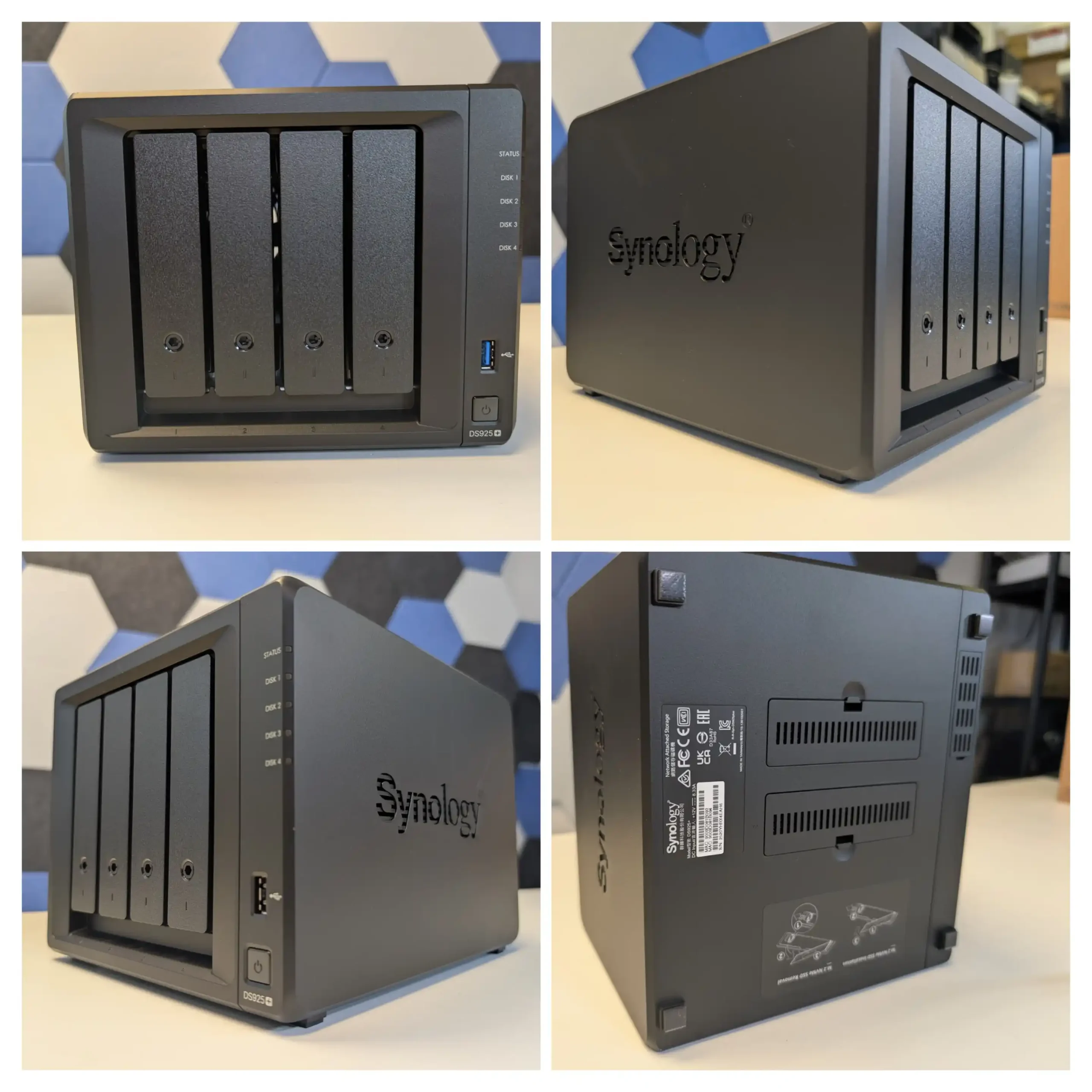
Synology DS925+ NAS Review – Design, Cooling and Power Consumption
The DS925+ maintains Synology’s long-standing chassis design, which has remained largely unchanged since around 2018–2019. It features a compact black plastic exterior with a solid metal internal frame that offers excellent durability and airflow.
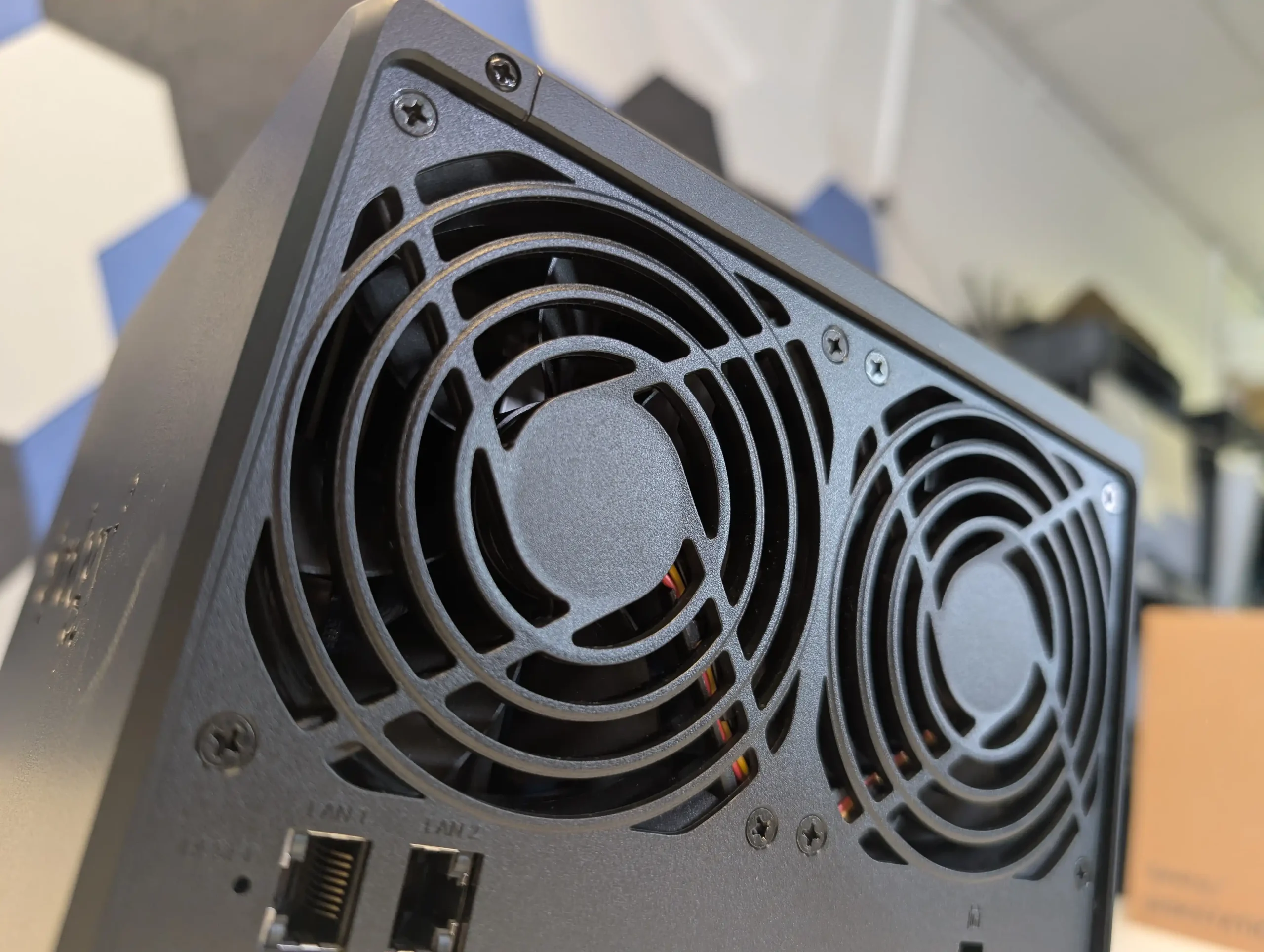
The unit measures the same as its predecessors and blends easily into home or office environments. Ventilation is a central focus of the design, with large ventilated side panels, additional intake on the base, and a dual-fan array at the rear. These two 92mm fans replace the more typical single-fan setup found in many rival 4-bay systems, providing a more even and effective airflow throughout the unit.
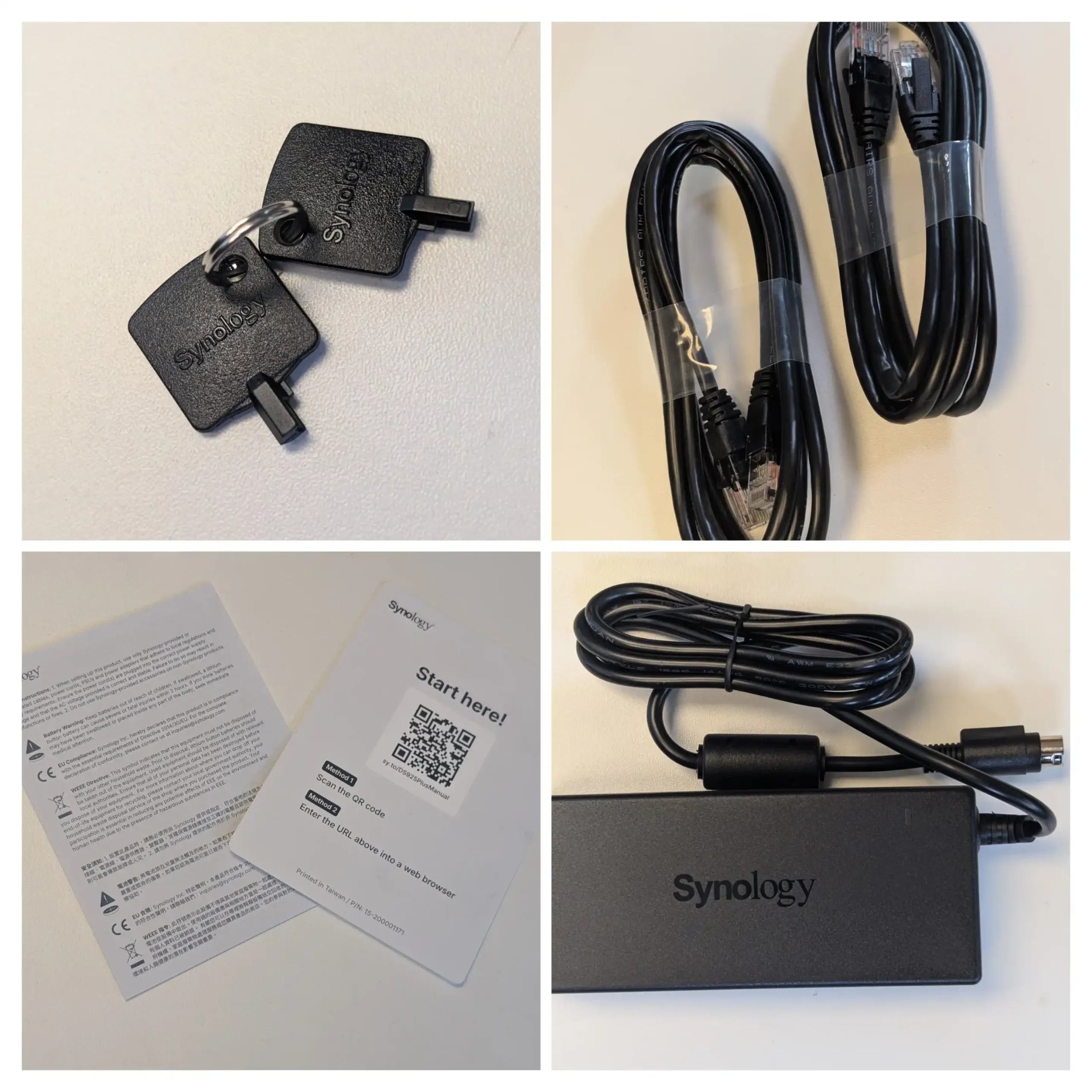
The DS925+ also uses an external 100W power brick, though actual usage rarely approaches that limit.
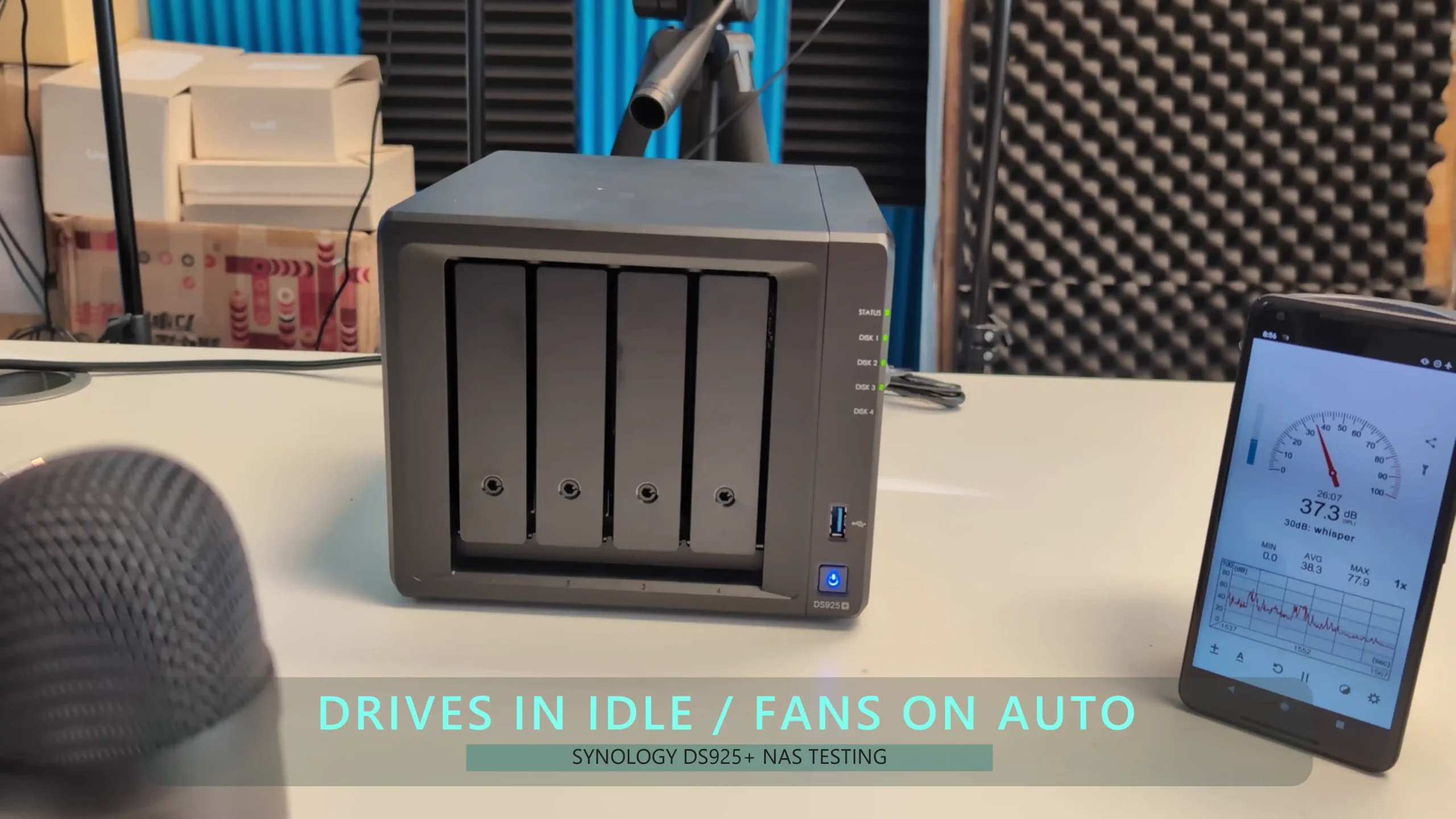 |
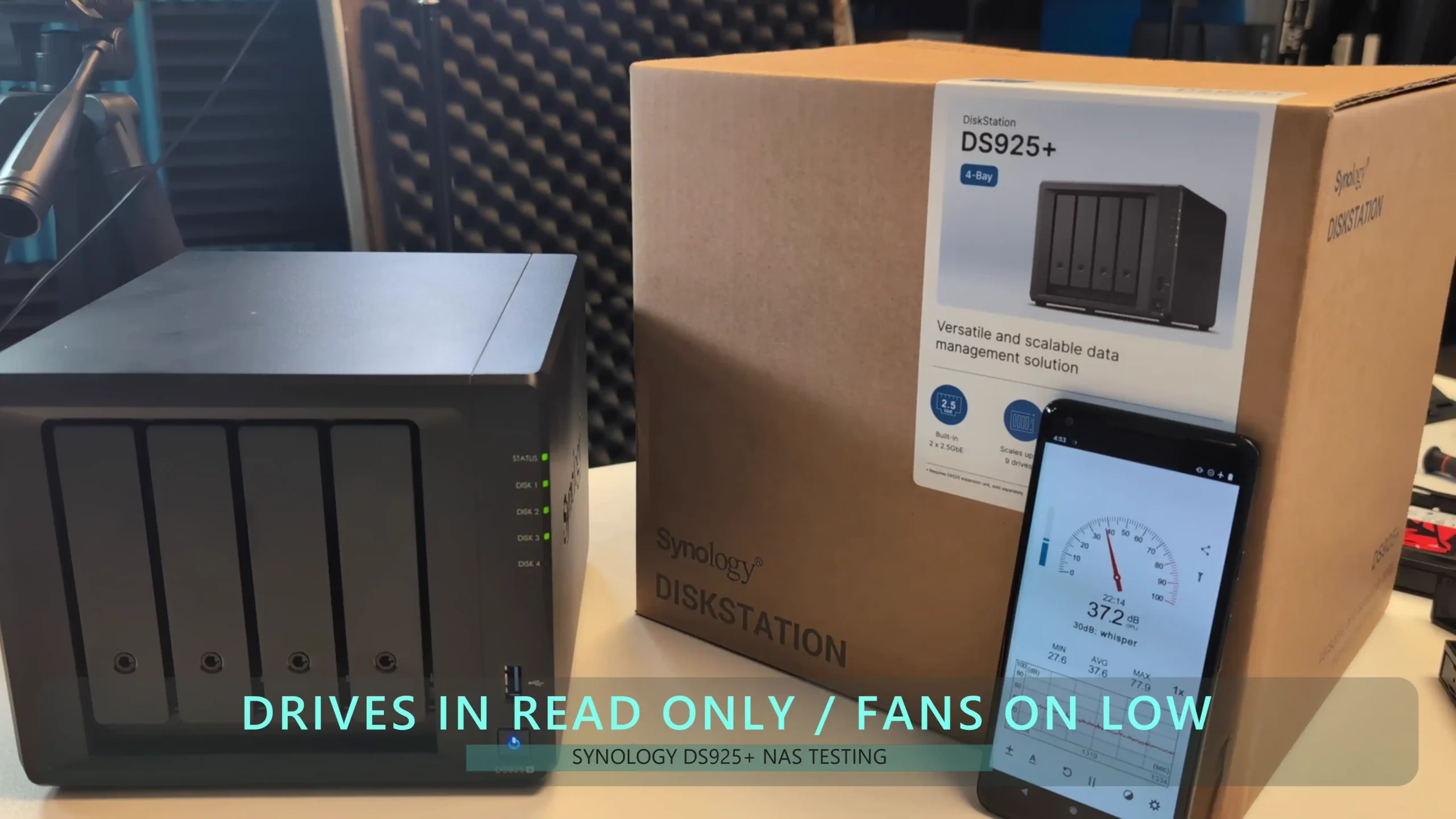 |
In terms of noise, the DS925+ is impressively quiet during idle and moderate use — provided you’re using standard Synology-branded drives. With the system fully idle (RAID built, fans running at variable speed, no active users), the noise levels hovered around 36–37 dB(A).
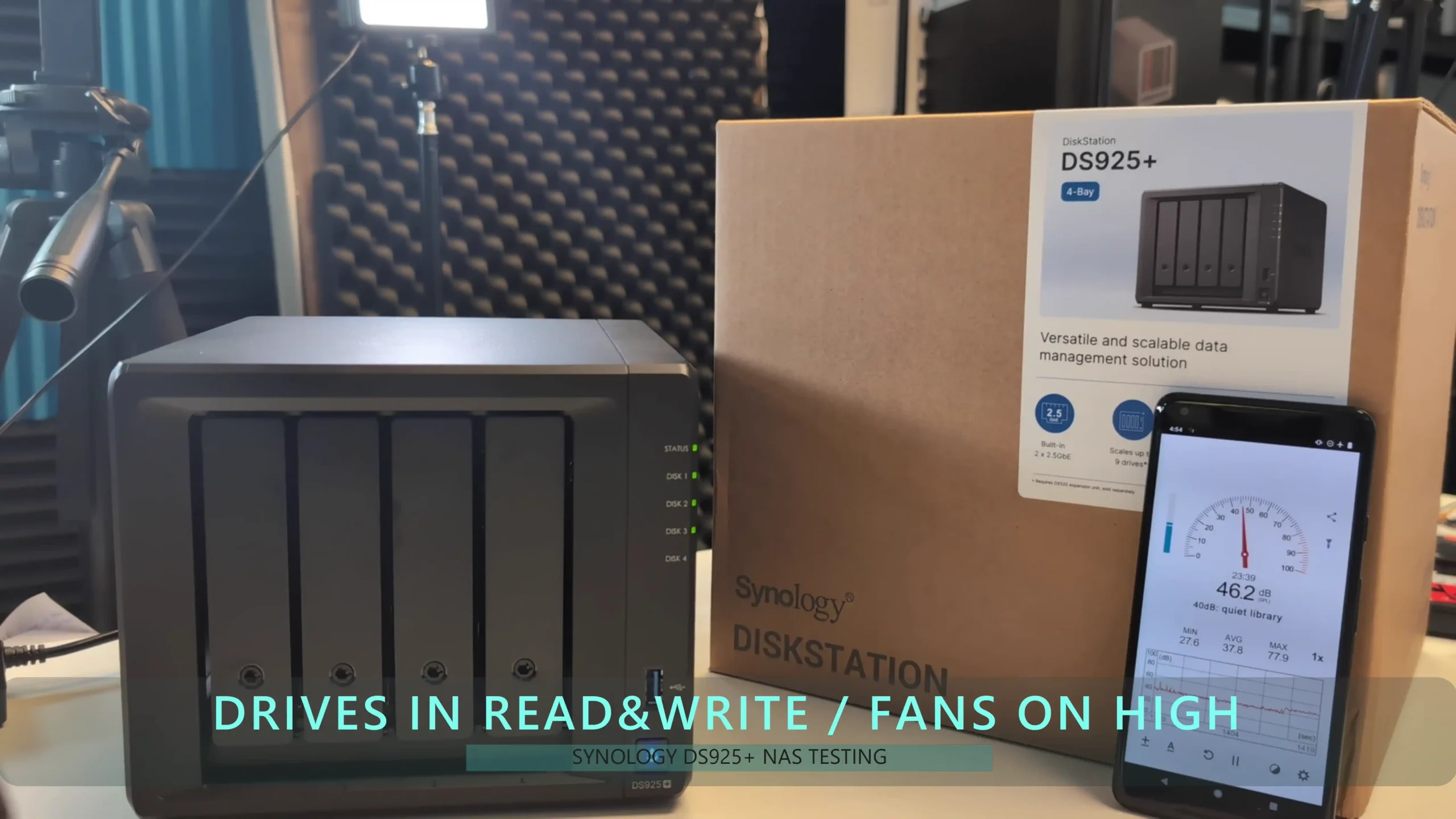 |
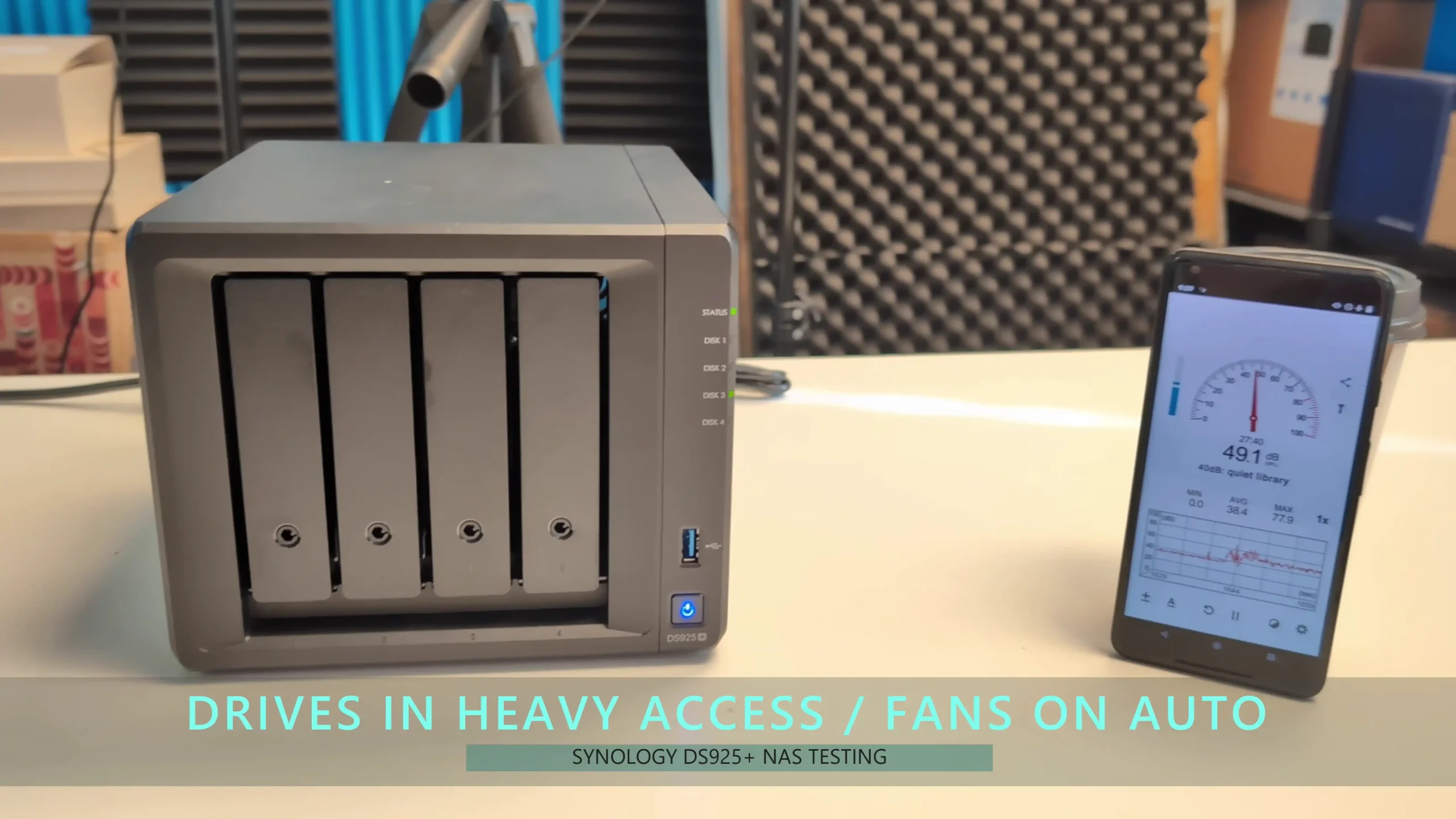 |
When pushed with dual 2.5GbE connections and all drives under load, noise levels rose to about 48–50 dB(A), though much of this was attributed to the drives rather than the fans. Users planning to install high-capacity, enterprise-class drives like the HAT5300 series should expect higher operational noise. While the NAS fans remain relatively quiet, drive selection plays a significant role in the overall acoustic footprint of the system.
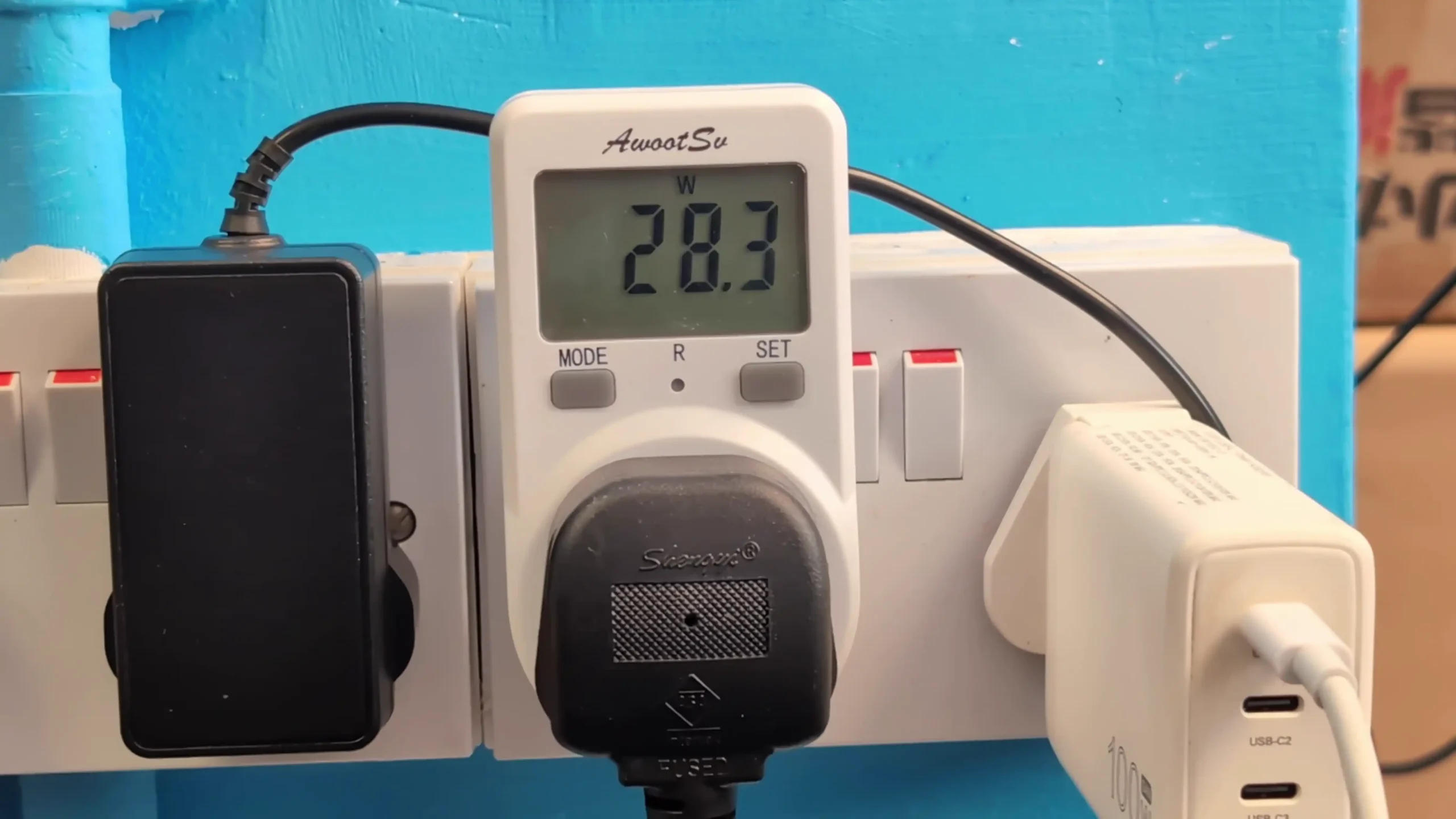
Power consumption during testing was also well within expectations. In a fully idle state, with base apps installed and the system not being accessed, the DS925+ drew approximately 28 watts. When fully loaded — with all four bays filled, SSDs installed, the CPU under strain, and both 2.5GbE connections active — consumption peaked around 62–64 watts.
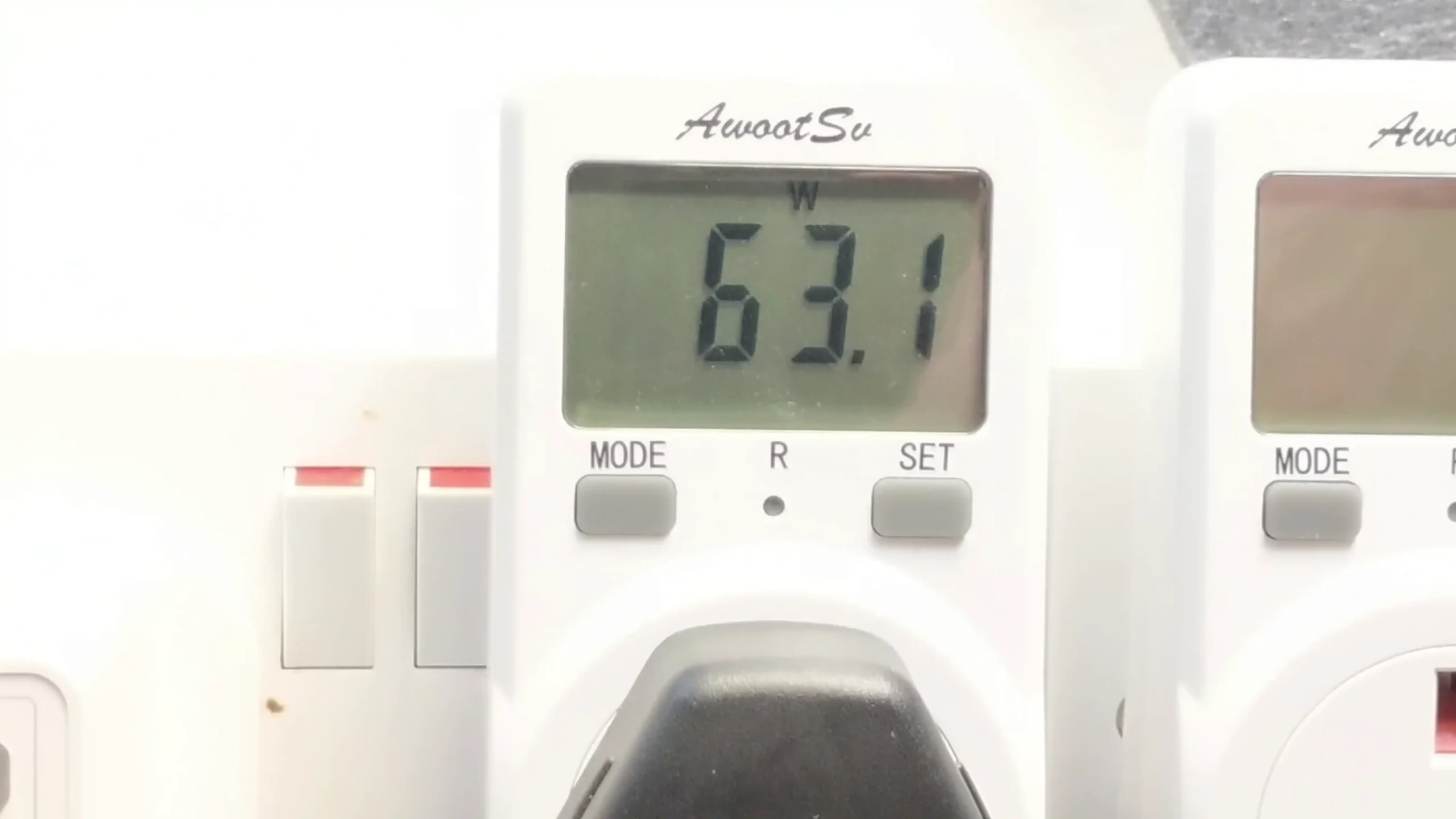
These numbers align with what you’d expect for a Ryzen V1500B-based system with ECC memory and SSD support, though it’s worth noting that Synology’s own published power usage figures are lower. This discrepancy is likely due to Synology using SSDs in their testing rather than HDDs, which naturally draw more power and generate more heat.
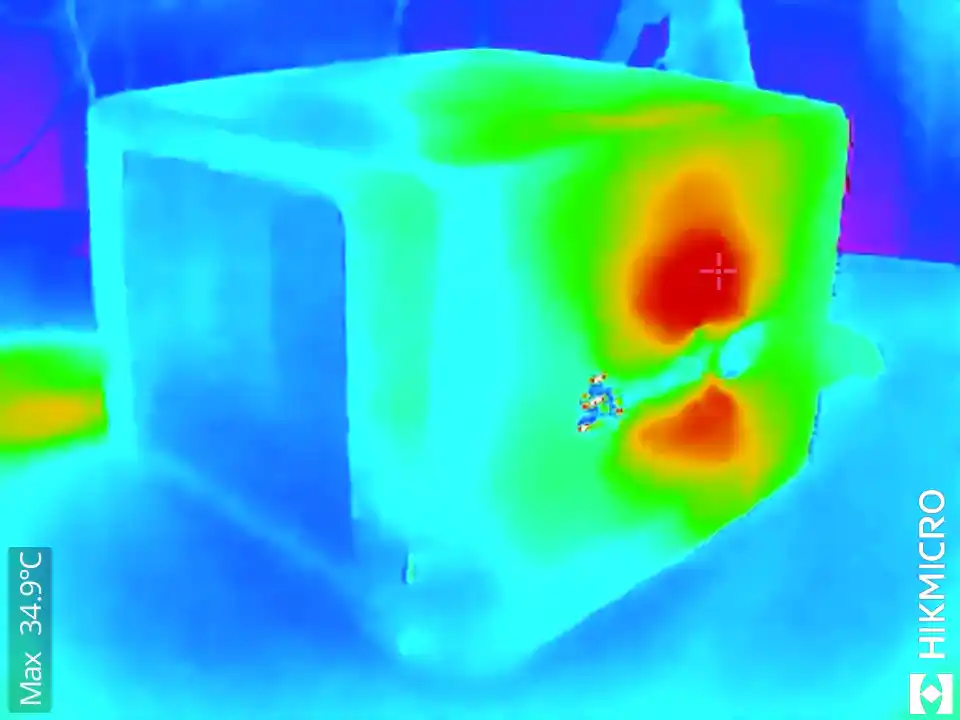
Thermal performance on the DS925+ is particularly strong, especially considering the plastic enclosure. At the one-hour mark under moderate usage, system temperatures ranged from 35°C to 39°C.
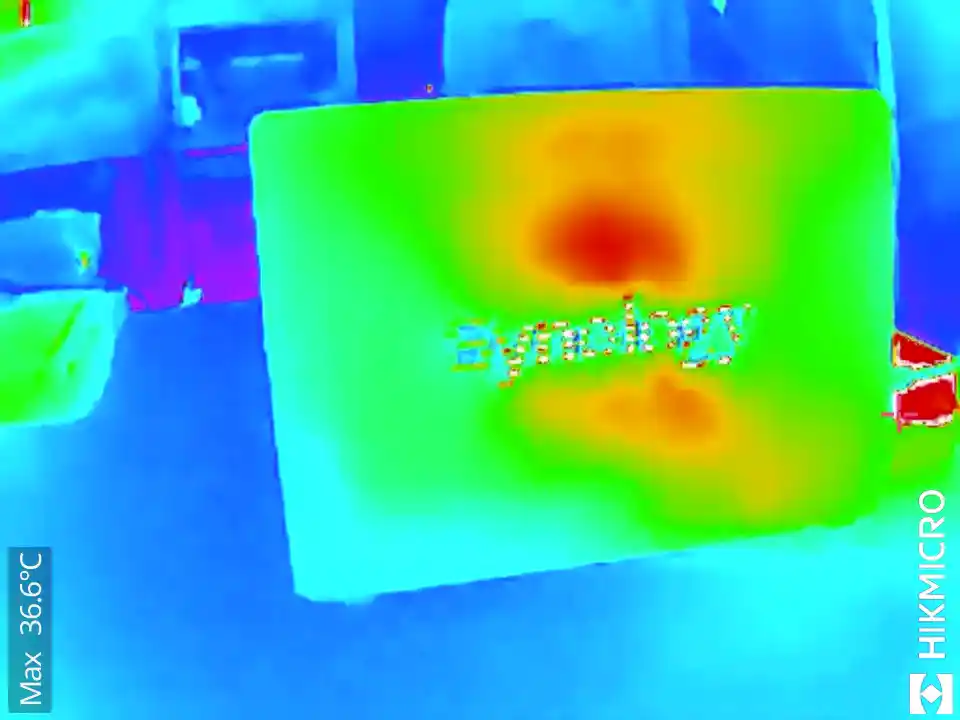
After 24 hours of intermittent access, including background tasks like scrubbing and package installation, the system maintained a stable range of 34°C to 36°C. The dual rear fans, in conjunction with the well-ventilated chassis, clearly play a key role in keeping the internal environment controlled. These results are especially encouraging given that many competing 4-bay NAS systems still ship with only a single rear fan and less efficient airflow paths.

Bottom line, the DS925+ offers a refined, if familiar, physical design that prioritises quiet operation, effective heat management, and reasonable power efficiency – something this product series has always excelled at vs it’s competitors (such as the QNAP TS-464, Asustor Lockerstor series or still new UGREEN DXP4800. While Synology hasn’t reinvented the chassis, the dual fan design, ample ventilation, and strong thermal numbers show thoughtful incremental improvements. However, as with most NAS systems, the overall experience is still influenced heavily by drive selection — particularly in terms of noise and power draw. For users seeking a low-noise, power-efficient solution with excellent temperature control, the DS925+ remains a very well-balanced option in the 4-bay NAS category.

Synology DS925+ NAS Review – Ports and Connectivity
The Synology DS925+ supplies a fairly middling range of connections, depending on your point of view. Hot take: if you were to compare this device against previously released Synology devices, there is actually something of a mixed bag here to like as well as dislike. Likewise, if you compare the device to the available range of NAS solutions from this brand’s competitors, you could probably be especially critical of what you see here. However, there are some interesting features worthy of note, and given Synology’s heavy emphasis on internal operations and remote access priorities, it isn’t a huge surprise that the physical connections on this modest system are likewise pretty understated.
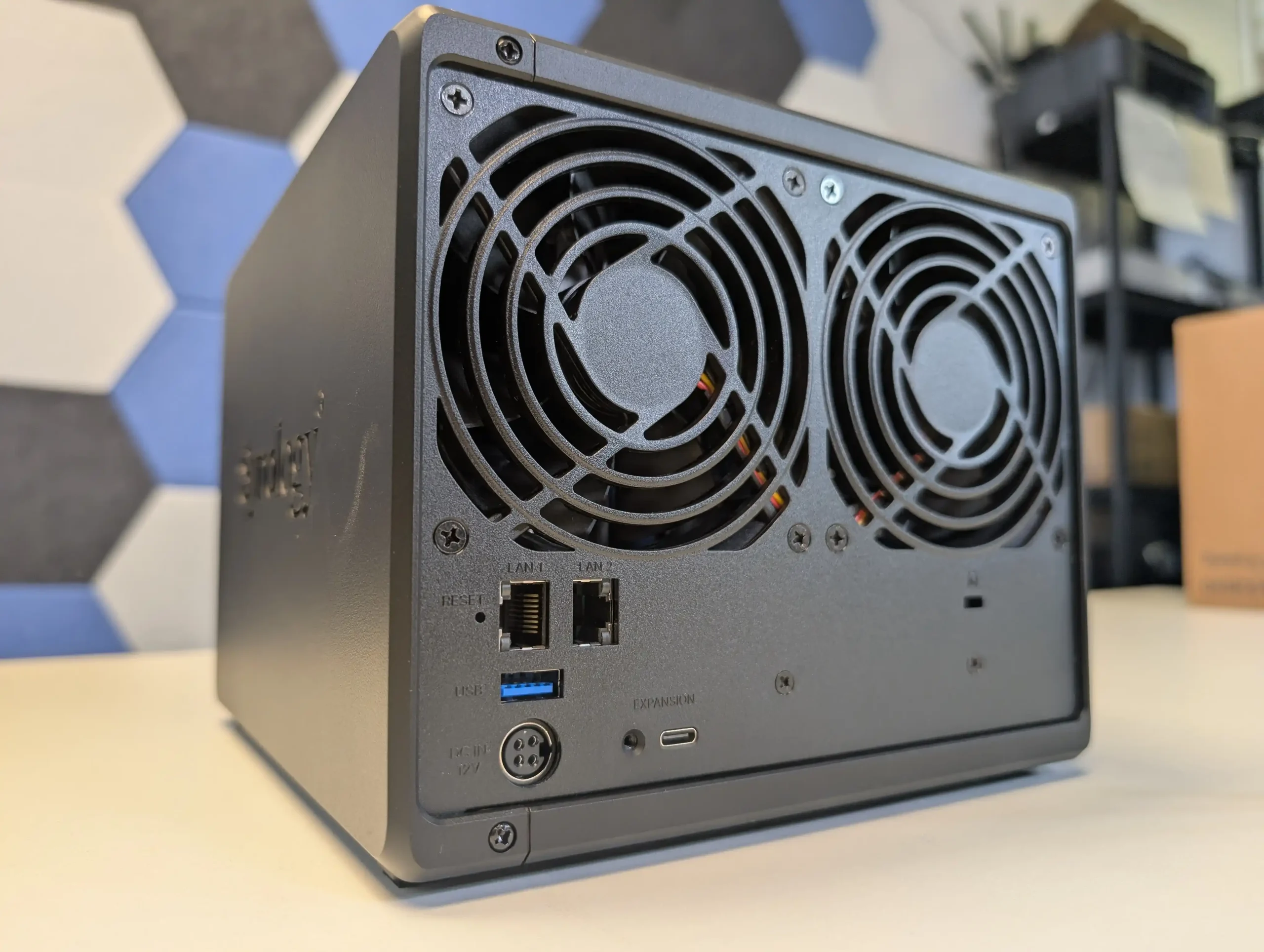
The front of the system features a single USB Type-A 5 Gb per second connection port that is predominantly used for connecting storage drives to make them remotely accessible. Synology has largely reduced the utility of these USB ports on their systems to simply storage and connection of a UPS system. So you can forget about utilising the majority of PC USB peripherals, directly connecting to the device over USB, or even simple network USB adaptors — a particularly unpopular choice by Synology in their DSM 7 update a few years ago. That said, the USB connectivity integrates extremely well with the backup software on this system, allowing for scheduled and automated backups to be conducted via this port, with particularly sophisticated filter customisation as needed.
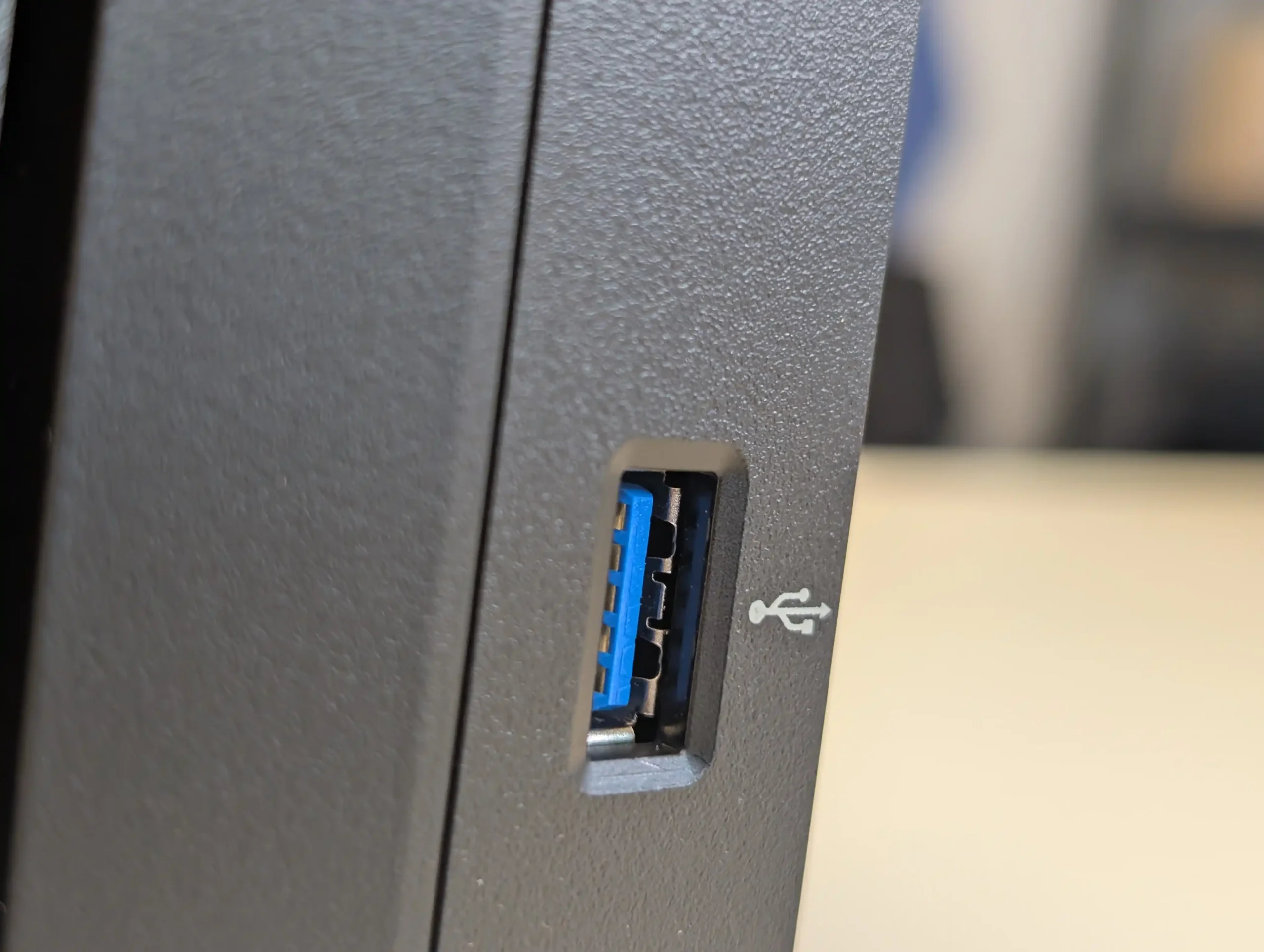
Flipping the device around shows us the more important system connections available on the DS925+. The big headline here is Synology finally — finally — upgrading this system and the 2025 generation moving forward with 2.5 GbE ports, rather than the pedestrian and outdated 1 GbE network ports. The system features two ports, and the DSM platform allows for merging of these connections via protocols such as port trunking, link aggregation, load balancing, and SMB multi-channel, as well as failover as needed. These are certainly a welcome — if hugely overdue — upgrade on this system (when the bulk of this brand’s hardware competitors rolled out 2.5G as much as five years earlier at a similar price point). But at the very least, this does mean that users are going to be able to enjoy fuller saturation of the four SATA drive connections on this system more so than in previous generations of this product series.
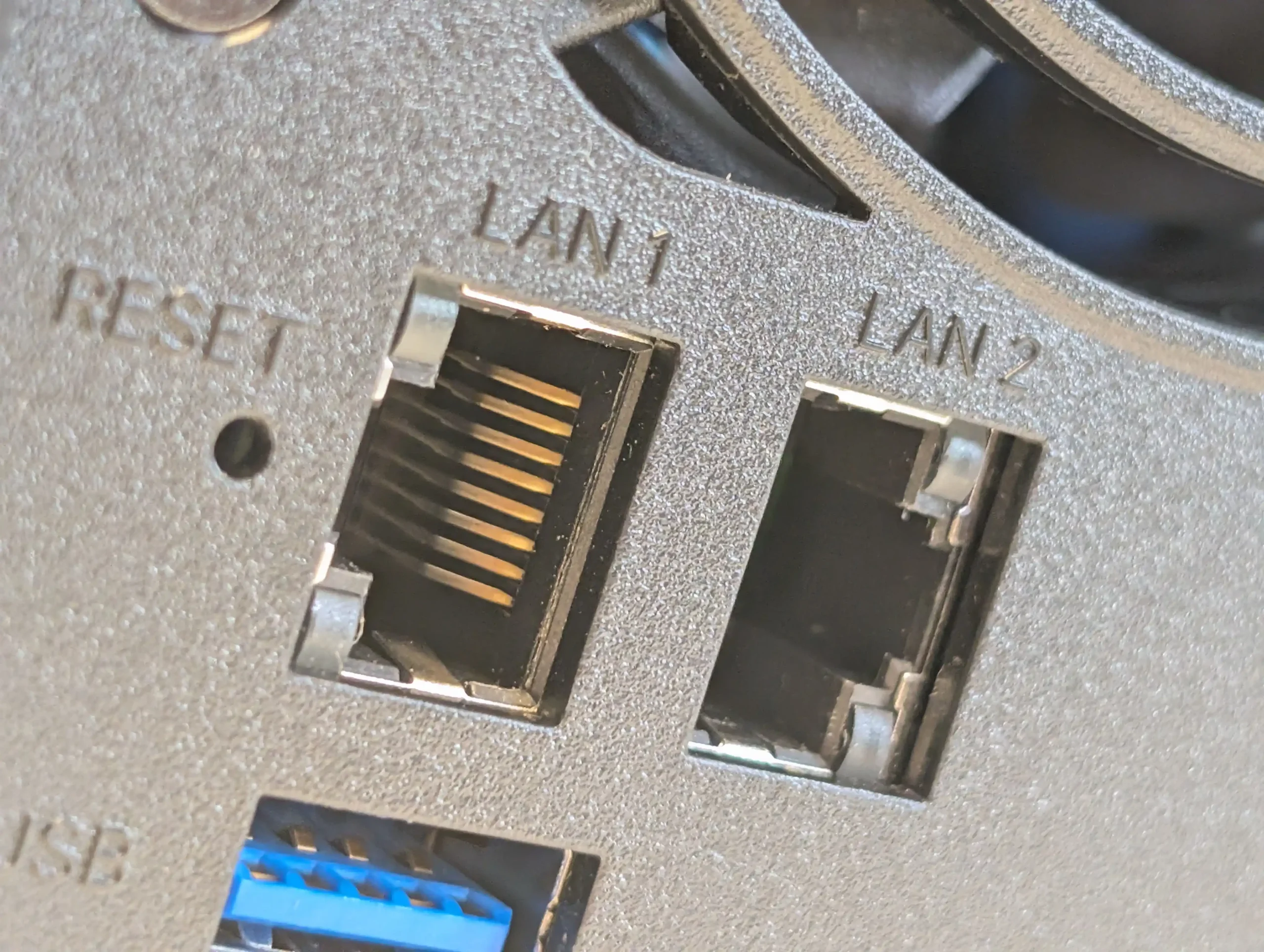
That said, Synology giveth and Synology taketh away! Even though Synology has upgraded the default network connections on the device, they have removed the optional mini PCIe upgrade slot that was available on the DS923+ before this. This is going to be a huge kick in the ass for a lot of users who were considering purchasing this device over the DS923+ predecessor, as it means that the ability to scale up the network connectivity toward 10GbE is now not available on this system. So despite the fact that this system can now comfortably accommodate over two and a half times the external network bandwidth of its predecessor out of the box, it also means that the effective potential maximum network connectivity that a user could hope to achieve down the line has now been effectively halved! Again, this was always an optional upgrade in its predecessor, but it was an extremely welcome one for many — and given that even their value series of hard drives can hit between 180 and 200 MB per second per drive, that means that even the most inefficient RAID cluster with these drives will almost certainly still oversaturate the base twin 2.5G connections that the base model has. Therefore, you are being somewhat bottlenecked down the road because of this lack of network adapter upgradability. And don’t even get me started on the throttling that you will likely encounter if utilising M.2 NVMe RAID pools on the DS925+ via remote network connectivity.
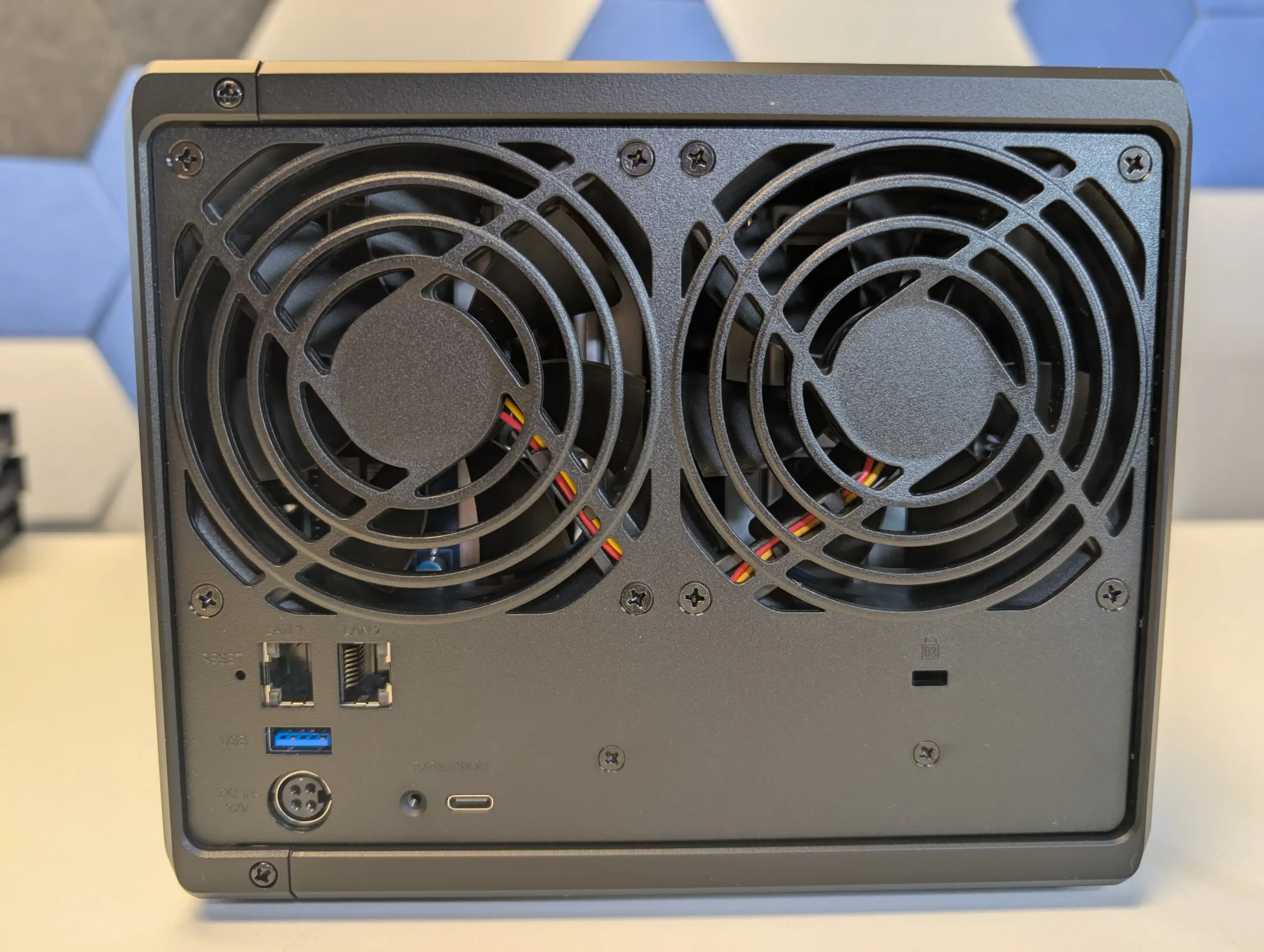
Finally, we find another change in this product over its predecessors, and that is the shift in expandability on this system toward a USB-C output. This USB-C provides 5 Gb/s connectivity and only supports the new DX525 expansion chassis, which costs around $350 to $450 depending on where you are in the world and your local tax rate. Synology has always afforded the ability to expand this product series with a 5-bay expansion, either to spread the RAID configuration or mirror it appropriately, so this is a welcome — if expected — integration in the DS925+ class nonetheless, and it allows for greater storage scalability over the years.
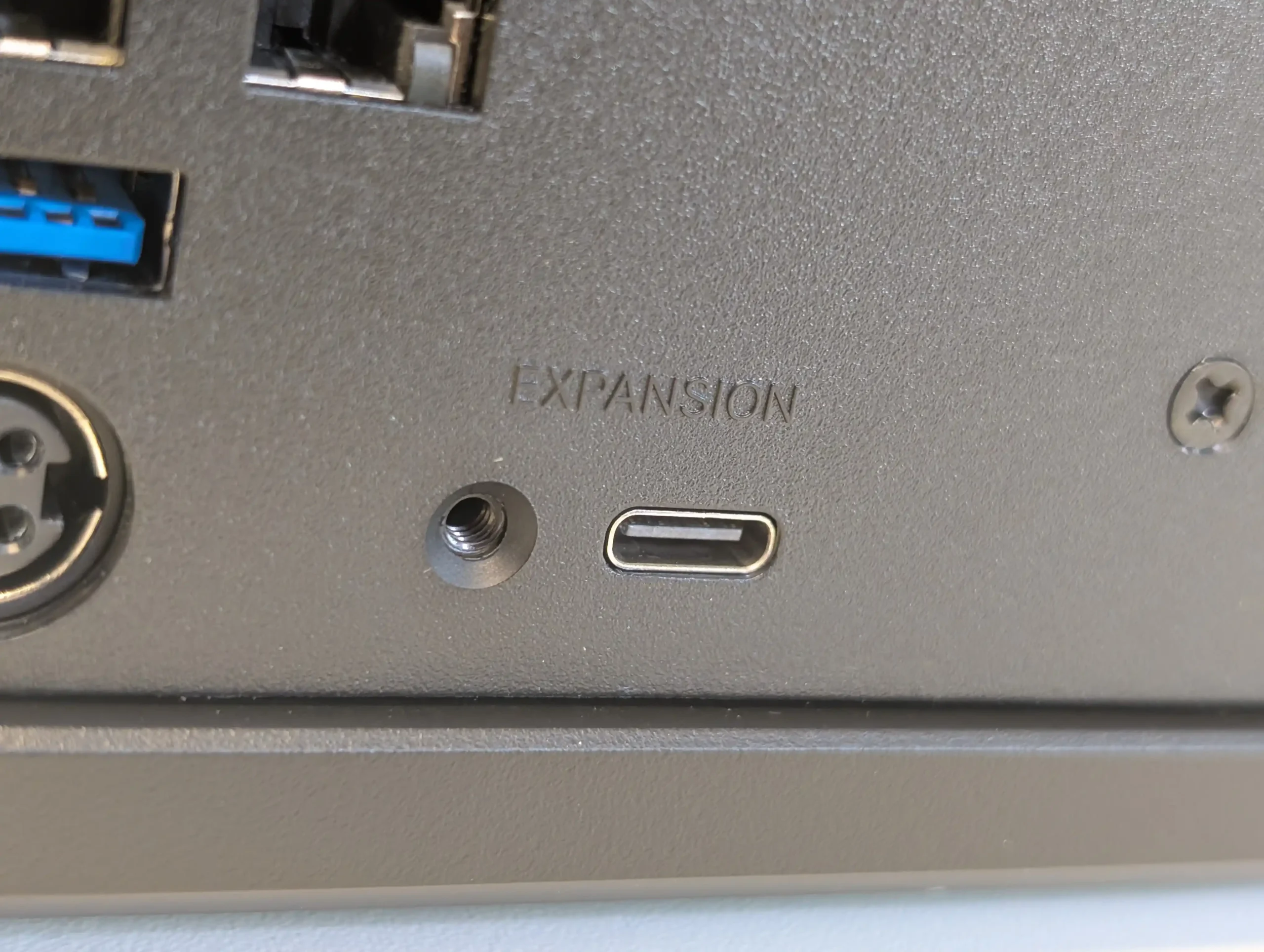
All that said — and I’m sorry to be negative again — I can’t help but feel that this expandability is still being handled a tad clumsily. For a start, even at USB-C, that still means that the five SATA drives that the expansion supports are effectively capped in their maximum external bandwidth potential. And although you were never really going to enjoy greater speeds regardless — due to the 2.5 GbE network connectivity anyway — there are definitely going to be users who are sad about this further bottleneck on the performance of those drives in the expansion.
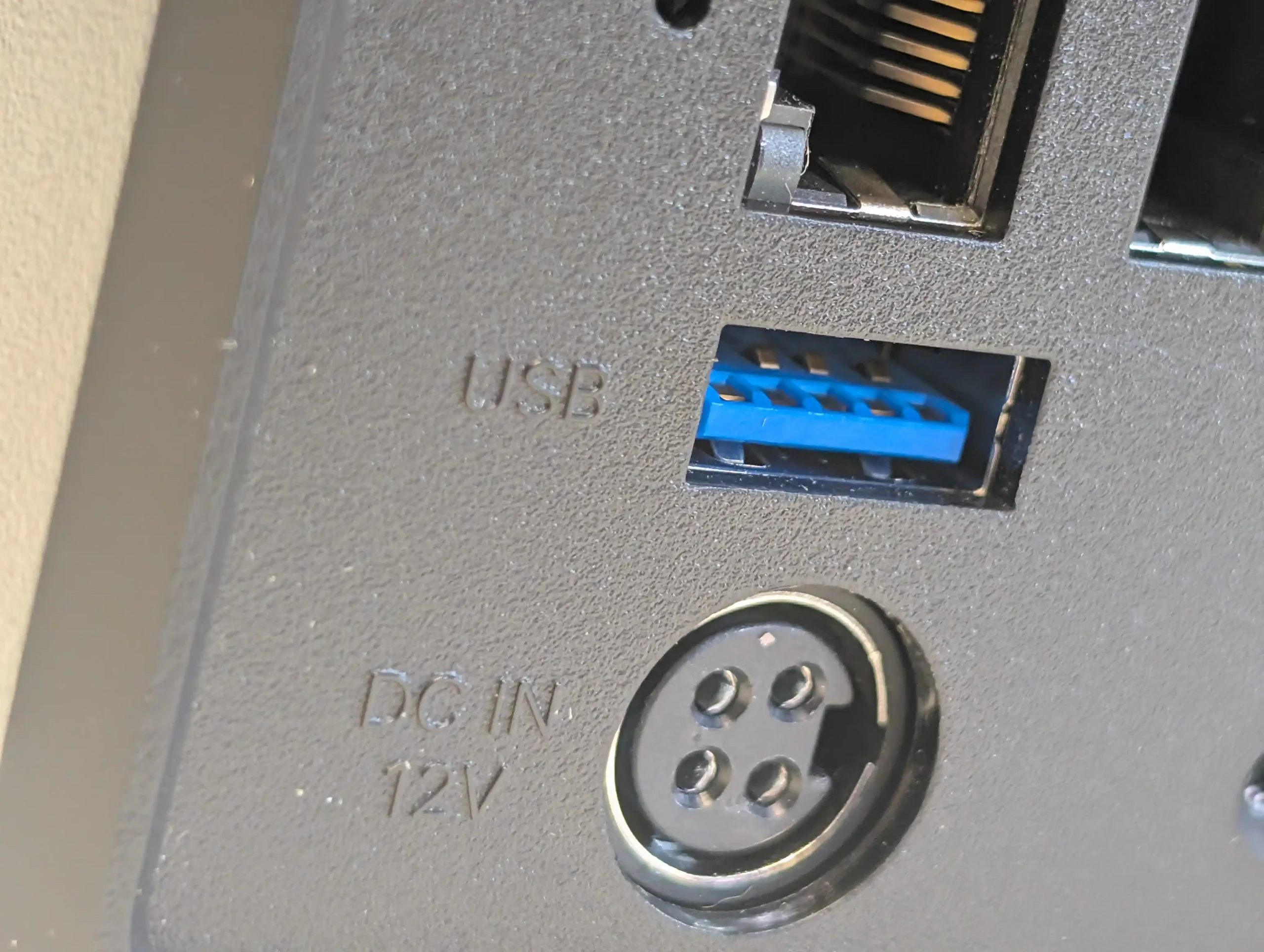
The fact that Synology did not implement an improved means of network connectivity — perhaps via 10 GbE or USB 3.2 Gen 2 (almost certainly due to a CPU choice limitation) — is really disheartening. Likewise, since this expansion now connects over standard USB, why are we still only limited to one expansion, and only via that specific USB port? The fact that we could have increased the number of expansion devices in line with the other available USB ports would have been tremendously appealing to users thinking about the long-term scalability of their system. And given that USB ports are common (if a little more restrained) on practically every single Synology NAS, this is a real missed opportunity to add storage expandability — and I can only assume it’s a conscious and deliberate choice by the brand to maintain their portfolio segmentation.
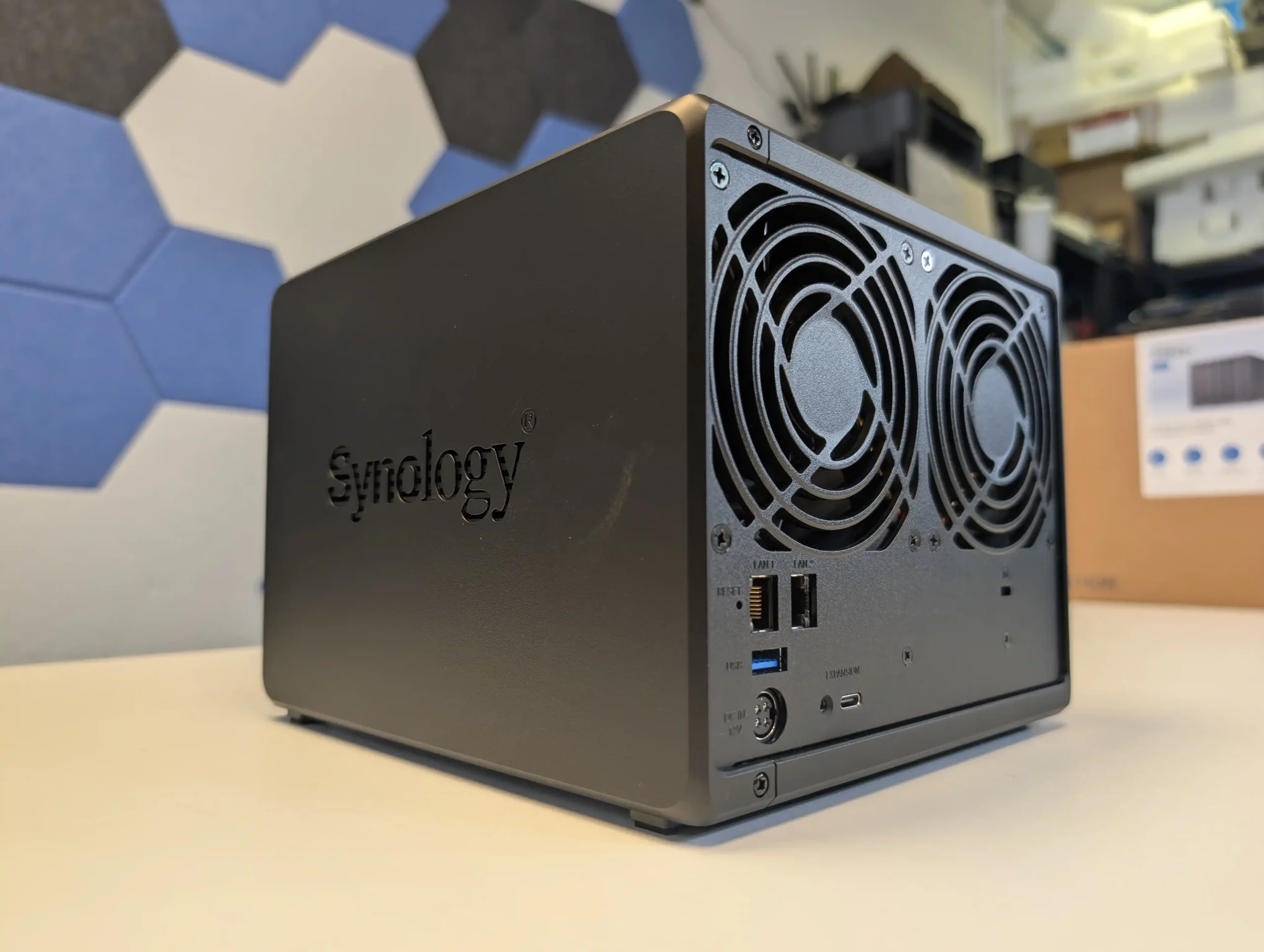
Bottom line: I love that this system is expandable, and I do like that a number of the features of the system have been improved over its predecessor. But as I mentioned earlier, the general standard of connectivity on the DS925+ is still awfully restrained when you take even a casual glance at the rest of the market right now. It only further underlines the fact that Synology is doubling down on this system more in terms of its software and capabilities rather than its hardware — which is no doubt going to please the bulk of users looking at this system who just want a stable NAS that does its job, but will nonetheless annoy enthusiasts and prosumers who want to make the most of their hardware.
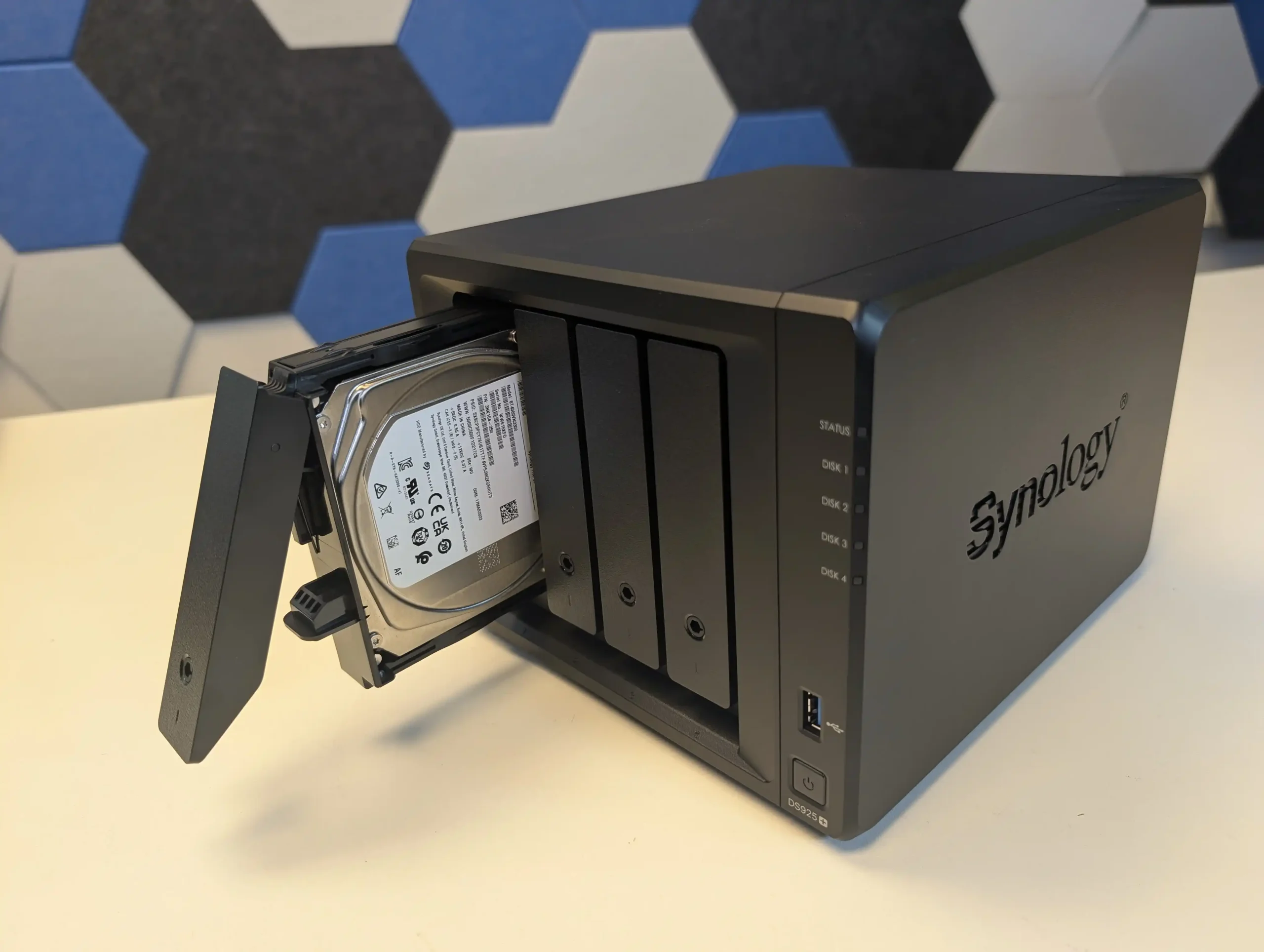
Synology DS925+ NAS Review – Internal Hardware
If there is one area that Synology consistently gets criticised for, it is the hardware they choose to use. It can definitely be argued that, as a NAS is a 24/7 system, manufacturers need to focus heavily on the efficiency of hardware and keep things as high-performance as possible at the lowest cost of power consumption and hardware utilisation. Equally, it could be argued that because Synology prioritises software over hardware — and wants to maintain tightly locked price points in its portfolio — over the years they have had to be awfully tactical in the hardware they choose to use across their product lines. All these things no doubt play their part, but nonetheless, it all adds up to a system that is not exactly going to blow anyone away if they are looking at the hardware specs as the chief buying point for their first server or an upgrade.

The first thing I want to discuss is that CPU! Keeping things positive, this is a four-core, eight-thread AMD embedded server-class Ryzen processor. In human speak, that means this CPU is designed for server utilisation — chiefly for file processes and for spreading itself quite thinly across multiple processes and tasks with efficient ease. Additionally, this processor has already been utilised and heavily investigated by Synology since its first rollout at the higher end of the SMB section of its portfolio as early as 2019/2020 — so the brand has extensive experience in getting the very most it can out of this processor. Additionally, Synology has often taken the hardware configuration of a higher-tier solution in their portfolio and — between multi-year refreshes — then passed this hardware configuration down into lower and more affordable tiers over the years. So this processor’s appearance, and its refresh of the previous R1600 dual-core, four-thread processor in the DS923+ predecessor, is not unexpected — and for many, actually quite welcome.
Here is how the R1600 in the DS923+ 2022/2023 Release compares with the V1500B in the DS925+ Refresh:
| Category | R1600 (DS923+)
|
V1500B (DS925+)
|
Advantage / Notes |
|---|---|---|---|
| Release Date | Q2 2019 | Q1 2018 | R1600 is newer |
| Cores / Threads | 2 Cores / 4 Threads | 4 Cores / 8 Threads | V1500B offers more parallel processing |
| Base / Boost Frequency | 2.6 / 3.1 GHz | 2.2 GHz | R1600 has faster clock speeds |
| Architecture (Codename) | Zen (Banded Kestrel) | Zen (Great Horned Owl) | – |
| Instruction Set | x86-64 + SSE4a, AVX2, FMA3 | x86-64 + SSE4a, AVX2, FMA3 | – |
| Hyperthreading | Yes | Yes | – |
| Overclocking | No | No | – |
| TDP (PL1) | 18W (up to 25W) | 16W | R1600 allows more thermal headroom |
| Tjunction Max | 105°C | 105°C | – |
| L2 Cache | 1 MB | 2 MB | V1500B has more L2 cache |
| L3 Cache | 4 MB | 4 MB | – |
| Memory Support | DDR4-2400, ECC, Dual Channel, 32 GB Max | DDR4-2400, ECC, Dual Channel, 32 GB Max | – |
| Max Memory Bandwidth | 38.4 GB/s | 38.4 GB/s | – |
| PCIe Version / Lanes | PCIe 3.0 / 8 lanes | PCIe 3.0 / 16 lanes | V1500B has more connectivity bandwidth |
| PCIe Bandwidth | 7.9 GB/s | 15.8 GB/s | V1500B supports double the PCIe throughput |
| Manufacturing Node | 14nm | 14nm | – |
| Chip Design | Chiplet | Chiplet | – |
| Virtualization Support (AMD-V, SVM) | Yes | Yes | – |
| AES-NI Support | Yes | Yes | – |
| OS Support | Windows 10, Linux | Windows 10, Linux | – |
Likewise, this processor provides the full spectrum of system software services and abilities that DiskStation Manager 7.2 has to offer. There is not a single DSM application or component that you are unable to take advantage of on this hardware spec. Alongside that, this CPU will comfortably allow for a decent number of VMs, containers, file processes, and simultaneous proprietary application services to all run at the exact same time — despite this system’s modest stature. Integrated graphics processors have been phased out from this particular product family — and this is the second refresh of the product line to remove integrated graphics-equipped processors — instead moving this kind of deployment to its smaller and more multimedia-focused DS425+ and DS225+ models. There are mixed results to this of course, especially given that the DS925+ has removed network upgradability — which I think may well leave quite a lot of CPU bandwidth by the roadside somewhat. But given the similarity in price point between this system and previous refreshes of this 4-bay series, I’m not, on the whole, unhappy with this processor. It’s just a continued departure by the brand away from classic 4-bays like the DS920+ and DS918+.
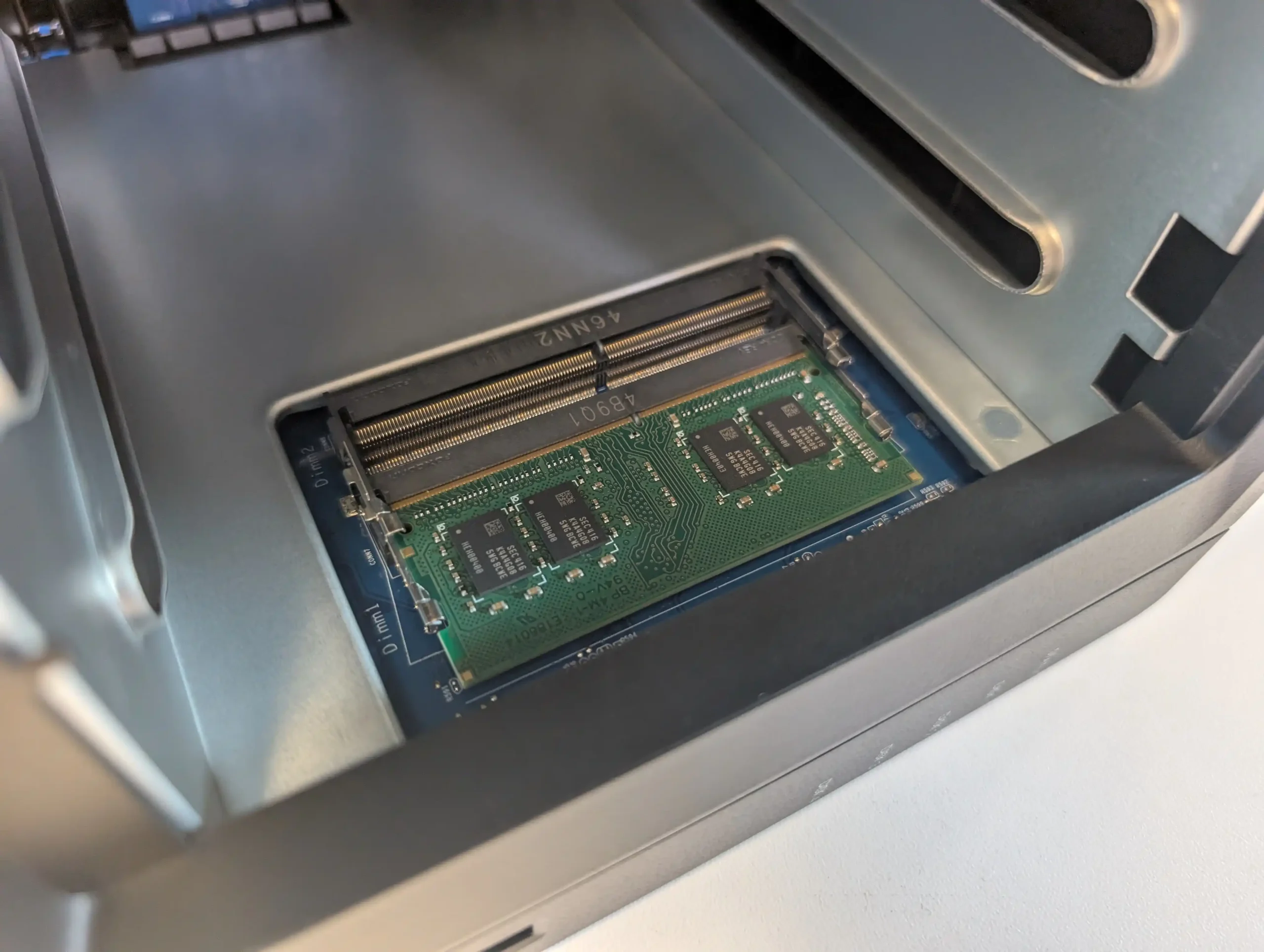
Alongside this processor, the system arrives with 4GB of DDR4 ECC SO-DIMM memory. ECC memory, in most network storage tech circles, is absolutely paramount for high-volume and high-frequency file transfers and long-term storage. Very, very few systems at the $550 price point ever include ECC memory in a turnkey NAS solution, and I know this is something that has always met with phenomenal praise by system integrators (SIs) who recommend Synology for simple and effective business storage requirements. Additionally, this memory can be scaled up all the way to 32GB, which — once you factor in the eight threads on this processor being spread out across multiple processes — is pretty darn good when you think about the scale of this system physically versus the potential of that software! Of course, in line with several other Synology policy changes over the years, the system is strictly compatible with only first-party memory upgrades from Synology — which you will not be surprised to hear are notably more expensive than third-party options in the market from Crucial, Kingston, and Samsung. This has always been something that has been met with notable disapproval by many, but Synology defends this by repeating the point that they want a single-party ecosystem, and the DS925+ is an appliance that centres around being smooth, efficient, and easy to deploy.

At the base of the system, we find the two M.2 NVMe slots that allow you to install one or two 2280-length SSD drives that can be utilised for read & write caching and/or use as storage pools. The benefits of utilising caching — when used in conjunction with the ECC memory and that file-transmission-focused processor — are pretty bloody significant, and it does allow for a degree of versatility and optimisation for users once again focused on high-volume and high-frequency data storage needs 24/7. But the use of these bays for storage pools is still pretty underwhelming at launch, and a big part of this is — much like other system upgrades — these M.2 bays are limited to only using Synology NVMe SSDs. This is a limitation compared with the predecessor, and while it’s a small tweak over the status quo, it becomes a significant one when you factor in that, currently, the only Synology M.2 NVMe offering is the heavily durability-focused but write-performance-weak SNV3400 series.
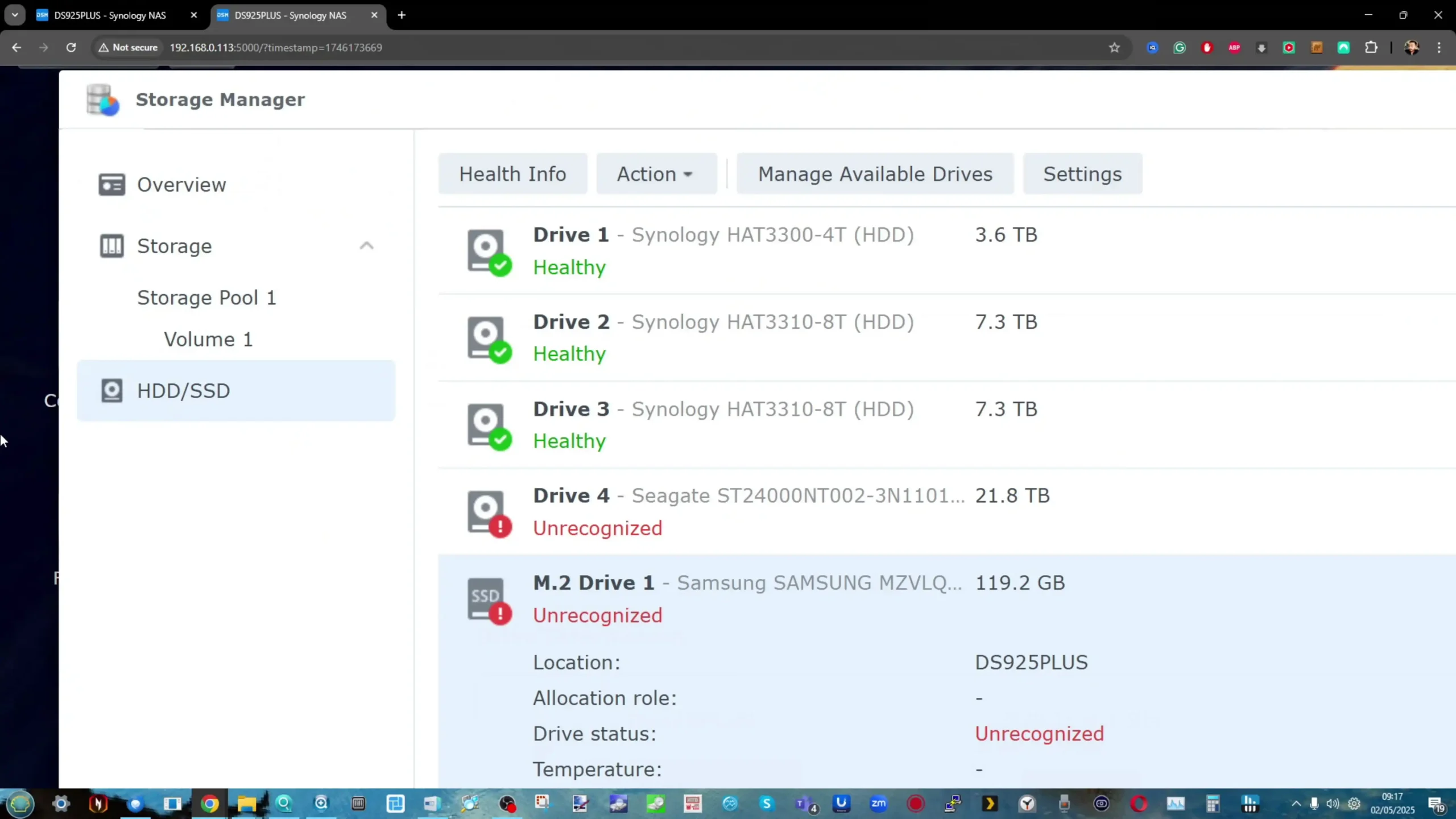 |
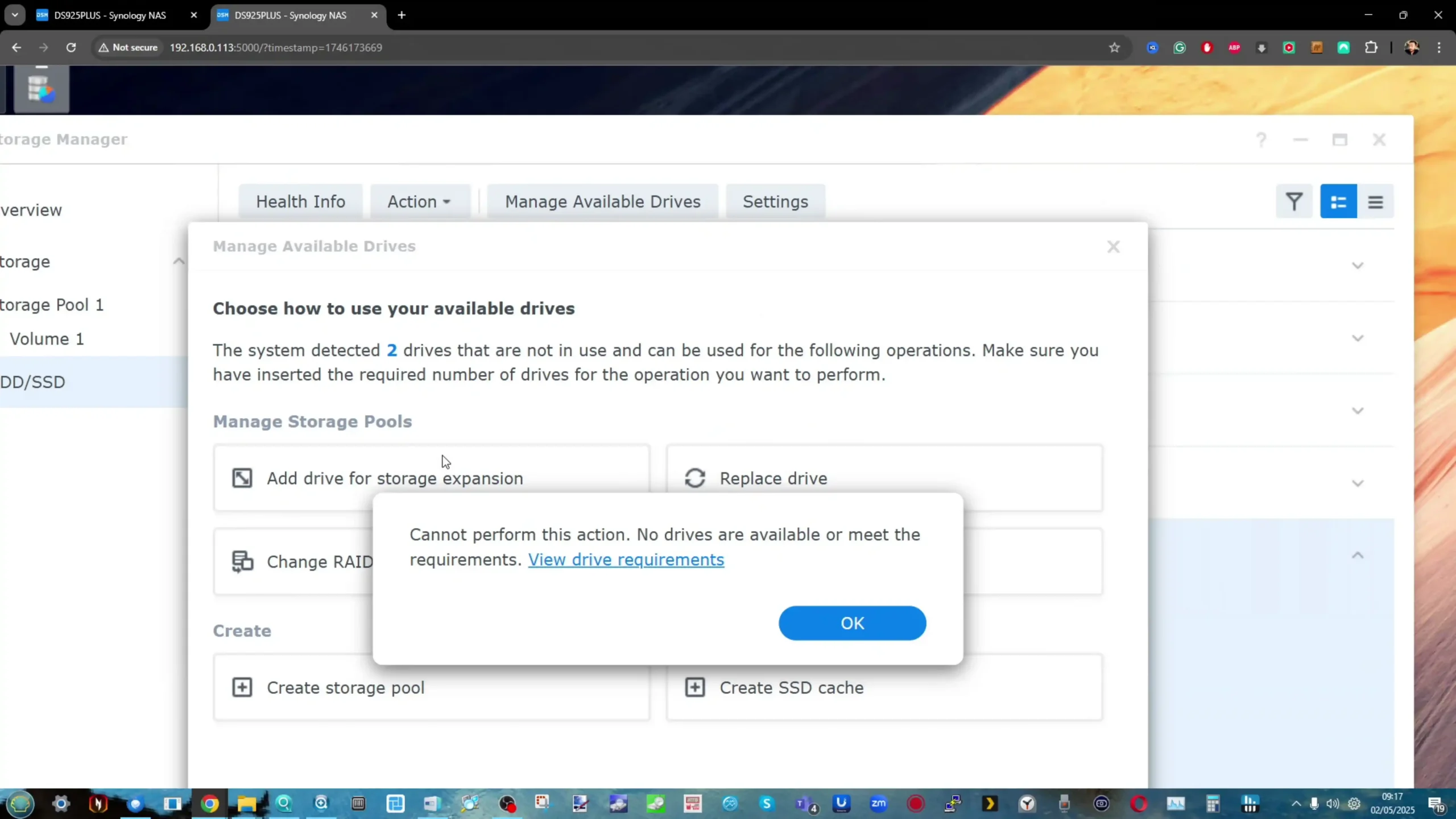 |
No doubt, as Synology rolls out more proprietary media-focused systems in their 2025 lineup and continues to expand the offering of branded storage media, the brand will eventually roll out a much more performance-rich NVMe SSD (perhaps the SNV5300 or SNV7400). But until that happens, these bays are a little restricted in terms of compatible media to really make the most of their capabilities right now.
Bottom line: for the money you’re laying down here — and if you factor in the value and quality of the software — many are going to be happy to overlook the comparatively underwhelming internal hardware on offer here when comparing it against the number of competitors on the market that focus on the hardware more than the software. If you’ve followed the brand for a long time, you’ll probably agree that what we’re seeing here is fairly standard for what this brand tends to include in their systems, and therefore you may be happy to give them a pass on this. But if this is a system that is chiefly being sold on its software and services — let’s discuss those a great deal more!
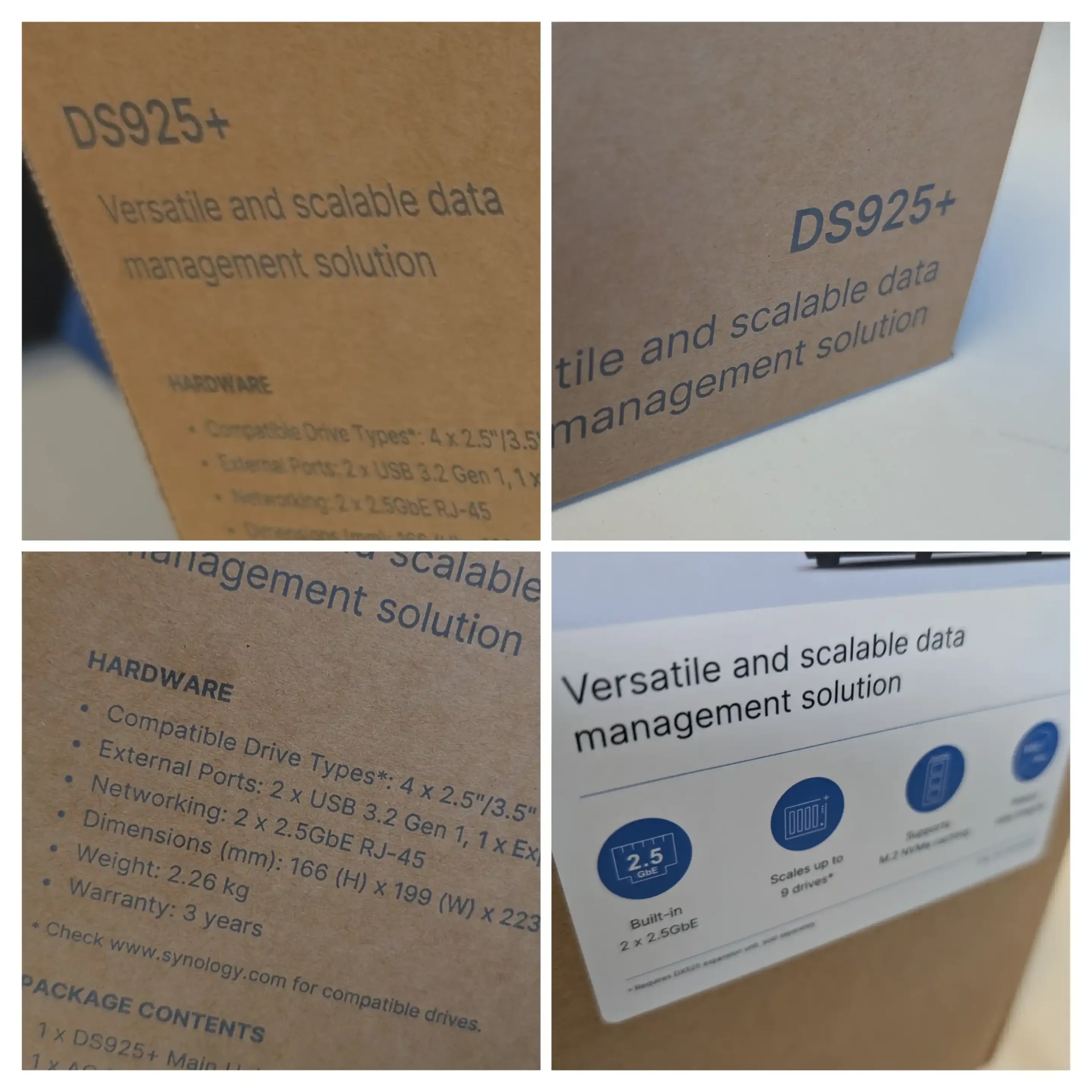
Synology DS925+ NAS Review – DSM Software and Services
The DS925+ arrives preloaded with Synology’s DiskStation Manager (DSM) 7.2, the latest version of their industry-leading NAS operating system. DSM has long been praised for its clean, intuitive interface that makes it easy for even novice users to get started while still offering deep functionality for IT professionals. Everything from user account creation, network configuration, file sharing, and app management is presented through a streamlined browser-based GUI. It’s an OS that feels more like a well-polished desktop environment than a traditional NAS UI, and the DS925+ handles it with ease thanks to its Ryzen CPU and ECC memory.
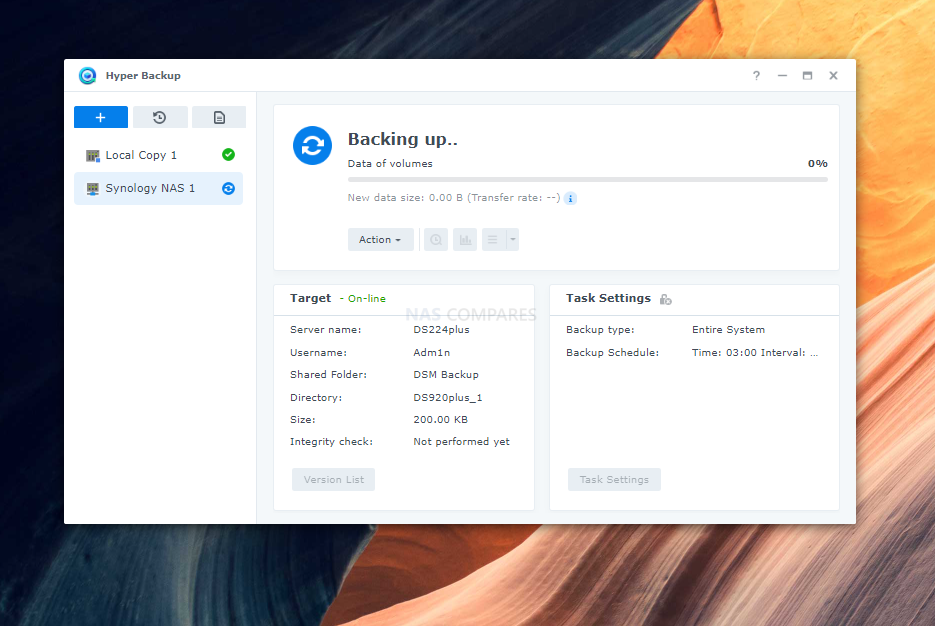 |
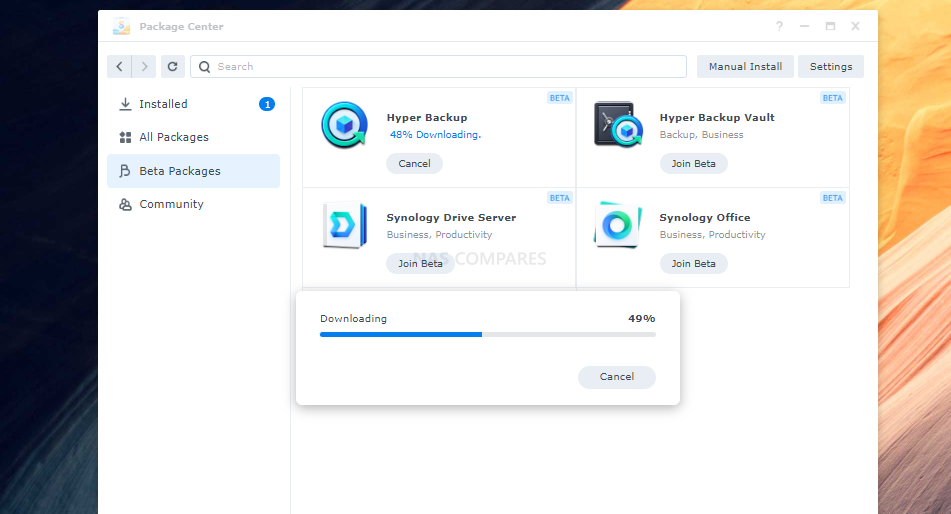 |
DSM offers comprehensive file management through File Station, and supports standard protocols such as SMB, FTP, WebDAV, and Rsync. Whether you’re accessing files locally or remotely, the experience is responsive and customisable. File previews, right-click menus, and in-browser streaming of media files all work out of the box, while features like folder-level encryption, WORM (write once, read many), and fine-grained user permissions ensure strong data governance. The included Synology Drive application further enhances file syncing and backup capabilities across multiple platforms — Windows, macOS, Linux, Android, and iOS.
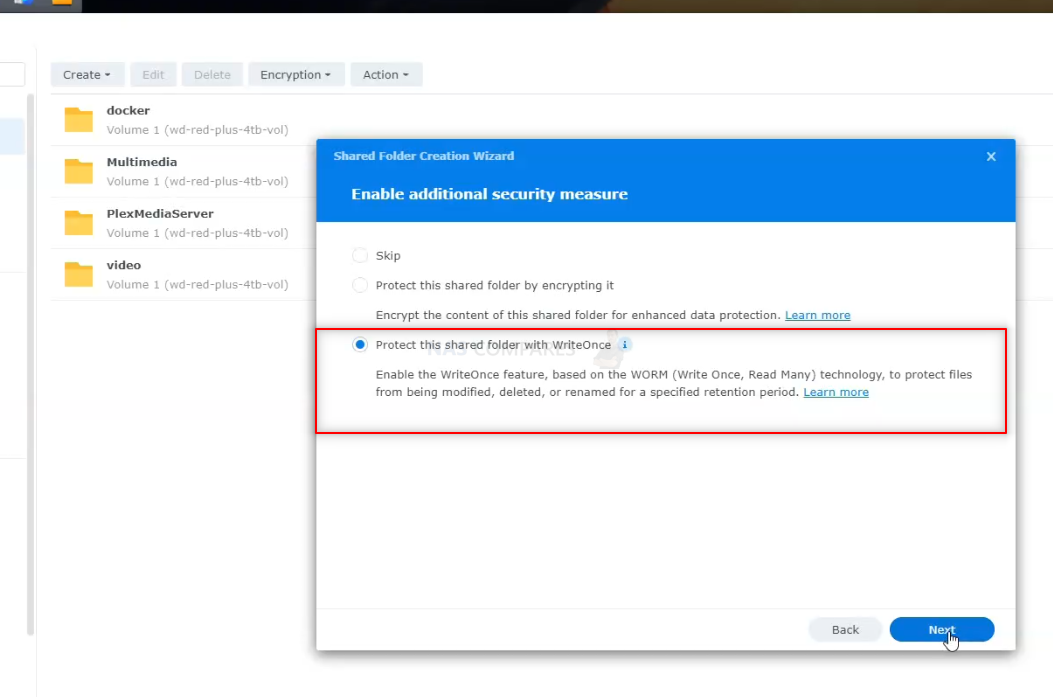 |
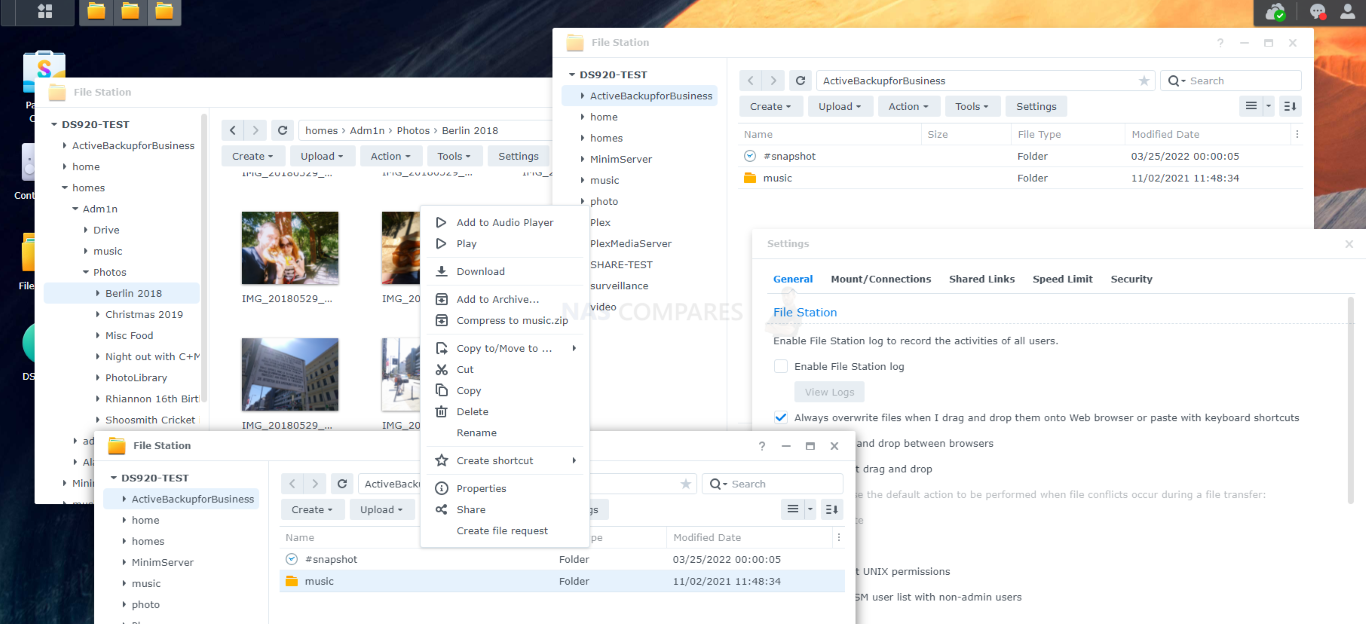 |
Synology has also baked in powerful backup and disaster recovery tools into DSM, with Active Backup for Business standing out in particular. It supports full OS and file-level backups for Windows, Linux, virtual machines, SaaS apps like Microsoft 365 and Google Workspace, and even other NAS devices.
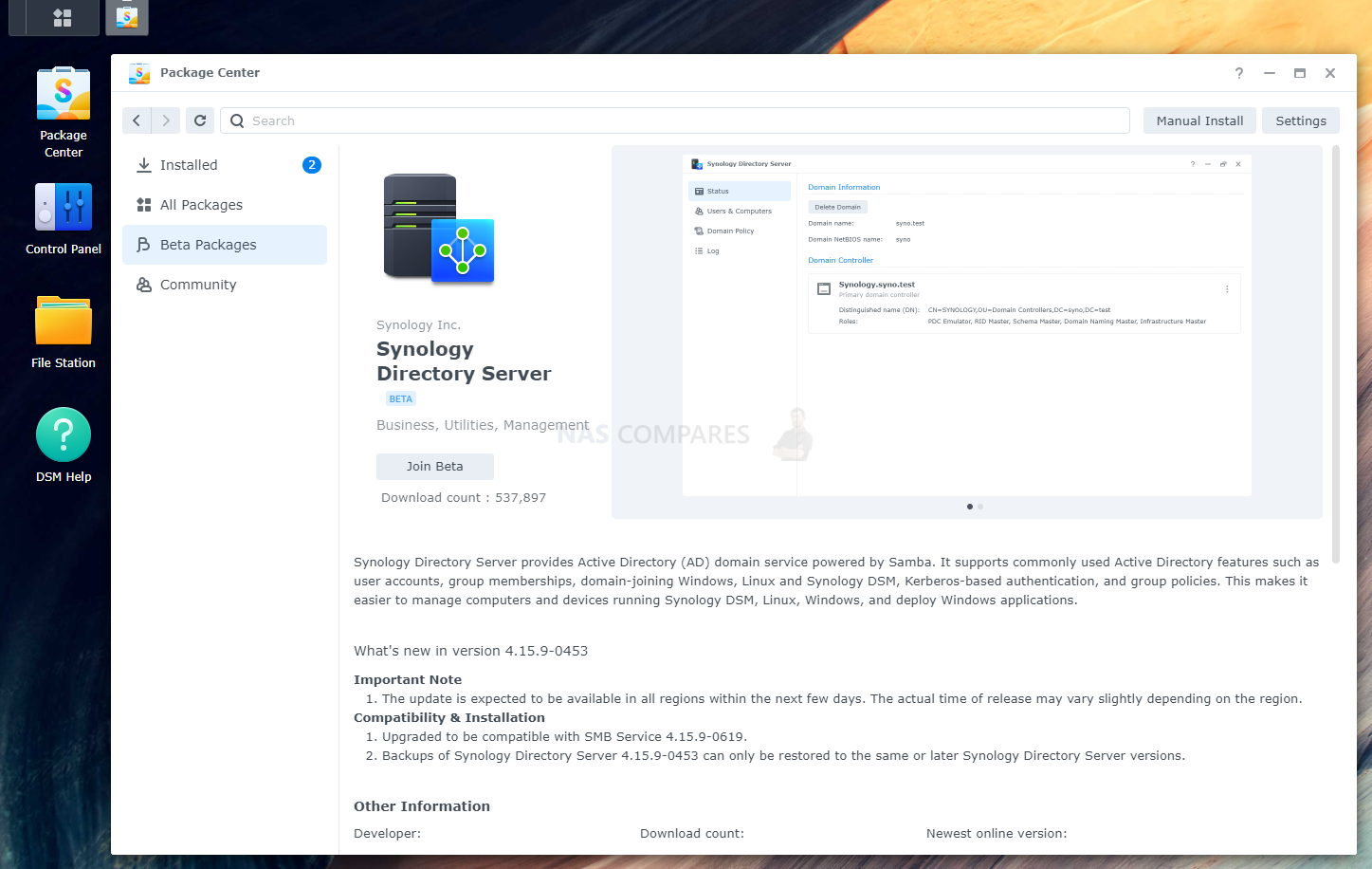 |
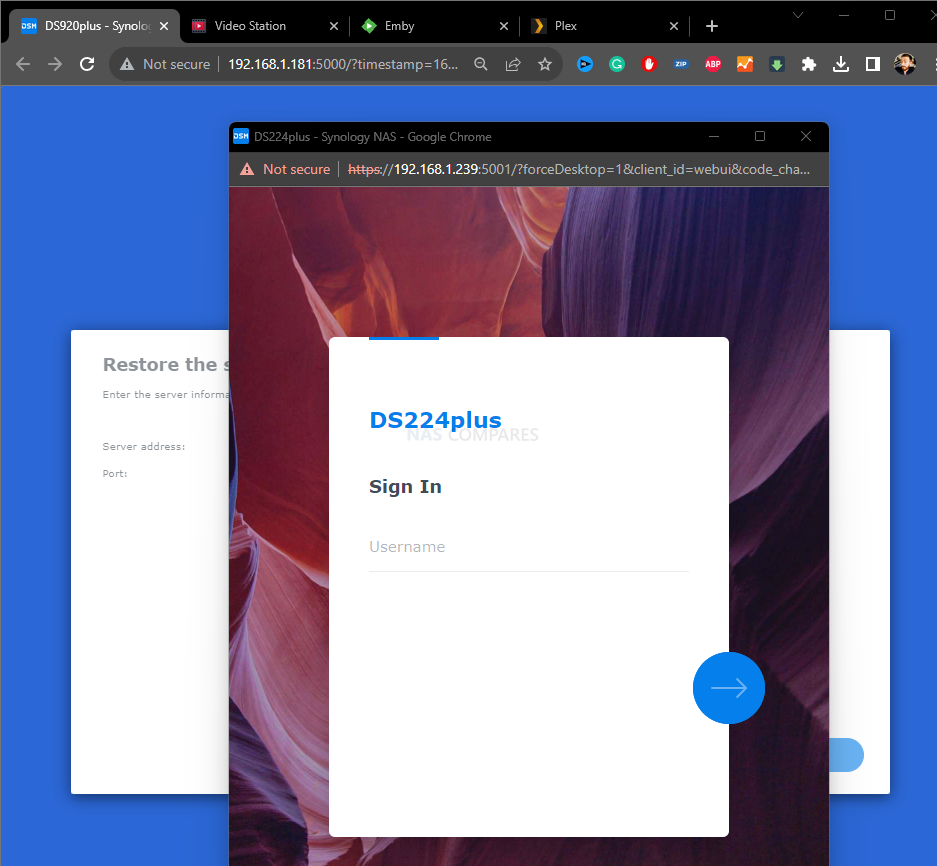 |
Best of all, it requires no additional licenses for most features. Hyper Backup provides flexible multi-destination backup options, while Snapshot Replication protects against ransomware or accidental deletions by allowing near-instant recovery of shared folders or entire volumes.
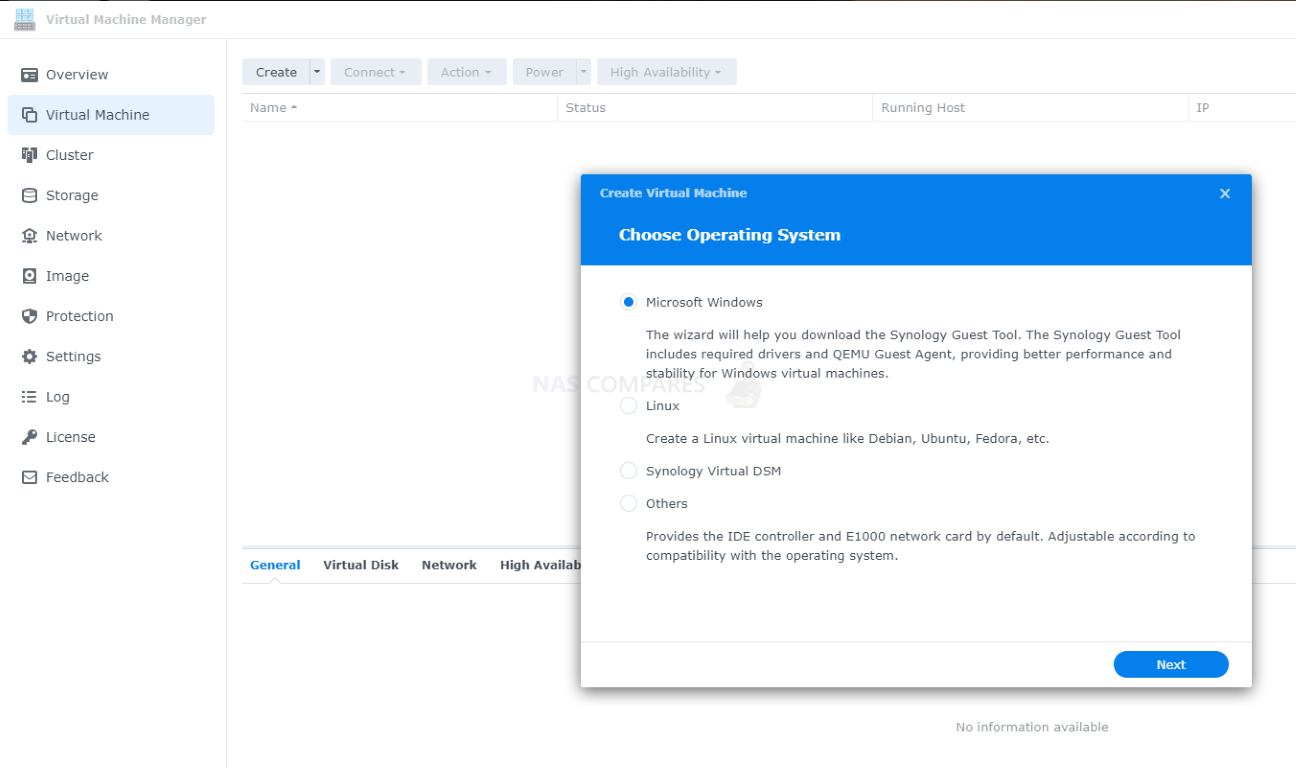 |
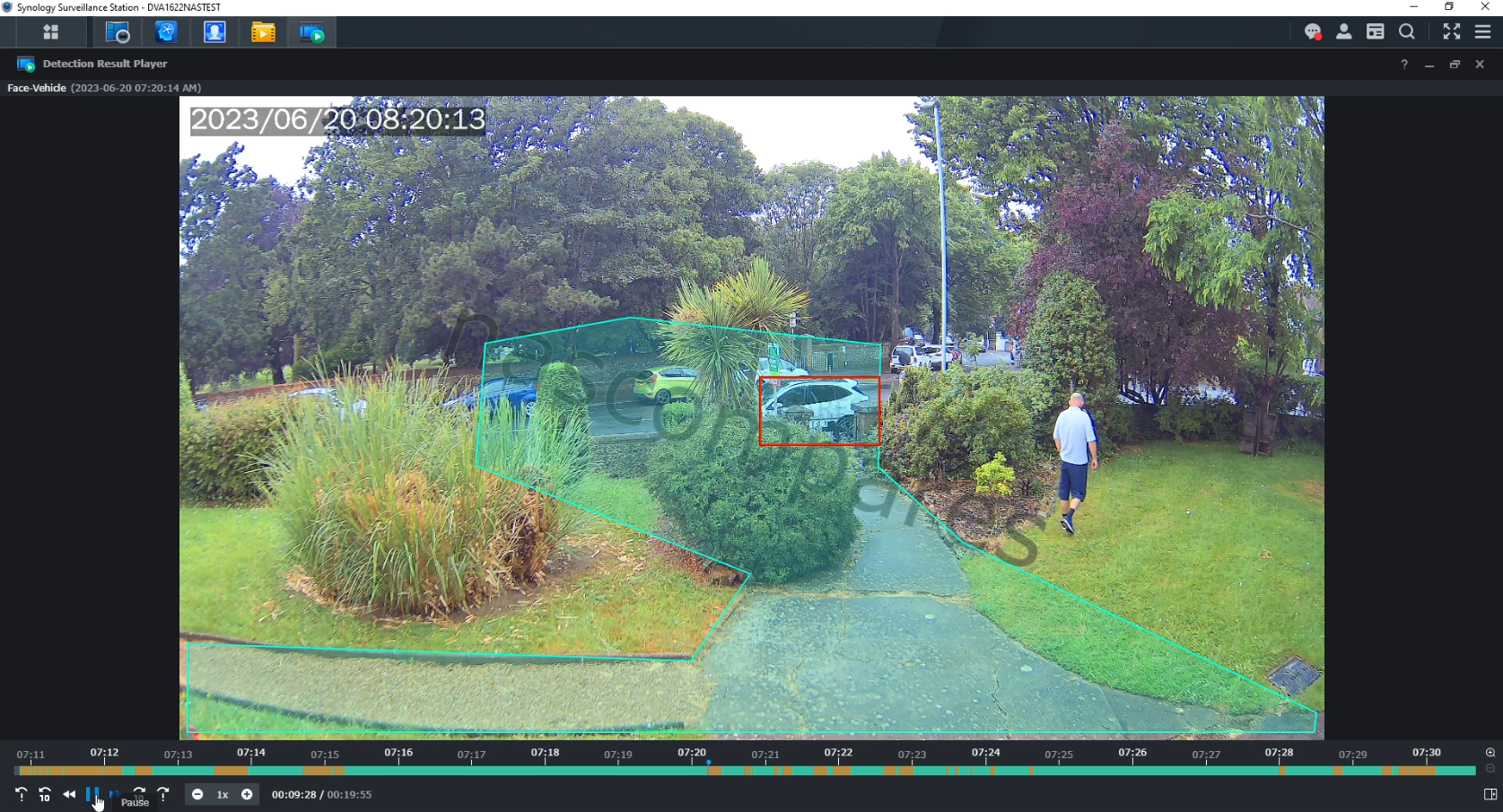 |
For users focused on multimedia, DSM supports apps like Synology Photos, Audio Station, and Plex Media Server. While Synology has scaled back some native media tools like Video Station, DSM remains highly compatible with third-party platforms. Container Manager and Virtual Machine Manager allow for lightweight app deployment and virtualisation without a license fee — with the DS925+ capable of running multiple Docker containers or virtual DSM instances simultaneously. Synology’s mobile apps also tie in seamlessly with DSM services, offering secure access to files, surveillance feeds, photo backups, and more.
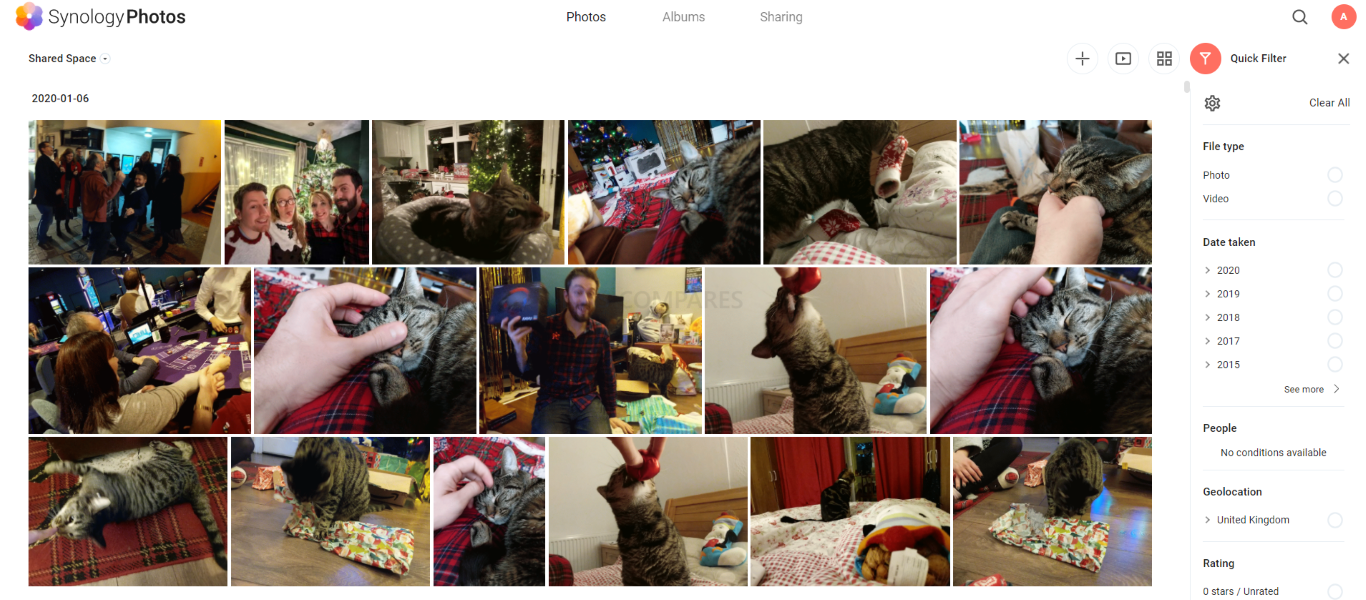 |
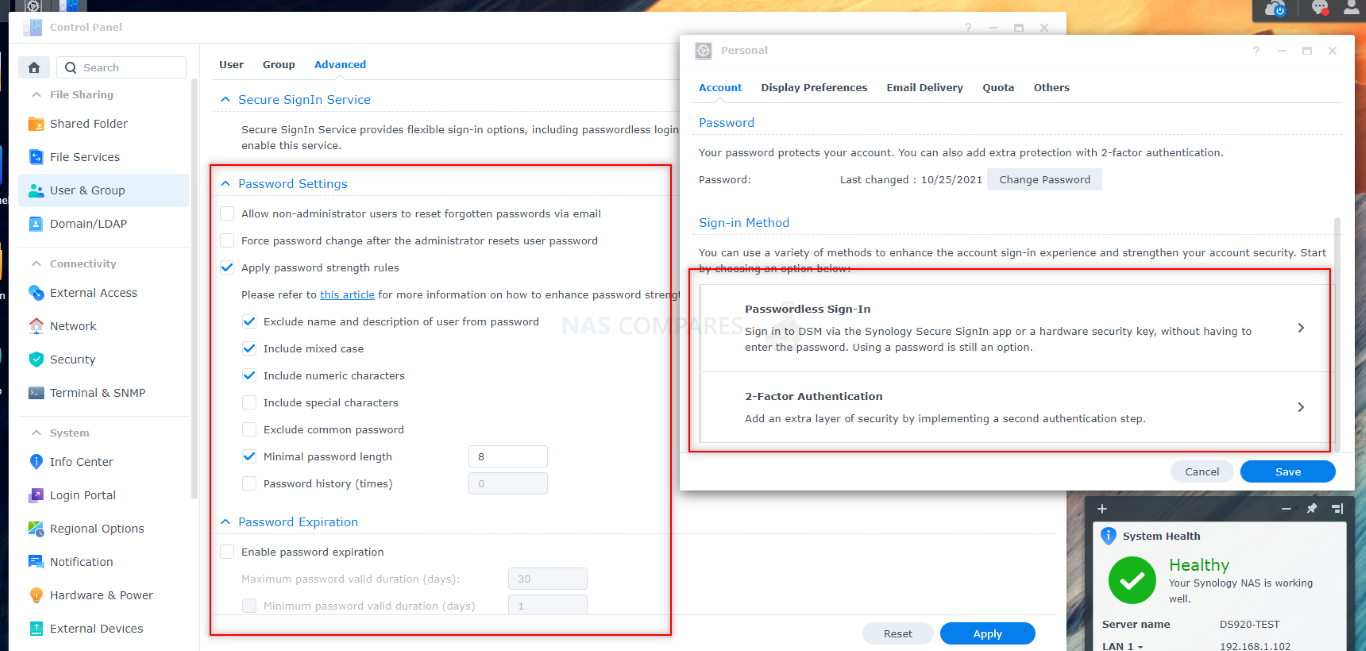 |
Ultimately, DSM is the DS925+’s strongest asset. Synology’s software-first approach continues to pay off, delivering an experience that’s miles ahead of most competitors in terms of polish, security, and integration.
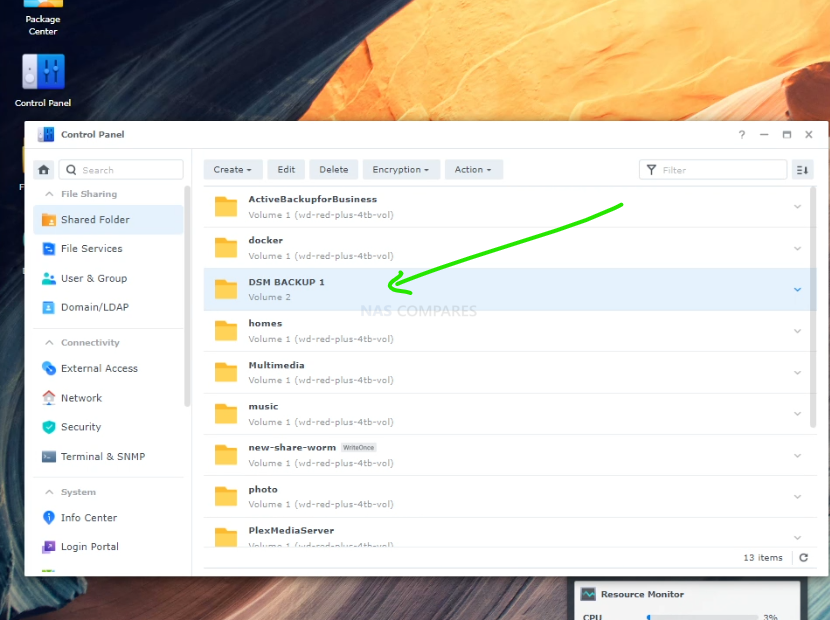 |
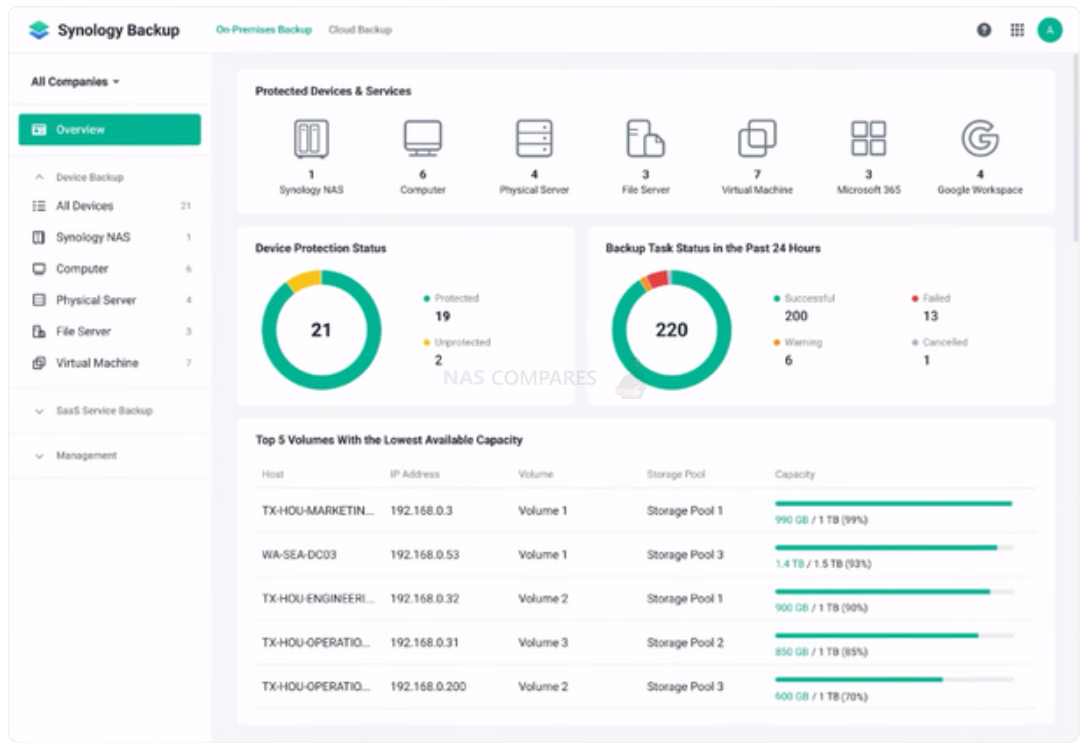 |
Whether you’re a home user setting up private cloud storage or a small business deploying multi-site backups, DSM remains the gold standard in NAS operating systems. For many users, the value of DSM alone justifies choosing Synology — even when hardware compromises or compatibility limitations exist.
 |
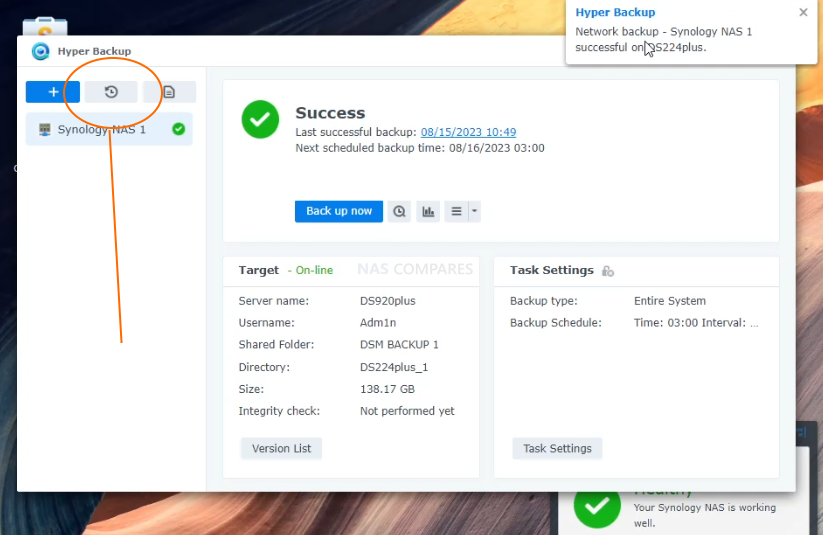 |
Below is a breakdown of how the Synology DS925+ improves upon the software and service support of the DS923:
| Category | DS925+
|
DS923+
|
Advantage / Notes |
|---|---|---|---|
| Max Single Volume Size | 200 TB (with 32 GB RAM) / 108 TB | 108 TB | DS925+ supports up to 200 TB with RAM upgrade |
| Max Internal Volume Number | 32 | 64 | DS923+ allows more volumes |
| M.2 SSD Storage Pool Support | Yes | Yes | – |
| SSD Cache / TRIM | Yes / Yes | Yes / Yes | – |
| Supported RAID Types | SHR, Basic, JBOD, RAID 0/1/5/6/10 | SHR, Basic, JBOD, RAID 0/1/5/6/10 | – |
| RAID Migration Support | Yes | Yes | – |
| Volume Expansion (Larger Drives / Add HDD) | Yes | Yes | – |
| Global Hot Spare RAID Support | Yes | Yes | – |
| Internal File Systems | Btrfs, ext4 | Btrfs, ext4 | – |
| External File Systems | Btrfs, ext4, ext3, FAT32, NTFS, HFS+, exFAT | Btrfs, ext4, ext3, FAT32, NTFS, HFS+, exFAT | – |
| File Protocols Supported | SMB, AFP, NFS, FTP, WebDAV, Rsync | SMB, AFP, NFS, FTP, WebDAV, Rsync | – |
| Max SMB Connections (with RAM expansion) | 40 | 30 | DS925+ handles more concurrent connections |
| Windows ACL & NFS Kerberos Auth | Yes | Yes | – |
| Max Local Users / Groups / Shared Folders | 512 / 128 / 128 | 512 / 128 / 128 | – |
| Max Shared Folder Sync Tasks | 8 | 4 | DS925+ supports double the sync tasks |
| Max Hybrid Share Folders | 10 | 10 | – |
| Hyper Backup (Folder & Full System) | Yes | Yes (DSM 7.2+) | – |
| Synology High Availability | Yes | Yes | – |
| Syslog Events per Second | 800 | 800 | – |
| Virtualization Support (VMware, Citrix, etc.) | Yes | Yes | – |
| Protocols (SMB, NFS, iSCSI, etc.) | Full Support | Full Support | – |
| Supported Browsers | Chrome, Firefox, Edge, Safari | Chrome, Firefox, Edge, Safari | – |
| Languages Supported | 24+ | 24+ | – |
| Synology Chat – Max Users | 150 | 100 | DS925+ supports 50% more chat users |
| Download Station – Max Tasks | 80 | 80 | – |
| iSCSI Targets / LUNs | 2 / 2 | 2 / 2 | – |
| MailPlus – Free Accounts / Max Users | 5 / 90 | 5 / 60 | DS925+ supports more users |
| DLNA / Synology Photos (Facial & Object Rec.) | Yes | Yes | – |
| Snapshot Replication – Max per Folder / System | 128 / 256 | 128 / 256 | – |
| Surveillance Station (Default Licenses) | 2 | 2 | – |
| Max IP Cameras (H.264 – 1080p) | 40 channels / 1050 FPS | 40 channels / 1050 FPS | – |
| Max IP Cameras (H.265 – 1080p) | 40 channels / 1200 FPS | 40 channels / 1200 FPS | – |
| Synology Drive – Max Users | 80 | 50 | DS925+ supports 60% more users |
| Synology Drive – Max Files Hosted | 500,000 | 500,000 | – |
| Synology Office – Max Users | 80 | 50 | DS925+ supports more office users |
| Virtual Machine Manager – VM Instances / DSM Licenses | 8 / 8 (1 Free) | 4 / 4 (1 Free) | DS925+ supports 2× more virtual instances |
| VPN Server – Max Connections | 8 | 4 | DS925+ supports 2× more connections |
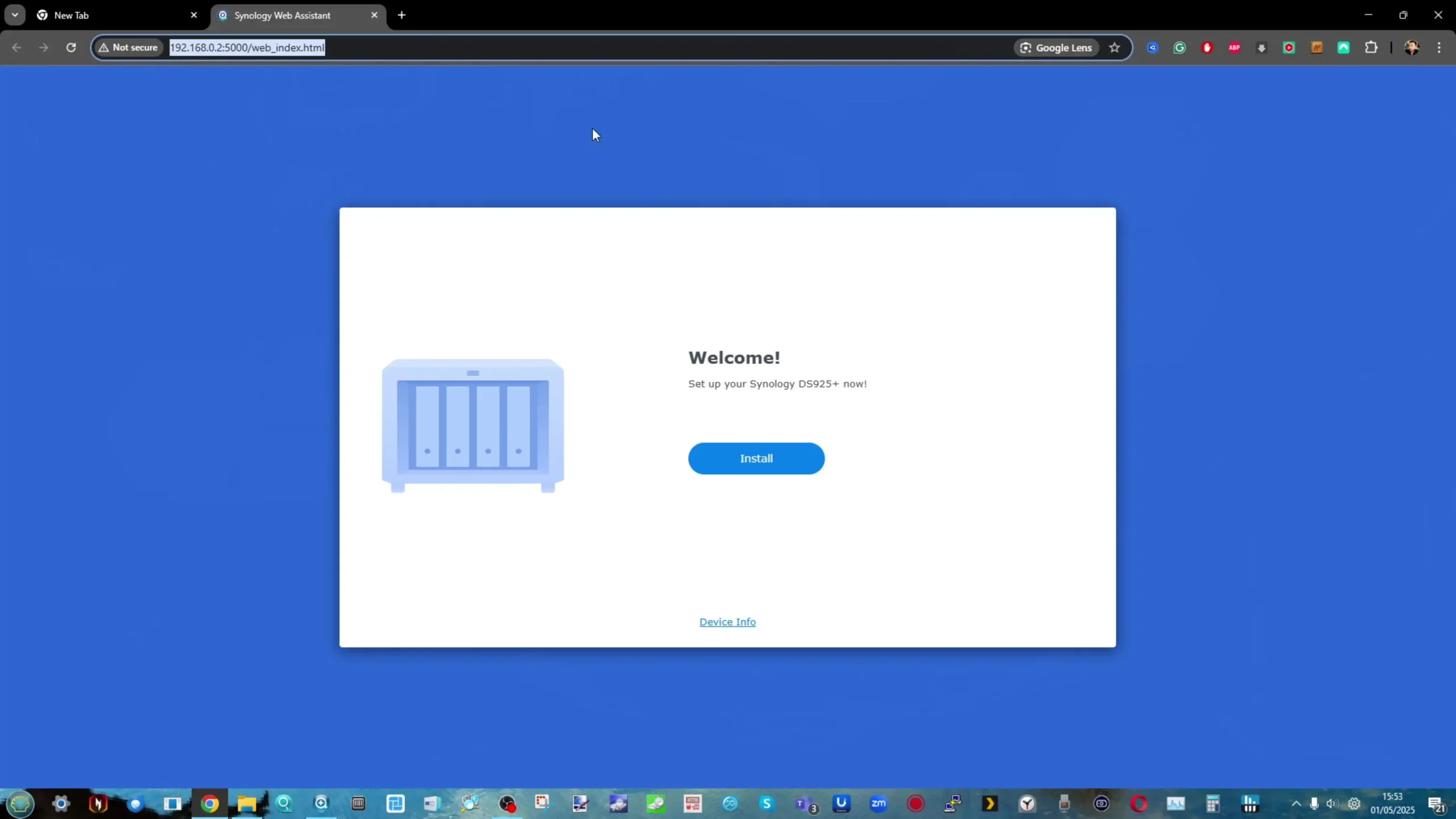
Synology DS925+ NAS Review – Storage and Compatibility
At the time of writing this review, Synology is seemingly waging a war on third-party drives being used inside their systems. Back in 2020/2021, Synology began rolling out their own range of storage media for use in their systems — starting with SSDs and eventually expanding to a range of 3.5-inch server-class and enterprise storage-class hard drives. Over the years, we have seen the brand begin to reduce the number of third-party drives listed as certified and verified for use in the DSM platform and in their NAS server devices. This duality — of promoting their own storage media while supporting third-party drives — has had its balance shifted considerably over the last two major Synology generations and across several updates in DSM.
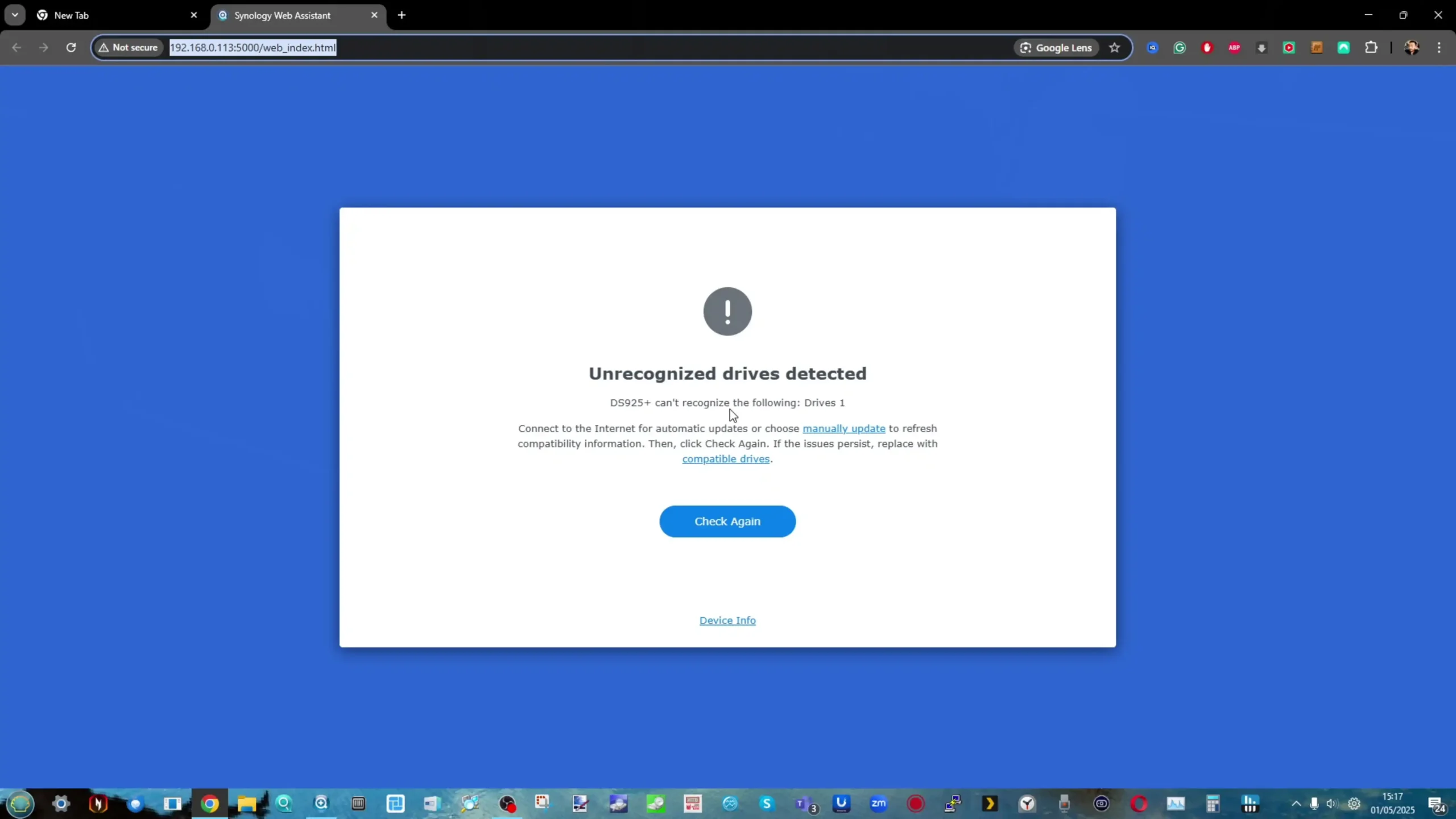
In 2022, when the brand rolled out an update in DSM 7.1 that changed the system status for any NAS using non-Synology-approved drives to display a warning state, the wider Synology user base was in uproar — whether it was because they didn’t like the brand’s position on dictating which drives worked and which didn’t, or because, as a system integrator or admin, they suddenly had a bunch of clueless users complaining that the system had gone from green to amber. Synology would eventually roll this back and, although they never reversed the policy of warning users that their drives were not on the compatibility list, they did soften the system’s response. Fast forward to now, and the brand is again changing its third-party drive verification and compatibility methodologies internally. The 2025 series and onward will strictly require drives that are already listed on Synology’s compatibility list. So why is that a problem right now?
Well — twofold. First, right now only Synology HDDs and SSDs are listed on the official DS925+ compatibility pages, despite the hardware inside the DS925+ being identical to previous Synology hardware from both the 2020 and 2023 generations — both of which still list many Seagate, Western Digital, Toshiba, Samsung, Kingston, and more drives. That does look a little off.
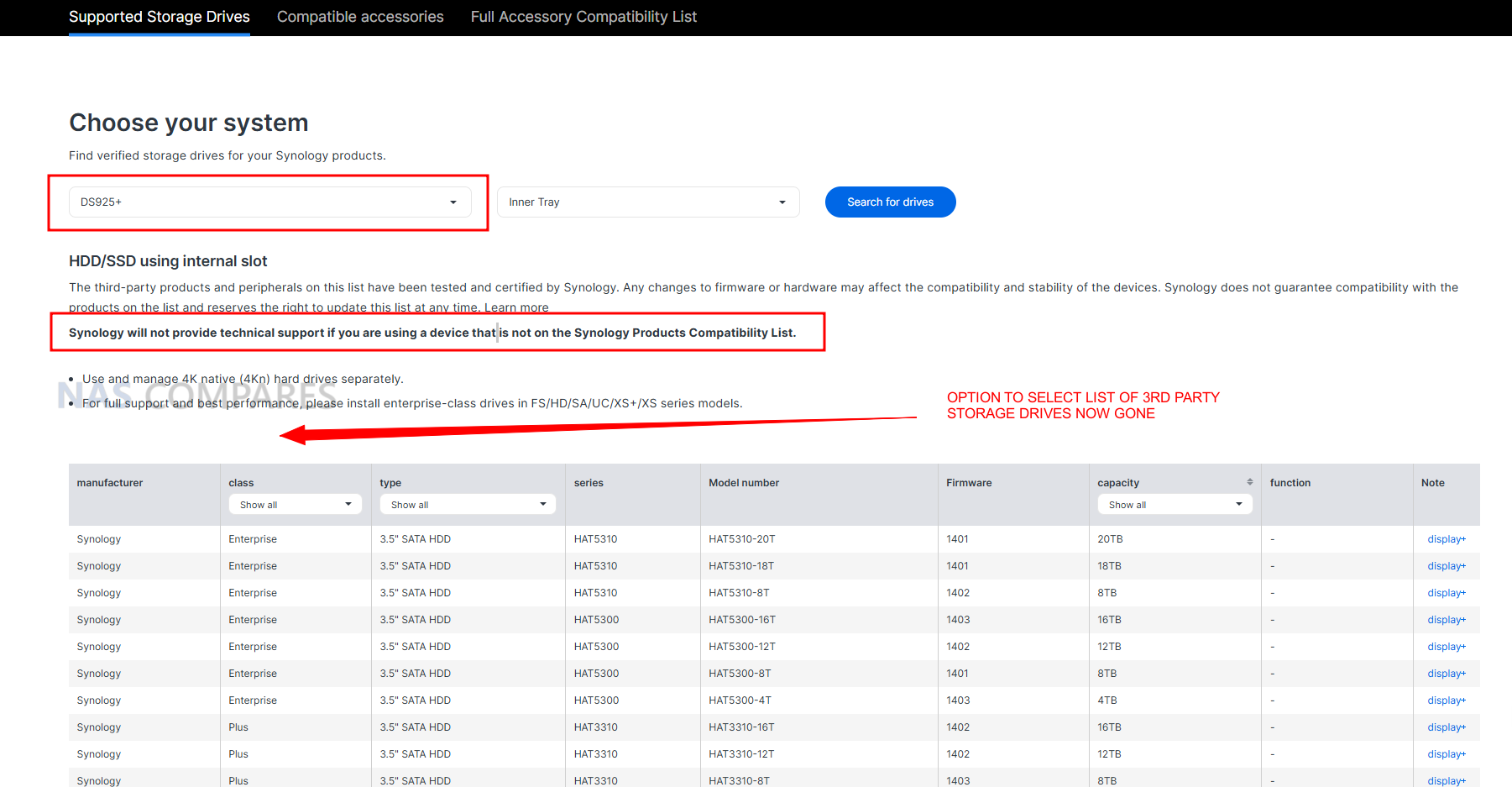
But the second, more serious reason is Synology’s aggressive approach to this policy. Previously, if you used an unverified drive, the system would warn you in Storage Manager after setting up DSM, informing you that the drives were not verified by Synology and that using them might put your system in an unsupported state — potentially limiting any after-sales or technical support the brand could offer. The 2025 series, however, currently will not even allow you to initialise the system out of the box if you are using non-Synology hard drives.
This will no doubt be problematic with e-retailers and online dealers — unless they make this strict compatibility policy exceptionally clear. The rollout of these changes across the 2025 series has been inconsistent and unclear at best. It first emerged via a press release on Synology’s German website, despite now being mentioned in different areas of global Knowledge Centers. Even now, as I write this review, although the official Synology DS925+ page is live, the wording surrounding unverified drives and their support on this new system remains very diplomatic and vague.
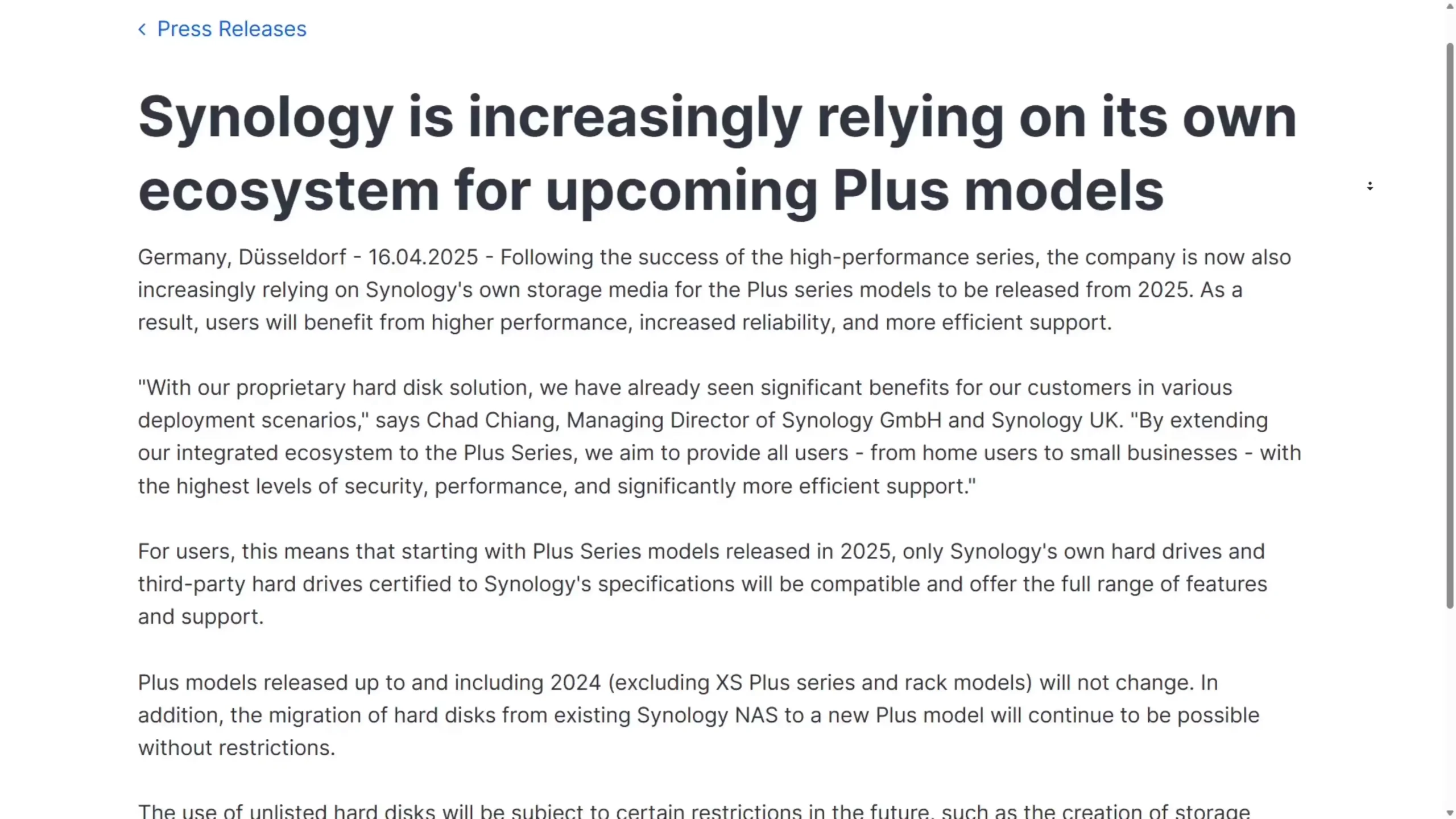
It might well be that weeks or months from now, as this system rolls out, the list of drives supported on the Synology DS925+ and other NAS systems in the 2025 series will eventually include third-party drives from WD and Seagate. Nevertheless, the messaging has been profoundly unclear and inconclusive. Synology has always supported third-party drives in numerous systems before this one — systems that, as mentioned earlier, have exactly the same hardware as this system and run the latest version of DSM as well! If their verification and compatibility tests have changed, they need to make this a great deal clearer and more justifiable to users. If they have numerous reported cases of unverified drives wreaking havoc, they need to share these results.
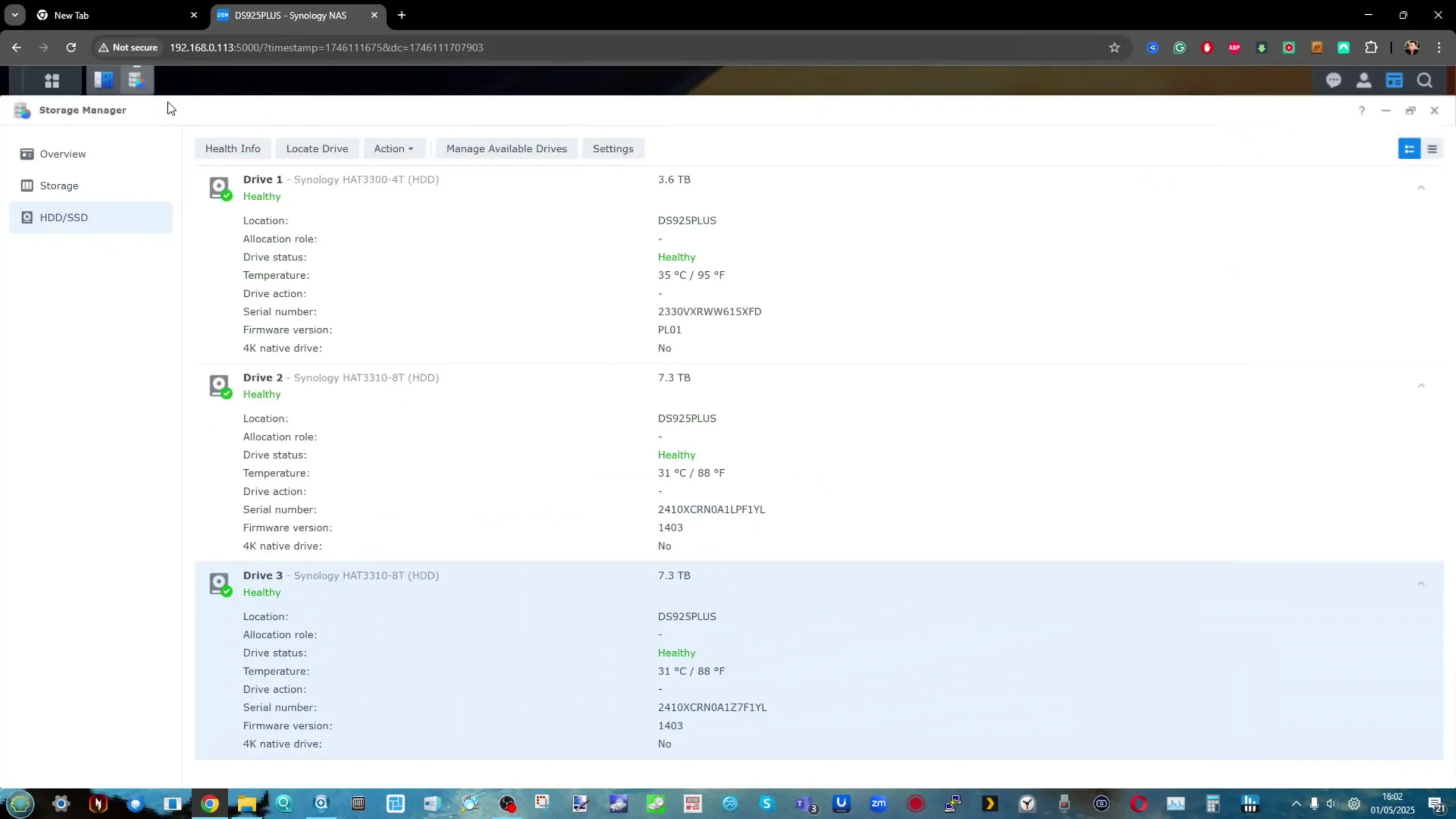
On the flip side, many could argue that as long as Synology provides a range of hard drives and SSDs that are comparable in price and performance to those of third parties, then losing access to third-party drives is no big deal. Unfortunately, that is not globally true. While there are some examples of Synology media being at the same price and performance level as third-party options, the availability and pricing for these drives is nowhere near as consistent as those of third-party brands — and for many, that forms one of the greatest long-term issues for their storage.
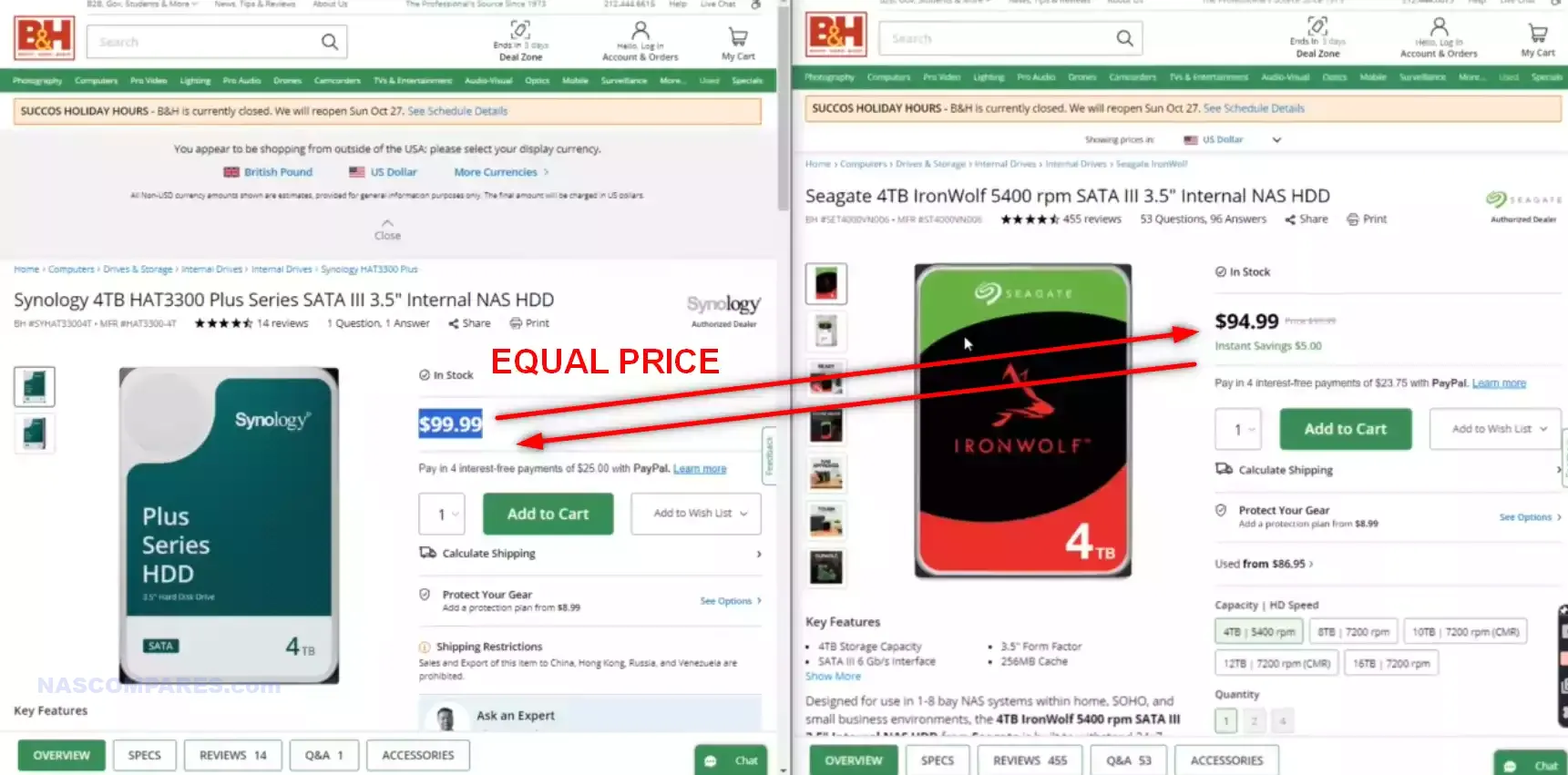
If you have an existing Synology NAS that is using third-party hard drives, you are still able to migrate drives over to the new system physically. This will allow for an easy upgrade path for existing users — but it’s not really a tremendous benefit for those who were considering the DS925+ as their first shiny new NAS system.
Migrating your drives physically from an older Synology NAS to a new device allows you to proceed – but with warnings
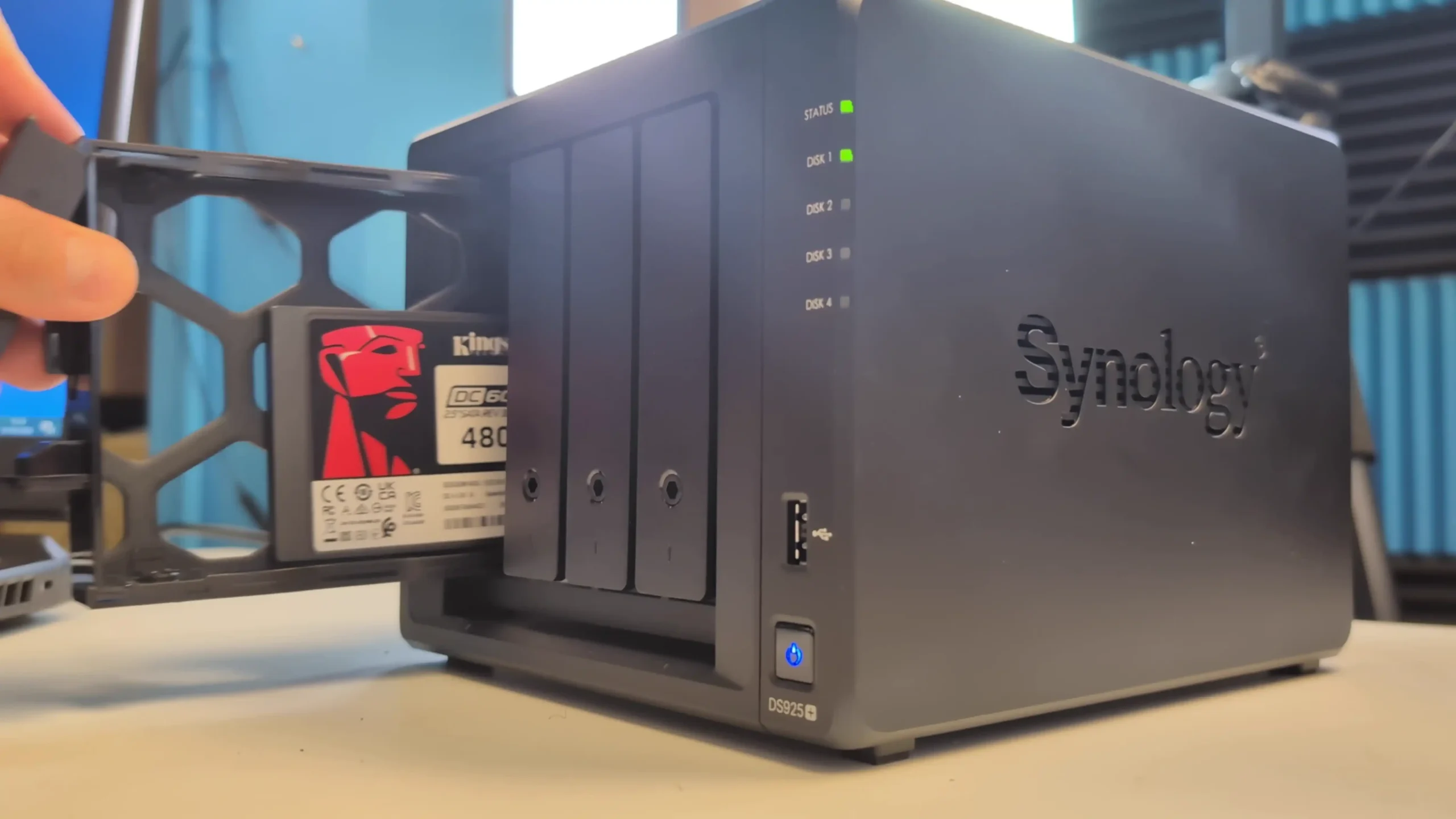 |
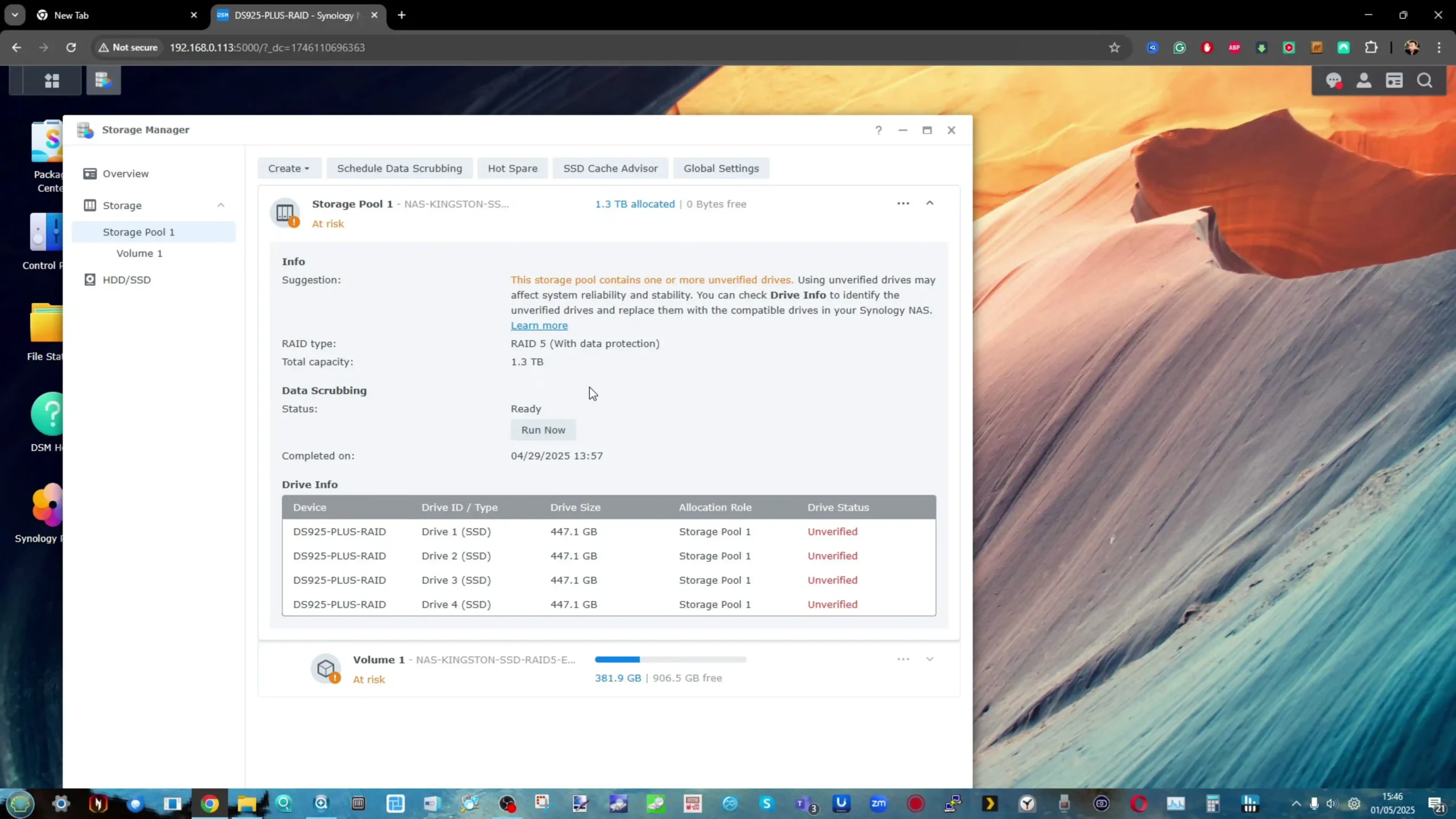 |
In discussions with numerous people online, a lot of us agree that Synology is kind of half-assing something here. If they’re going to support third-party hard drives and SSDs on their systems, then they need to do it — and do it as well as they have before. Revamping a verification system in-house that many would argue didn’t need revamping in the first place seems silly at best and calculated at worst. Otherwise, if they want to commit to recommending their own media above all else, just go the whole hog: bundle the solutions as standard, pre-populated, and maybe even extend the savings too. Interestingly, the changes in system recognition of non-listed compatible drives seems to only impact HDDs at this time. If you first-time-setup your Synology DS925+ NAS with SATA SSD(s) – you are still able to initialise the NAS as before – albeit with red and amber warnings on the storage GUI:
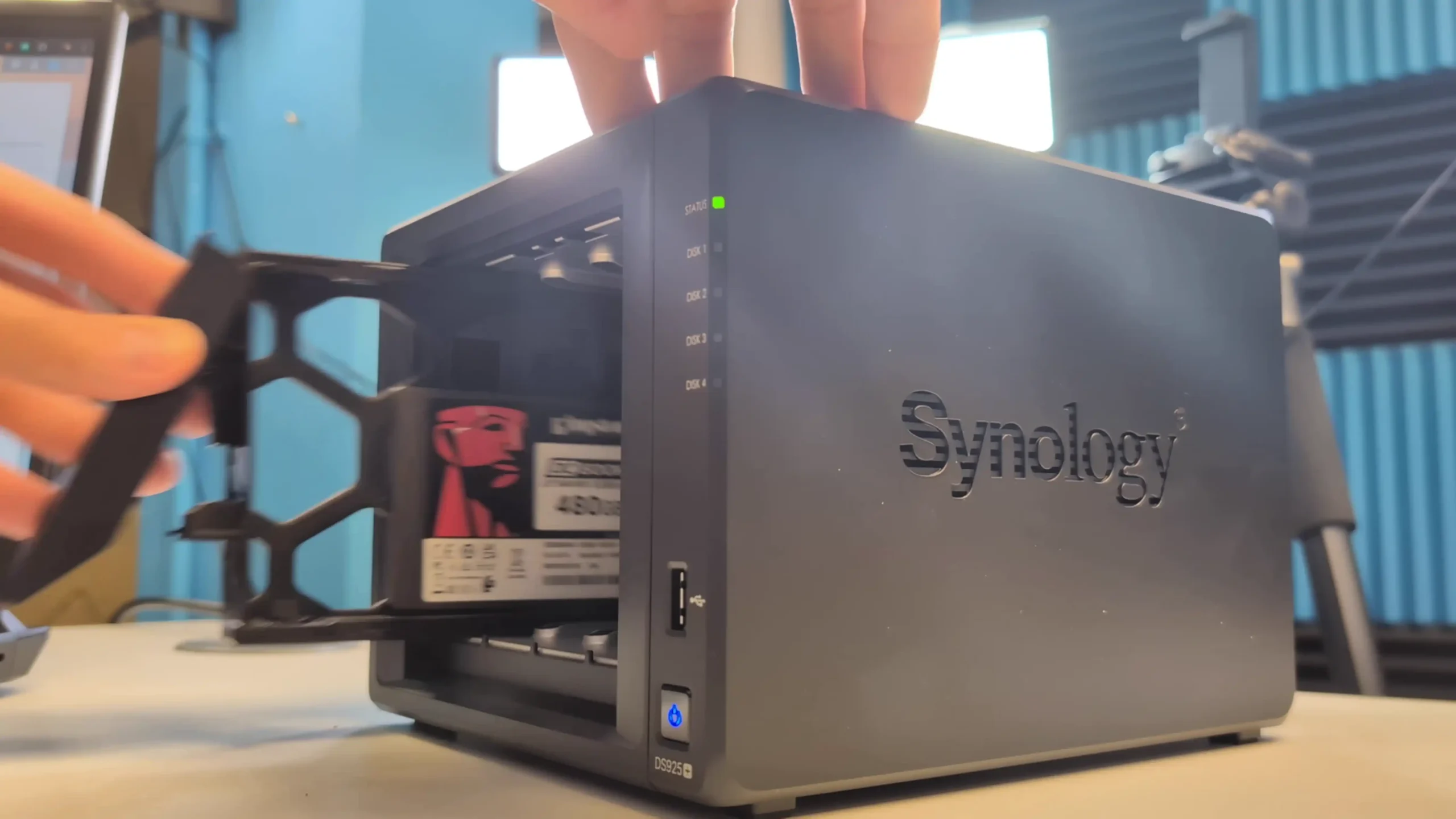 |
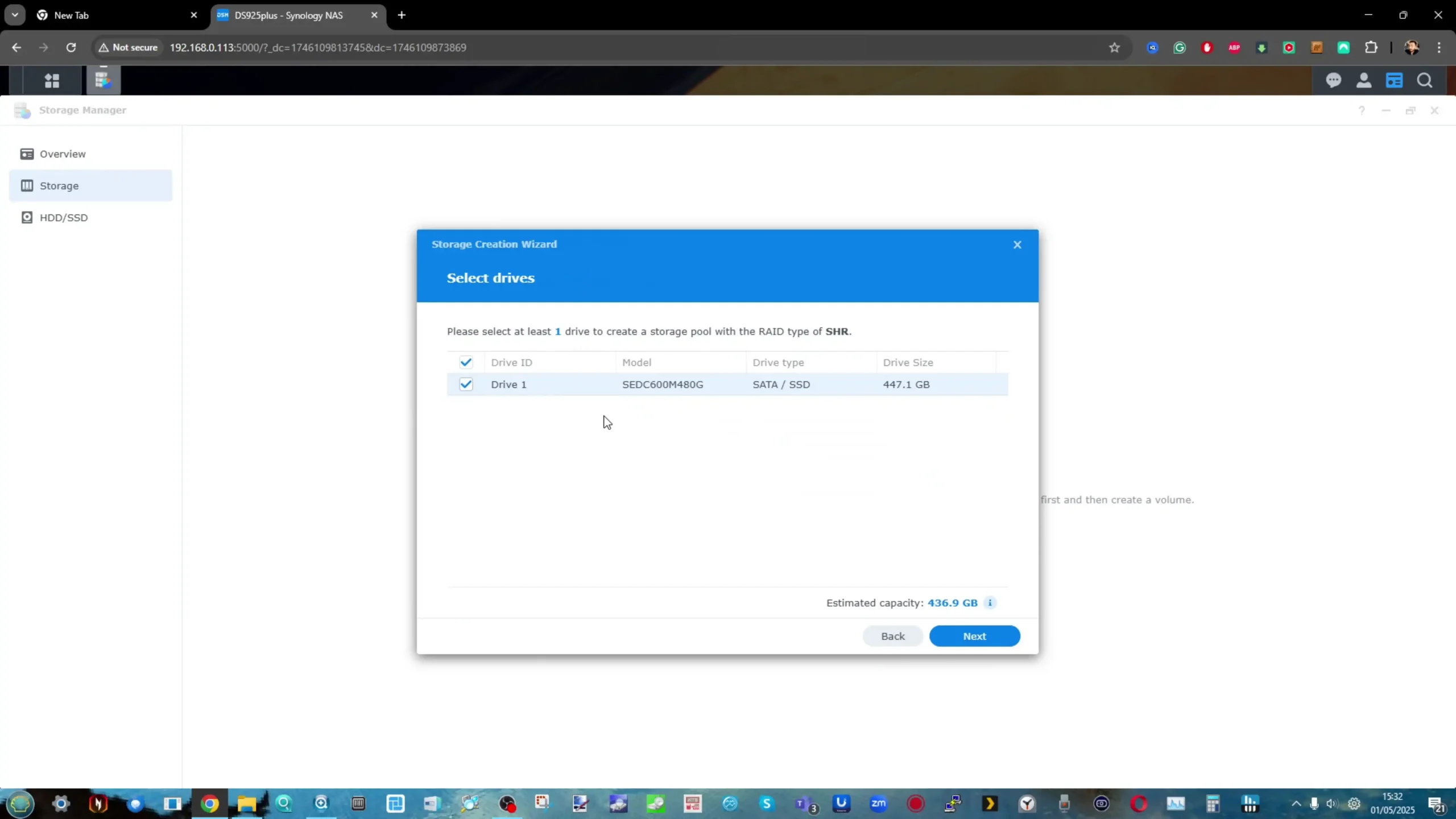 |
We’ve already seen the brand’s stance on storage media play out this way with M.2 NVMe SSDs in the 2023 generation and later — only allowing storage pool deployments if you use Synology-branded drives and no others (yet still supporting third-party drives for caching, if you like). Synology knew this was going to be an unpopular policy, but obviously, this is part of their wider roadmap. The brand themselves state that this is a move toward redefining their platform — away from being just hardware and toward becoming a full and complete data appliance.
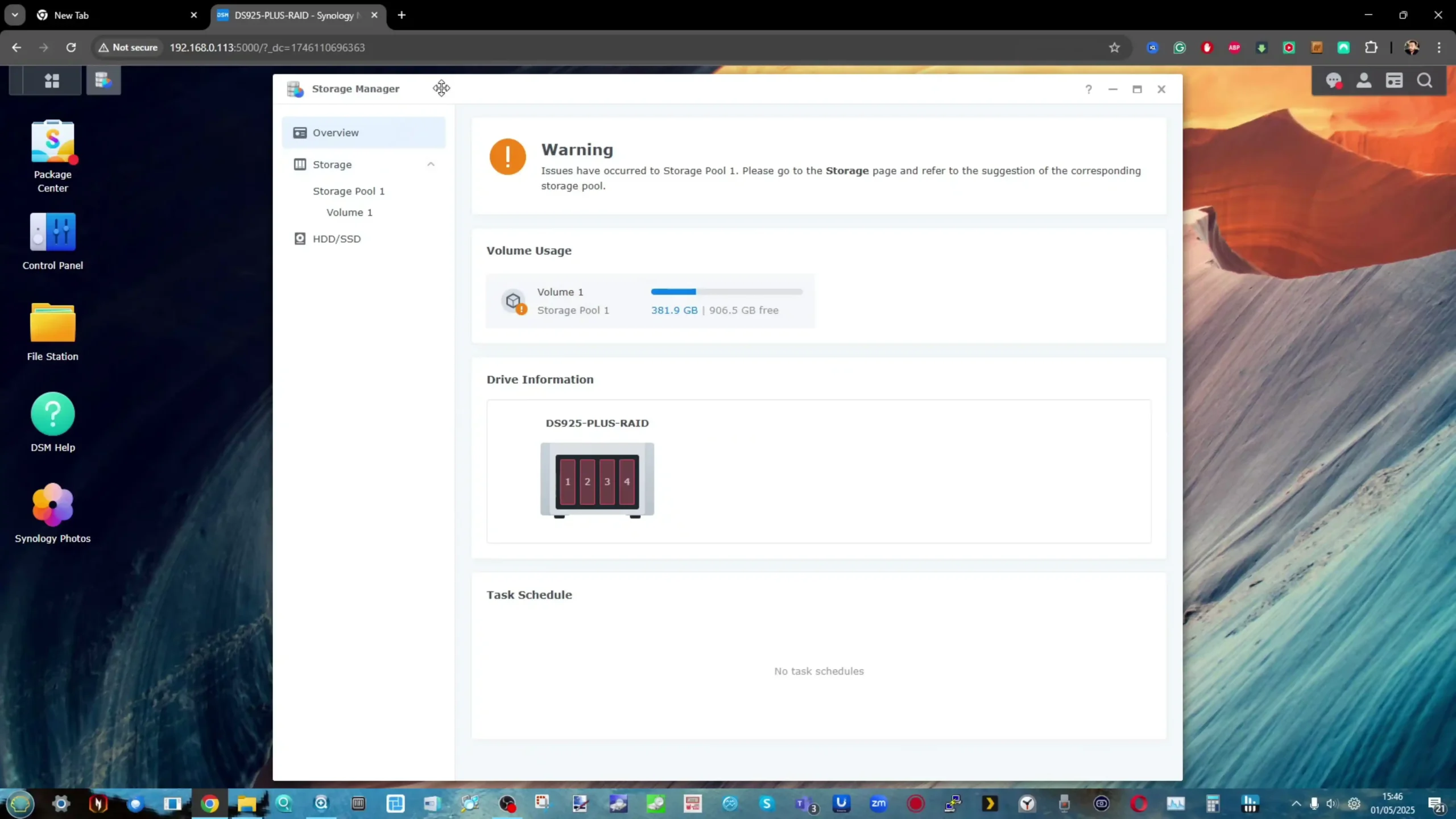
I do also want to comment on the way that the system presents the use of 3rd party drives, even when used in authorized ways (eg using SATA SSDs in initialization does NOT bar you from their use the way HDDs are when not on the compatibility pages – likewise when you use drives from an older Synology NAS via physical migration to the DS925+).
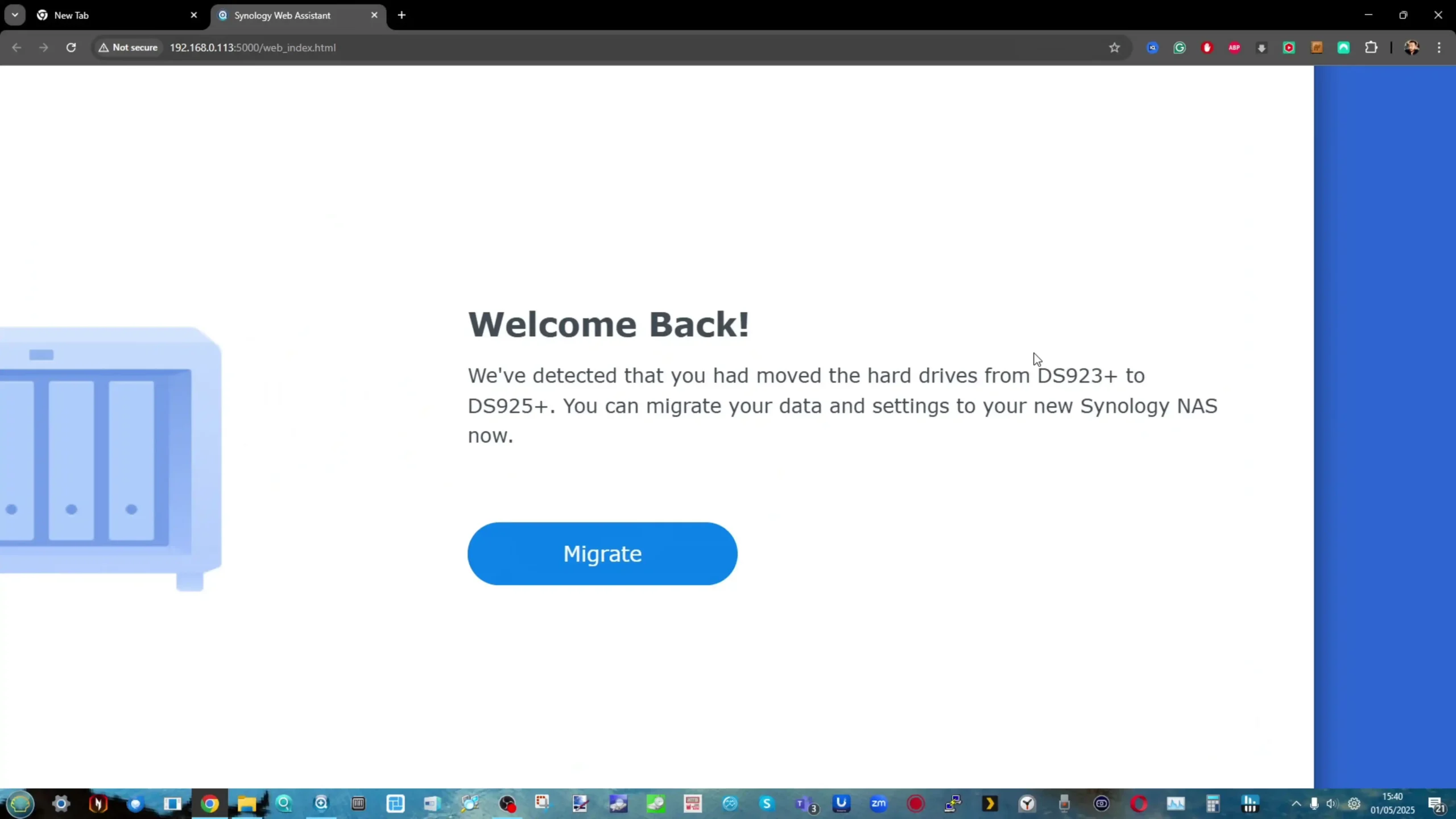
When you DO have non-synology confirmed drives in the system via these methods – the presentation of DSM is notably more negative and aggressively alarming. Red and Orange text, icons, warnings, alerts and triggering words like ‘At Risk’ are thrown around far, far too liberally.
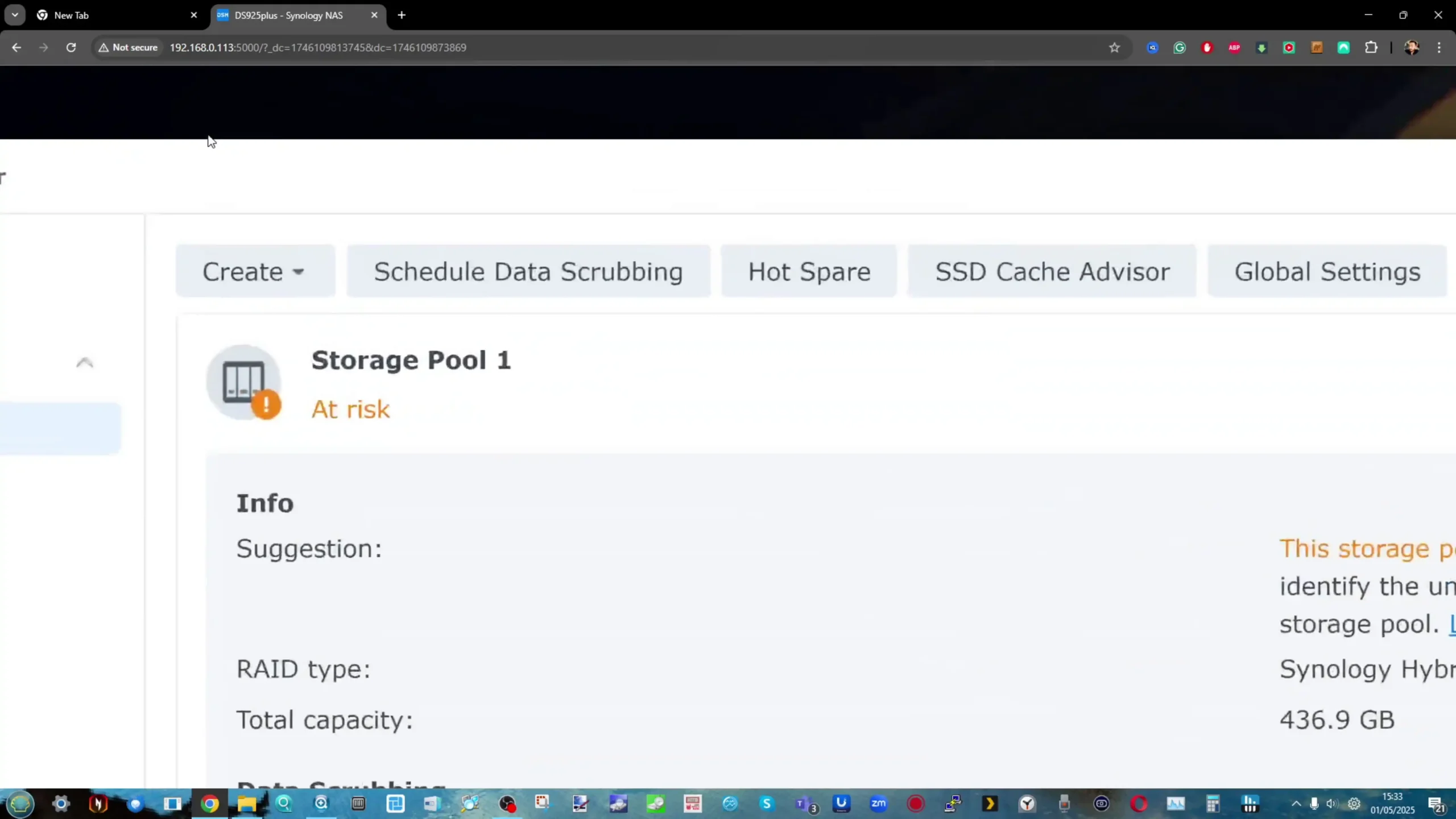
As mentioned several times, this might all turn out to be a storm in a teacup, and Synology may expedite verification of hard drives on their compatibility lists — or even U-turn on this decision entirely and pretend it never happened. Either way, a lot of users — new and old — have based significant purchasing decisions on this change by the brand.
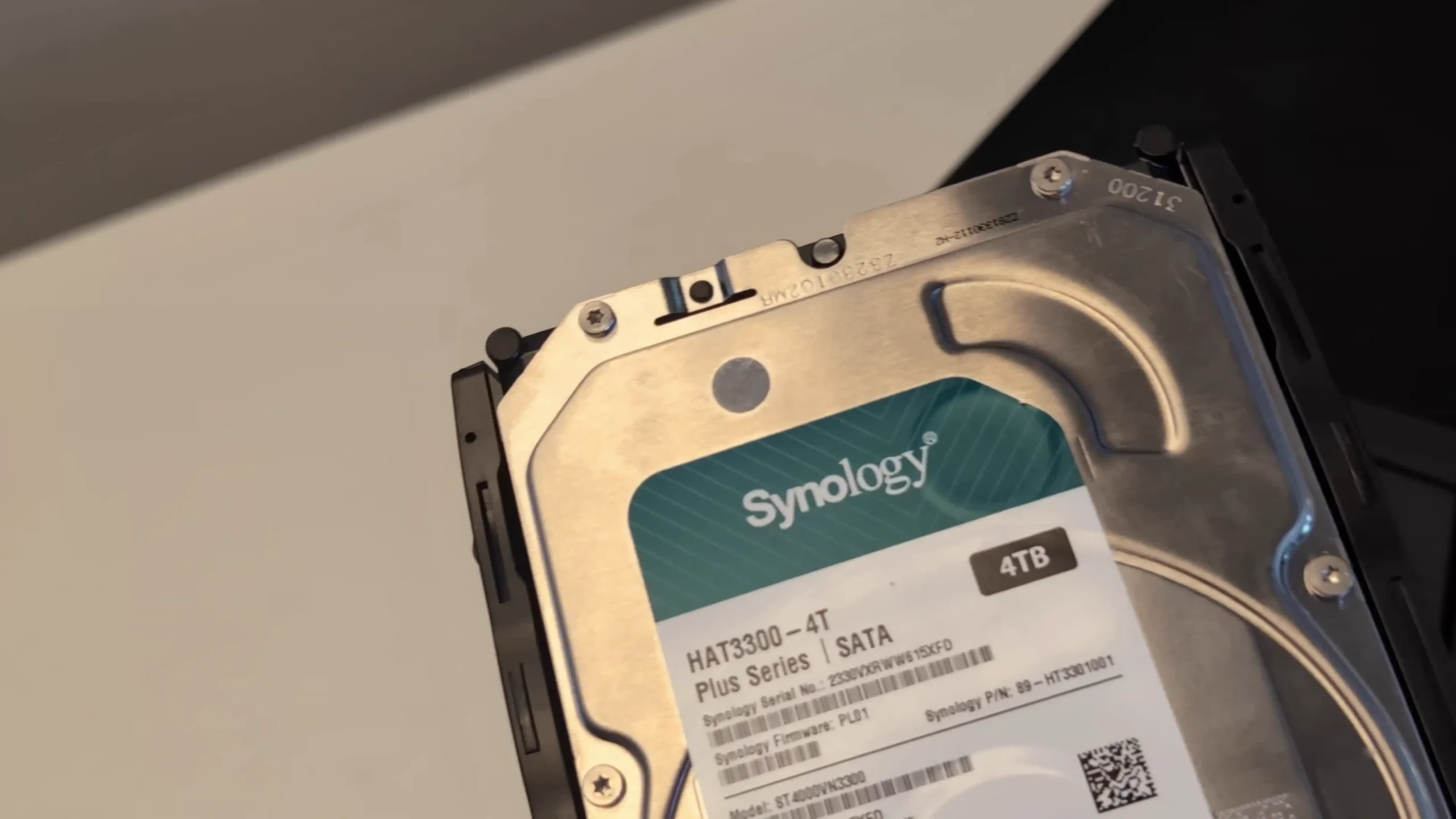
Synology DS925+ NAS Review – Conclusion & Verdict
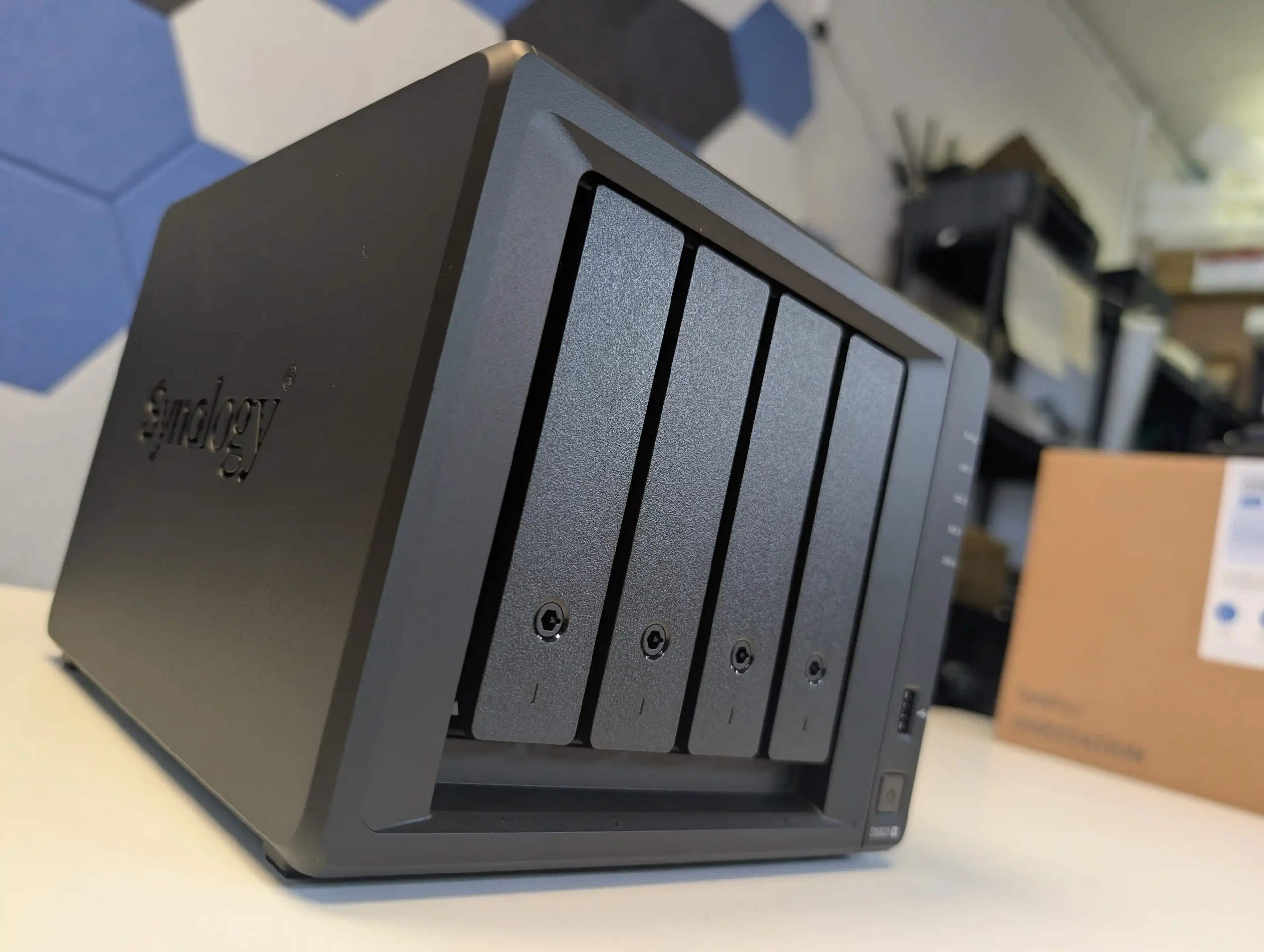
On a sheer hardware level, the Synology DS925+ is largely a superior system out of the box compared with any previous 4-bay Synology NAS solution released by the brand in this class series. Whether you’re comparing how much has scaled up in this refresh of the previous 2023 series release, or just generally looking at the standard of what you get for your money here, for the most part — in terms of hardware — it is better than the majority of systems that came before it. The long, long overdue upgrade to 2.5 GbE network connections is welcome (even if the brand is especially late to the party here). The upgrade from a dual-core, four-thread processor to a quad-core, eight-thread processor is certainly going to please those VM and app sandbox/container users greatly. And the continued implementation of ECC memory at 4GB, with scalability up to 32GB, only further doubles down on this point.
DSM continues to impress and still holds itself comfortably as the premier turnkey NAS software solution on the market — both in terms of its feature set as well as its stability and usability. The lack of 10GbE scalability is a bitter pill to swallow when many of us were just getting used to the idea of Synology engaging with 10G NIC upgrades at this hardware level. And although this feature is promised on the DS1525+, it is still something of a pain point on the DS925+ — especially now, as $25 USB-to-2.5G and 5G network adaptors are very much a thing and widely supported everywhere. But for the most part, the hardware is consistent — if a little underwhelming. Synology solutions, though, have never been about the hardware. But beyond this is where the rather curious and unpopular choices by the brand regarding storage compatibility and verification in DSM and the 2025 series in general really end up marring what could have been a very confident release by Synology in the DS925+.

I hope that months from now, this matter is just a memory, and Synology has either expedited the verification of third-party drives or reversed the majority of these decisions due to public outcry. In truth, I think a lot of users would probably have preferred the DS925+ to roll out pre-populated with storage media — much like their new BeeStation series does. Going down the road of restricting which drives people can use was never going to be popular, so either don’t do it or fully commit to it. There is, of course, the argument that these drives — which were previously verified and confirmed working on the exact same hardware (CPU, motherboards, network deployment, and software utilisation) in previous generations — have mystically now been deemed unverified on the new 2025 series and its genuinely identical hardware to what came before. It’s an odd line in the sand to draw, a message that has been delivered messily, and I do not envy the Synology marketing team having to shape the narrative on this one. The bottom line is that the DS925+ is still a very, very good Synology NAS system, and although it loses a few bells and whistles compared to its predecessors, it still delivers very well on a platform that has maintained the same price point for its scale for more than a decade — despite changing world events. But until Synology clears up exactly how and why they’ve changed drive verification on this system in a clear and transparent fashion, I do think this is a NAS device that is going to pale in comparison to the deployment and overall sales of its predecessor — and the brand needs to sort this quickly.
The DS925+ is a good NAS for the money in terms of hardware and software, but we may well be witnessing Synology’s biggest “Apple moment” — for good and for bad.
| PROs of the Synology DS925+ NAS | CONs of the Synology DS925+ NAS |
|
|
|
|

Synology DS923+ NAS |
||
|
Check Amazon in Your Region for the Synology DS925+ NAS |
Check B&H for the Synology DS925+ NAS |
Check Amazon in Your Region for the Synology DS923+ NAS |
Check B&H for the Synology DS923+ NAS |
🔒 Join Inner Circle
Get an alert every time something gets added to this specific article!
This description contains links to Amazon. These links will take you to some of the products mentioned in today's content. As an Amazon Associate, I earn from qualifying purchases. Visit the NASCompares Deal Finder to find the best place to buy this device in your region, based on Service, Support and Reputation - Just Search for your NAS Drive in the Box Below
Need Advice on Data Storage from an Expert?
Finally, for free advice about your setup, just leave a message in the comments below here at NASCompares.com and we will get back to you. Need Help?
Where possible (and where appropriate) please provide as much information about your requirements, as then I can arrange the best answer and solution to your needs. Do not worry about your e-mail address being required, it will NOT be used in a mailing list and will NOT be used in any way other than to respond to your enquiry.
Need Help?
Where possible (and where appropriate) please provide as much information about your requirements, as then I can arrange the best answer and solution to your needs. Do not worry about your e-mail address being required, it will NOT be used in a mailing list and will NOT be used in any way other than to respond to your enquiry.

|
 |
The Best Bits (and Worst Bits) of NAS of 2025!
Minisforum MS-02 Ultra Review
Minisforum N5 NAS, 6 Months Later - Better, Worse, the Same?
Beelink ME Pro NAS Revealed
Best SOLID STORAGE NAS of 2025
Should You Worry About the NanoKVM Hidden Microphone?
Access content via Patreon or KO-FI





Discover more from NAS Compares
Subscribe to get the latest posts sent to your email.


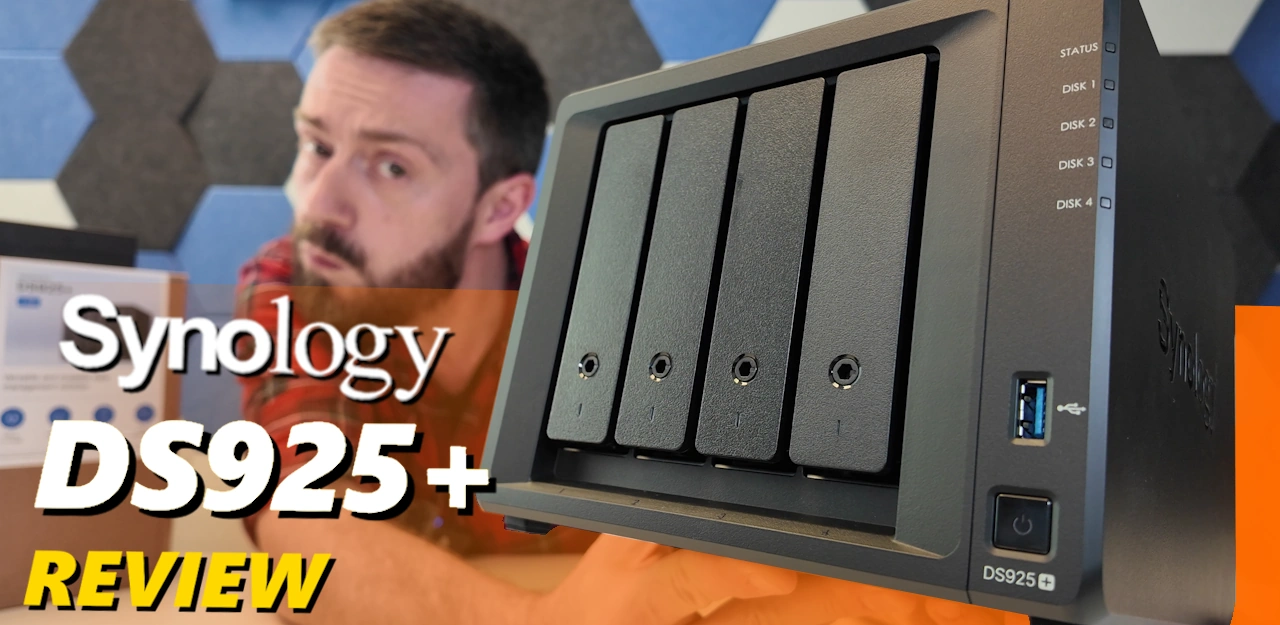
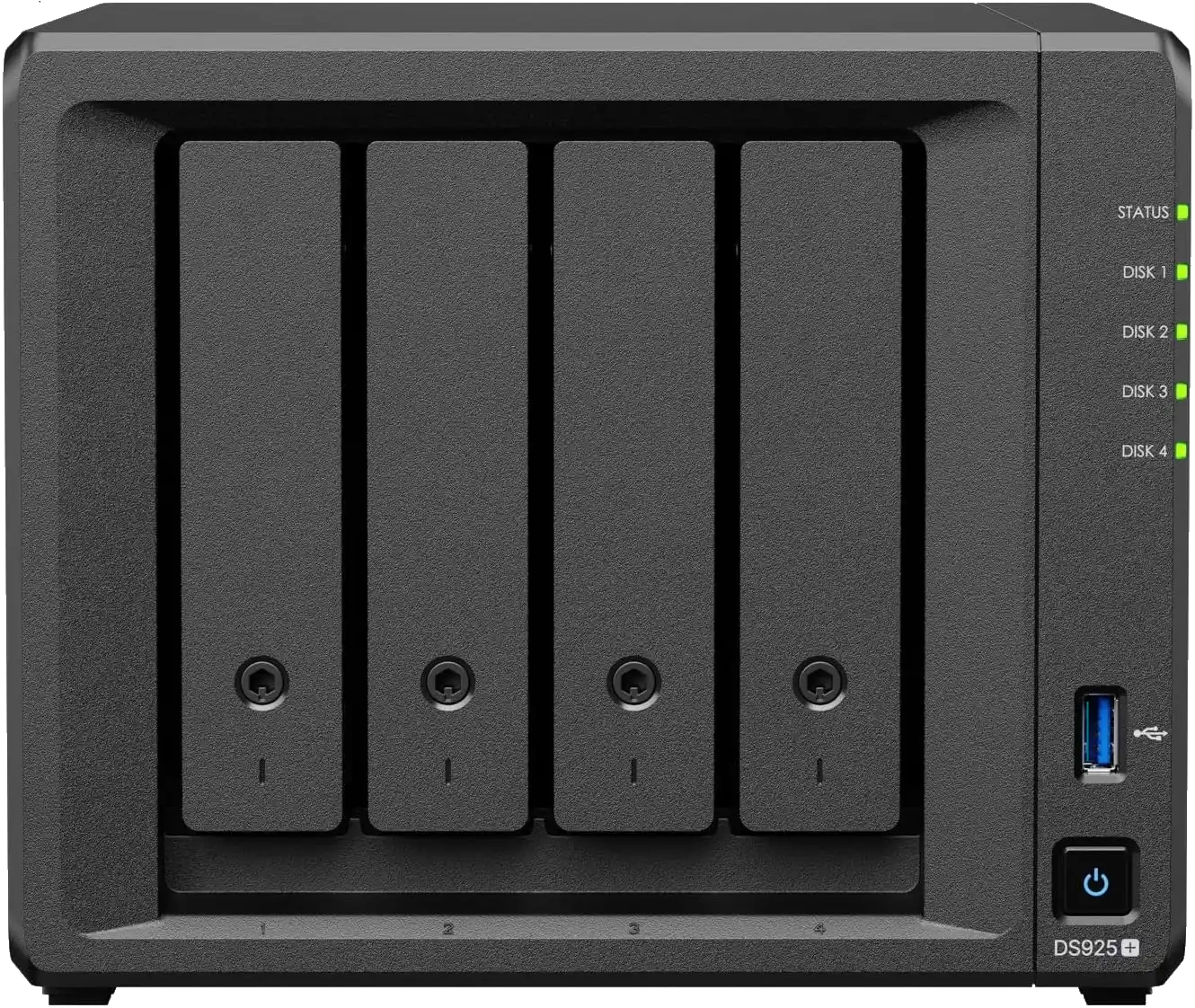





Guys, they do it so you have 40% less probability, that a 1 in 10000 chance of fatal drive malfunction event occurs (the drive which contains pictures of your dogs, family, some movies, of which you already have a redundant RAID copy). LOL
REPLY ON YOUTUBE
Which university degree do I need to have to understand this video?
REPLY ON YOUTUBE
I’ve got Ironwolf 8Tb in my DS925, and its my first NAS so i’m a complete noob at how it works, yet with simple guide it was easy..
REPLY ON YOUTUBE
I love your videos but this now seems like a Synology fanboy video and damage limitation
REPLY ON YOUTUBE
Thank you! Synology is really giving the middle finger to us little hobbyist. On my 3rd Synology NAS and it’s sad, but I think I’ve had enough. Gotta start researching what to migrate to next. Appreicate all of your shared knowledge and info!
REPLY ON YOUTUBE
Would u recommend Synology HAT3310-16T over Seagate IronWolf Pro 16TB even if I consider using the Synology HDD in the Unifi UNAS Pro?
REPLY ON YOUTUBE
Yes, I am in need of a new nas. Mine finally is about to quit and I just bought one. Guess what? I is not a Synology.
REPLY ON YOUTUBE
Don’t smoke crack, kids!
REPLY ON YOUTUBE
Oh they are going to loose customers!
REPLY ON YOUTUBE
It’s written. Almost all HDD are supported but Synology doesn’t provide technical support. I have a 923+ with HDD that are not listed either on 923+ list.
REPLY ON YOUTUBE
So, the liking for this drive has certainly changed.
REPLY ON YOUTUBE
Can you do a comparison between this and the DS425+? Seems like the 415 is better for plex??
REPLY ON YOUTUBE
no more buying synology for me
REPLY ON YOUTUBE
2 months and one ex-Syno customer later, I’m using a TrueNAS setup that does DSM one better in the key area that bugged me with DSM: ZFS support (I BETTER like ZFS; it’s what TrueNAS is built on! ;o)
I was able to bring my usual WD Red Pro-enough (the not-shingled variety) drives along, plus was able to put in another pool that’s just a one-drive stripe (yes, I know it’s bad, and the drive is not even NAS-grade, but TrueNAS lets me do this and lets me keep all the pieces if it breaks. I just needed the space; that data is Debian mirrors that I do back up, but can be re-downloaded anyway)
There are some niceties that I’m missing out on with DSM, but not being restrained by hardware limitations or filesystem limits was what got me out of Syno
REPLY ON YOUTUBE
@27:29, no this does not make sense as a way to close-ranks on their eco-system. Hard drives are a generic replenishable. Synology does not make their own, and they certainly cannot imply any added benefits to purchasing certain brands. A drive will fail sooner or later – thats a fact of life. There is no stopping that and there is no protecting against that. The protection against losing data is the mechanisms that you should be depending on: backups and/or redundancy – which is the purpose of the NAS – not the individual drives. This is moronic, and is going to hurt a lot of people and the market in general.
Don’t give Synology an inch of “but muh eco-system”. Individual hard drives do not factor into it. The only thing they should be blocking in terms of HDDs are truly under-performing models, such as SMRs when not operating as a singular drive.
REPLY ON YOUTUBE
Hi, i have a DS213+ with 2x8tb Seagate drives in mirror as an office backup but the drives are almost full. I want to upgrade to the 925+ but re use the 2x8tb hdds. Can i just pop them in a new 925 and still have the Synology os and backup data and add another drive to expand drive space?
REPLY ON YOUTUBE
If its just a case of validating 3rd party drives and releasing patches/firmware to allow additional drives in the future that are not Synology brand – then its hopefully going to be ok for many who want to upgrade in a year or so’s time. But if they are locking down their NAS to only Synology Drives and m.2 – well my next NAS will be either DIY or another brand.????????
REPLY ON YOUTUBE
You can forget about it… Synology will not be adding 3rd party drives. Look at the 3rd party list of the DS3622xs+, 3 years later, only a single 3rd party drive, a tinny 4TB WD drive. It’s all about money; populating an 8 bay NAS with their drives almost triples the amount of cash in their pocket.
REPLY ON YOUTUBE
I just started my setup with my DS1525+ with Ironwolf drives and ran in to not being able to get past the settup…. I’m new to NAS’s and I had no idea. I would’ve budgeted my setup entirely different had I known this. It’s going to cost me another $200-$400 to fix this issue now. Thanks a lot Synology.
REPLY ON YOUTUBE
Well I am done with Synology. I have a DS920+ and I have been very disappointed with its performance. Very bad for Apple Time Machine backups. So rather than buying another Synology case e.g. DS925+ I am just going to buy a base model Apple MacMini and attached External hard drives. This will be cheaper than buying a new 925+ case only and it will be sooo much faster. I can just remote into my MacMini from my MacBook Pro. Also I don’t have to learn how to use another operating system. There is no point of buying a 925+ because obviously my IronWolf drives from the 920+ are not compatible with the 925+. How ridiculous. And I can get a MacMini with a bolt in 10Gb port.
REPLY ON YOUTUBE
I’ve been considering installing a NAS in my home and the hard drive limitations imposed by Synology are not a great thing. I discovered this issue when shopping for equipment. That said, there doesn’t seem to be a real competitor for Synology in the NAS environment. No one else seems to have the depth of execution or the software?
REPLY ON YOUTUBE
Yeah Synology used to be a good company now they have got greedy. What they are doing with NVMe and being picky on hdd is an absolutely outrageous. Now getting my $
REPLY ON YOUTUBE
I just confirmed with Synology that I should have no problem running my existing WD Red NAS drives and my Crucial SSDs in my new DS925+. Wasnt that what you said would not work?
REPLY ON YOUTUBE
As a fresh face only willing to dip my toe in the NAS sea. This does bring up the choice. AS a first NAS, I don’t need cant use the top of the pile. I am a bit of a tech conservative, I like the quality middle tech, ie, 8 core CPU, but the Ryzen 7 7700X rather than the shiny x3d. So what to do?????
REPLY ON YOUTUBE
I’m still running a DS215j which is on its last legs. I was holding out to see what Synology offered for 2025 but I’m now considering a Ugreen. As part of the upgrade I’d like to install cameras (currently using the terrible blink cameras). The appeal of Synology was the great OS and the 1st party cameras and software, if I was to switch to Ugreen what would my options be? I want something dead easy to install and manage.
REPLY ON YOUTUBE
Nope… I’m not getting involved with a company that forces you to buy their overpriced rebranded hard drives. I’m out.
REPLY ON YOUTUBE
Wow, I thought they would have backed down with this nonsense. Seems like they are now committed to losing all the home users as well.
REPLY ON YOUTUBE
How can 3rd part HDDs be compatible with DS923+, but not compatible with DS925+????
REPLY ON YOUTUBE
Do not talk about synology anymone in your channel…
REPLY ON YOUTUBE
It is clear that synology will not be able to compete in the market by itself, competitors are bringing more in terms of hardware, closing gap in OS in terms of usability, truenas linux port opens up new possibilities. There are so many ready to deploy applications in containers, ssd based little NAS is already gaining popularity. I believe synology tries to suck more milk from enterprise customers, since they will quickly lose consumers. I am very glad that synology did this. I hope, it will be another nail in their coffin. I hate these kinds of firms. Synology always tried to be the apple of storage world. Hard disk lock in will seal this. However I do not think that NAS users are as loyal as Apple users.
REPLY ON YOUTUBE
bye bye synology. i am going to use Ugreen. synology makes loyal customer use other brand thats good synology
REPLY ON YOUTUBE
Finally 2.5 GbE at the lower price range. But that CPU… Would have been ok 3-5 years ago. I have my 2nd QNAP now. It has a J4125. I guess I will never switch to Synology given that hardware. Also, more often NAS vendors use x86 CPUs without GPU. So no HW accelerated encoding anymore unless you add a dedicated GPU.
REPLY ON YOUTUBE
Finally 2.5 GbE at the lower price range. But that CPU… Would have been ok 3-5 years ago. I have my 2nd QNAP now. It has a J4125. I guess I will never switch to Synology given that hardware. Also, more often NAS vendors use x86 CPUs without GPU. So no HW accelerated encoding anymore unless you add a dedicated GPU.
REPLY ON YOUTUBE
Finally 2.5 GbE at the lower price range. But that CPU… Would have been ok 3-5 years ago. I have my 2nd QNAP now. It has a J4125. I guess I will never switch to Synology given that hardware. Also, more often NAS vendors use x86 CPUs without GPU. So no HW accelerated encoding anymore unless you add a dedicated GPU.
REPLY ON YOUTUBE
Lolz
Will never upgrade my two synology devices. Go to hell synology.
REPLY ON YOUTUBE
Videostation removal and video playback support is big no no for me. All my family home videos are there and children are using it every day. This is stupid.
REPLY ON YOUTUBE
Great content, but hot garbage product. They removed the PCIe slot while NOT providing 10GBe? The last straw is on the vendor lock-in for its storages (HDDs/SSDs)…
REPLY ON YOUTUBE
Thank you for the review, much appreciated. I’m a bit disappointed with the decision of only Synology HDDs, I have a 2014 unit I would like to replace but I don’t want to have to buy new HDDs nor be plagued with constant warnings. 10GB port is a bummer also, to bad … I like the horsepower the unit has but the drives is a turn off for me. Might as well go DIY or see what else is out there…bummer, I really like the DSM.
REPLY ON YOUTUBE
Well, today I was searching a top UK etailer’s site and I spotted that Synology now offer a 20Tb HAT5310 hard drive. Prior to this, I think they’re branded drives topped out at 16 or 18Tb.
So, how much does Synology think using their rebranded drive should cost compared to the third-party NAS certified equivalents?
Even I was shocked at Sinology’s markup, a sign of their hubris.
Seagate Exos 20Tb : £336
Seagate IronWolf Pro 20Tb: 395£
WD Red Pro 20Tb : £500
Synology HAT5310 20Tb: £864
It seems you really pay through the nose to save Synology those extra support tickets.
REPLY ON YOUTUBE
Well, today I was searching a top UK etailer’s site and I spotted that Synology now offer a 20Tb HAT5310 hard drive. Prior to this, I think they’re branded drives topped out at 16 or 18Tb.
So, how much does Synology think using their rebranded drive should cost compared to the third-party NAS certified equivalents?
Even I was shocked at Sinology’s markup, a sign of their hubris.
Seagate Exos 20Tb : £336
Seagate IronWolf Pro 20Tb: 395£
WD Red Pro 20Tb : £500
Synology HAT5310 20Tb: £864
It seems you really pay through the nose to save Synology those extra support tickets.
REPLY ON YOUTUBE
Well, today I was searching a top UK etailer’s site and I spotted that Synology now offer a 20Tb HAT5310 hard drive. Prior to this, I think they’re branded drives topped out at 16 or 18Tb.
So, how much does Synology think using their rebranded drive should cost compared to the third-party NAS certified equivalents?
Even I was shocked at Sinology’s markup, a sign of their hubris.
Seagate Exos 20Tb : £336
Seagate IronWolf Pro 20Tb: 395£
WD Red Pro 20Tb : £500
Synology HAT5310 20Tb: £864
It seems you really pay through the nose to save Synology those extra support tickets.
REPLY ON YOUTUBE
Are we nearing a #harddrive #monopoly?
REPLY ON YOUTUBE
If your NAS will fail!!! You will be in a big trouble to get your data back. 🙂 You can not buy a new NAS and transfer the drives. And recover your data. All the old NAS will be expensive 🙂
REPLY ON YOUTUBE
I was super excited once I’ve seen the new ds925+ but it means when moving forward I can not use my old ironwolf drives so…???? still waiting for something that could exchange ds420+
REPLY ON YOUTUBE
I bought a Synology several years ago to dedicate to Surveillance Station. So I will probably always have one. But any other NAS/Server setup will definitely not be Synology.
REPLY ON YOUTUBE
The DSM is a state of art product, but what they are doing is beyond common sense. Just let users decide whether they want to use ‘non compliant’ storage. It worked on older models so why not on the new releases?
REPLY ON YOUTUBE
Wonder how long it will take them to start fleecing their customers on the price of “Compatible” HDD.
REPLY ON YOUTUBE
IMO, the big winner in all this? Unraid.
REPLY ON YOUTUBE
What UPS would you recommend for this NAS, I got a APC Back-UPS Pro BR1600MI but it has 8 IEC sockets and not UK sockets. I would think a UK seller would have UK sockets and not IEC ones?
REPLY ON YOUTUBE
I wanted to upgrade my ds218+ to ds925+ and I cancelled my order after seeing this. Now looking into qnap.
REPLY ON YOUTUBE
BS by Synology otherwise they would NOT EXCLUDE but RECOMMEND Drives.
If they do not run it back soon, DECLINE of Synology will start and the STAIN will stay on the Brand and only get bigger. Once TRUST and CUSTOMER GOODWILL is lost…. Meanwhile competition is not sleeping.
REPLY ON YOUTUBE
I will not continue buying Synology in the future when they continue with their restricted HDD policy. No way.
REPLY ON YOUTUBE
Switched from Netgear RN424 to the DS920+ and love at first use. Bought another and slightly older used one for an off site backup. Was helping my dad with the new DS925+ coming out as he still had the Netgear too. Wow. Downhill fast. I don’t want to relearn with Ugreen or similar, but this is a bit harsh and damaging.
REPLY ON YOUTUBE
Hi, I’m planning on getting a Synology DS925+ NAS, my old 2 bay I used BTRFS with SHR, what would you recommend I use on this NAS?
REPLY ON YOUTUBE
This is just an observation about corporate America. When did the new CEO at Synology start?
REPLY ON YOUTUBE
I have been a user, fan and partner since the DS508, DS509 days, but this Synology HDD requirement is a deal breaker. Very sad that Synology is diverting from its original path that has made it so successful through the years. Looking forward to new and more affordable open source hardware like the Minisforum N5 Pro, Ugreen, Asustor, etc.
REPLY ON YOUTUBE
Update – I have performed extensive testing of Unverified/3rd party HDDs in a Synology 2025 Series NAS. You can see the results here – https://youtu.be/aKS1lSaXJN8?si=1OFhvLEErd8NeRbs
(TLDR – Now you cannot use unverified HDDs on a storage pool that you have migrated over from an old system for RAID Recovery, RAID Expansion or Hot Spares)
REPLY ON YOUTUBE
Just installed over the weekend and returning. Noise levels way too high for me. (Need to work with the NAS in my home office) I’m going back to my 718+ for now. Might go for the 725+.
REPLY ON YOUTUBE
Att: Synology. Had to purchase 2 new NAS’s for a company I look after and because of your silly new hard drive rules I purchased QNap’s instead. Your loss Synology
REPLY ON YOUTUBE
my guess is 7,000 hours of testing = 70 drives at 100 hours each, or some combination thereof. Either way, “competitive pricing” … no. Seems they want to push all home users to smaller NAS units and are expanding what was formerly the xs/xs+ range downwards to the plus range. Unless they start validating third party drives pretty sharpish, they are going to alienate a lot of the more “enthusiast” home market sector.
REPLY ON YOUTUBE
I have a really hard time following what you say. There is NO “good news” anywhere in this. It does not matter if synology have indicated this path forward etc etc. It does not matter if “compatible drives” perform better. There is an easy solution to all of this – if you want full support, use recommended/compatible drives. Making other drives not work or not as well, is NOT the solution.
Your discussion about the performance data of compatible drives is just completely irrelevant. IT DOES NOT MATTER! Of course there are hard drives that are better and that are worse. Why even bother discussing it?
“We crunched the numbers” – does it matter? Really? Not at all. No matter what the numbers are, it is “drive locking” !!! It guess it is Synology trying to get more money from their customers in a way that is sadly becoming increasingly common.
Nothing you say makes any sense. One of your last comments was revealing – “how users benefit”.
There is absolutely NO BENEFIT for any user. How do you think? That it is impossible to buy recommended drives if you can use other drivers as well?
This was really bad!
Trust in you videos fell by a large margin here.
REPLY ON YOUTUBE
A company that gets worse as time goes by
If you lose media and hard drive compatibility, there is no reason to use it anymore.
REPLY ON YOUTUBE
Synology, it’s over. Do concentrate on business models, those underpowered, locked, stripped down models won’t sell a unit.
REPLY ON YOUTUBE
If synology ban other hdd I will switch to QNAP ????
REPLY ON YOUTUBE
I;’d rather cough up an extra £100 for the device as long as I can stick whatever brand drives I want in there. With 20TB Synology drives going for £800 and Tosh doing 20TB drives for £320 – its a no brainer to spend that extra on the device itself while saving HUNDREDS on drives. Heck, Id probably get the expansion and fill that up with 20TB tosh drives too. I’ve reached the limit on my current setup (ds718+ and a ds218j) so NEED to expand but QNAP might be where I’m heading from what I am seeing. Expensive device but better hardware and better drive support.
REPLY ON YOUTUBE
Synology has ruined it for me if I cannot use a brand of drive I want to use i.e. I love the Toshiba’s that I have – I think they’re N300s? 15gb drives, I’m running short on space, I want to upgrade and I want to just pop the drives in but if Synology is going to refuse my tosh’s then I’m going to have to go to a different NAS brand which is a shame as I have gotten use to the Synology and Plex runs well on there so I’m pretty gutted about Synology’s choice with HDDs. Its a real shame.
REPLY ON YOUTUBE
I did not catched which Syno series/models should be these days for multimedia
REPLY ON YOUTUBE
I think the NAS Advocacy Though Leaders show plot out when in time the M.2 (ie: reasonable priced 16TB modules) will begin to neutralize this debate over Synology certified spinning mechanical drives.
This will be a better test of this strategy by Synology because, while there are differences in quality and performance for M.2,, the long term trajectory is going to neutralize their claim of certifications of an exclusive group of hardware
They better learn from Blockbuster Video
REPLY ON YOUTUBE
Is there no 4 bay plex solution from synology for 2025 then ? Is the recommendation to wait for the ds925+ or simply don’t by synology ?
REPLY ON YOUTUBE
Very frustrated, I’m a customer since 2015, persuaded at least 13 friends to buy their nas, but now I’m so upset, I’ve been holding 2 .. 3 years to buy their newest model , now I just want to go elsewhere, very upset
REPLY ON YOUTUBE
No 10G = No Upgrade to 925+.
REPLY ON YOUTUBE
synology scam you could sniff from miles. Personally I went to QNAP with my first NAS and I never looked back at synology scam.
REPLY ON YOUTUBE
bye bye synology, welcome seagate ironwolf pro to my truenas
REPLY ON YOUTUBE
What a joke.
REPLY ON YOUTUBE
I totally lost interest in Synology. Stopped listening after the HDD verification issues.
REPLY ON YOUTUBE
I need an advice. I have a DS918+ with 4 x 4TB WD Reds in SHR1. I’m getting short on space, but otherwise I’m very happy with it. I need to do something, and I don’t know what. New DS925+ (with new disks unfortunately) or other model or extra DX517 (I have 5 x 3 TB WD Reds that I can use, 4 from an old DS413 and 1 extra one as an external HD for a PC). I think a DX517 in my case is more sensible, especially because I already added RAM and SSD cache on the DS918+ but I might have missed something so, any advice ?
REPLY ON YOUTUBE
Maybe Synology should look at developing and licencing their software to run on the Ugreen NAS, that would suit a lot of people
REPLY ON YOUTUBE
This will all but eliminate use of re-certified enterprise drives. Locally, the cost of a DS925+ with 4x HAT5310 8TB Synology Drives, is 40% more expensive than a DS923+ with 4x re-certified 16TB enterprise grade WD drives (which include a warranty and local support). 40% more expensive with HALF the raw capacity. Nuts.
REPLY ON YOUTUBE
Synology should exit the home/prosumer market and do only enterprise. This will significantly decrease their market share.
REPLY ON YOUTUBE
That box for 150-200€ plus synology Harddrives only maybe ok.
REPLY ON YOUTUBE
I’ve actually installed some high end rackable synology NASes which already have drive verification and it’s basically a text files with a list of serial/model numbers. The third party drives work fine for storage but don’t show any smart and the NAS complains about them all the time. BUT you can go and modify the file in SSH and add your drives’ desrciptors to it and suddenly you have access to everything and the alerts stop.
REPLY ON YOUTUBE
Synology RIP for private customers. Synology reviews are basically useless from 2025 onwards…
REPLY ON YOUTUBE
Have 2 of their devices now, but unless they change their policy, won’t be using another one. May go build myself a NAS in the future and try HexOS…
REPLY ON YOUTUBE
Nope. No more…
REPLY ON YOUTUBE
Your background looks like a game of 80s UK TV gameshow Blockbuster
“I’ll have an E please Bob”
“It’s not on the compatibility list”
REPLY ON YOUTUBE
How would one fully saturate the 2.5gbe?…and same for 10gbe?
REPLY ON YOUTUBE
so if I use the migration method to move my old WD drives to the new 925+ or 1525+ and then one of WD drives fails, then would I have to then use a Synology drive to replace the failed drive? Seems like a weird question to ask but it seems relevant for now
REPLY ON YOUTUBE
I don’t think Synology understands their user base, it’s not mums and dads buying their products like Apple products. This is not even mid hardware, this is like they’ve gone through someone else’s recycle bin from 2020. The HDD lock in is just taking the piss at that point. It just seems like they are trying to lose customers, considering all the new options starting to surface, especially with the rise of AI. They need to get their head out of their ass and get back in the game.
REPLY ON YOUTUBE
Most likely your 916+ is easily repairable, if it died due to common intel atom problem (resistor fix). Repaired two gen16 synology devices myself.
Hello! I’m looking into getting my first NAS (or DAS) and I’ve already done a fair bit of research, but I still have a lot of questions, more then I can fit in the “Free NAS advice” form on your website. I see that there’s a way to pay for a faster response, but is there a way to get paid advice that would permit a larger/longer set of questions or a back and forth conversation, in addition to or instead of a faster reply?
Thank you!
REPLY ON YOUTUBE
Wow. 10 year old processor upgrade. No 10Gigbt. And stuck with their shitty drives.
REPLY ON YOUTUBE
If you just want a NAS and already have Ubiquiti hardware, the UNAS Pro is excellent. Synology releasing a product that doesn’t support 3rd party drivers is unforgivable. All other manufacturers support ALL drives so why not Synology? They’ll be out of business within a year hopefully.
REPLY ON YOUTUBE
So I can tell you with 100% assurance that I will not be buying any additional Synology products and with 100% certainty now already have to consider already a non Synology backup strategy and also already looking at moving out of the Synology eco-system. Congratulations Synology for isolating yet another customer.
REPLY ON YOUTUBE
Keep making the Synology reviews with the call out about their HD’s. It will be a good video when Synology changes its mind.
REPLY ON YOUTUBE
This will be a skip for me
REPLY ON YOUTUBE
I have no problem with them locking down their system. What i wanna know is will it support transcoding for Plex server installation? I mean hardware and software transcoding.
REPLY ON YOUTUBE
So I’m curious what percentage of Synology’s customer base are home/hobby users? It’s not like these guys started by building enterprise servers. Seems pretty stupid to flip off the consumers using NASs at home. Why not follow so many successful tech companies that have both consumer grade equipment and enterprise grade equipment? This is just like Plex tearing apart our home media player into separate pieces to make our player into an app that merges all of the external streaming services into a single app. Why didn’t they make a new app? What is wrong with these tech companies? I guess I just don’t understand the market. Fair enough. I’m done with Synology. They simply don’t deserve my loyalty. I got none from them.
REPLY ON YOUTUBE
Not Even graphics gpu , old processor , Disk limitation . How to Connect the expension bay we already have ?? Synology What are you doing ?
REPLY ON YOUTUBE
What I don’t like is in an emergency, I can’t throw another similar drive that is not official, so I have to buy a couple of extra Synology branded drives for backups even if I have perfectly good ones laying around. Screw this, this is a pain because I do use Surveillance Server…good thing I only bought one extra license. I wish Blue Iris supports ARM so I can build an energy efficient NAS/Cam server.
REPLY ON YOUTUBE
I’m feed up with Synology when I need to add drives the market drives are not listed in the compatibility list so I end up purchasing a drive not compatible one time !
The hard drive lack power for the price and the brand-wild is so poor ! 2.5 ! What a pity.
Now forcing to purchase Synology (Toshiba fabric lately use to be WD…) is stupid, if some hard drive present failures communicate keep the compatibility up to date.
I will look to purchase form other brand but unfortunately so fare none are as good as synology for security.
Shareholder interests are always the highest priority and more recently have gotten to the extreme in profit over product decision making. There are far too many acceptable NAS options now to put up with Synology’s crap. I’m more intimidated by by shifting away from Plex than I am shifting from Synology. But I’m fed up with both.
REPLY ON YOUTUBE
I think I’m going to keep my current Synology for regular backup for my family member due to its simplicity with its app. But I’ll buy another brand for nas with higher performance with less hardware limitations
REPLY ON YOUTUBE
I think they want to ditch consumers, to be honest. This seems calculated. Between this and selecting chips with no iGPU.
REPLY ON YOUTUBE
Well, NO! As a consumer and a customer, we must send a clear message. Just no. This policies and simply bullshit. The HAT drives are like 50% in price, without adding ANY VALUE at all and they are not available at higher capacties (3.5. i checked and 16TB is the highest capacity – are we a joke to Synology?) Also, as i am also a part of corporate, if we dont stand now, we dont stand ever. So just “SAY NO” and go QNAP or UGREEN, or literally any other brand, just to make them suffer. Nothing else will make them change their mind. We have so many examples in the history of succesful brands making stupid moves and biting the dust. Seems that Synology mightt be another one in the line…
REPLY ON YOUTUBE
Garbage product from a garbage company. And tbh if NAS’s where not a niche, the EU would have eaten these c*nts for breakfast long before they got to launch this PoS dumpster fire.
REPLY ON YOUTUBE
Everything is fine. It’s a pity that your way of speaking is “Run Forest, run” ???? And I hope Synology will lose a lot with its new “compatibility policy”
REPLY ON YOUTUBE
At 28:20, you mention they removed 10gbe in order to upsell the DS1525, which will have 10gbe option. Has that been confirmed? I thought the rumor was that the 1525 would NOT have 10gbe?
REPLY ON YOUTUBE
I thought they made it pretty clear that the “Synology drives only” was for HDD, not SSD:s which would indeed show up as unverified?..
REPLY ON YOUTUBE
Can’t even initialize 3rd party drives, wow
REPLY ON YOUTUBE
Thanks for your summary review of an actual 925+. I have been planning to upgrade from my old Netgear ReadyNAS units and based on what the older 923+ offered hoped to enter the Synology ecosystem with a more recent model. But the 925+ is a disaster – no 10Gbe upgrade path, drive lockin on HDD’s and NVMe’s – I can’t afford to invest a substantial sum for such a restricted hardware platform when there are other open systems with better hardware and s/w that is almost DSM waiting in the wings. No amount of dangling the possibility of expanding the approved hardware list will convince me to buy Synology now.
REPLY ON YOUTUBE
So if I upgrade from my current DS920+ and DX517, can I just swap my drives in the DS920+ to the DS925+ and then use a USB-c to eSATA adapter to use my existing DX517?
REPLY ON YOUTUBE
Whats the bet Synology are asking HDD and SSD makers to PAY them for “verification”. Its a money grab.
REPLY ON YOUTUBE
Synology feels like most other tech companies nowadays that have been dominant for ages and have created an ecosystem that customers cannot or will not move on from and as a result those companies stop innovating. It always ends badly.
REPLY ON YOUTUBE
If you can’t use the drives you want, is it even yours?
REPLY ON YOUTUBE
does he have a phobia going to a dentist?
REPLY ON YOUTUBE
all it takes for compatibility is a BIG CHECK. What hardware encoding do you get with this processor, does it do hevc?
REPLY ON YOUTUBE
Can you make a video of alternatives? As Synology is a no-go for most people now.
REPLY ON YOUTUBE
Synology can get fucked
clowns, I can no longer recommend them business wise
what happens if I can’t get a drive(s) for replacement at a client, the client gets fucked … yes!?
REPLY ON YOUTUBE
Prefer 1gbe with option for 10gbe vs 2.5gbe and no option
REPLY ON YOUTUBE
What a great new release from Synology! I started to run out of space on my old 2-bay DS218play, so I started looking at upgrades, and after seeing their new line, I knew for certain I’ll go elsewhere. Ended up with a DIY NAS with Unraid. Thank you Synology for making my decision easy!
REPLY ON YOUTUBE
What about moving shr volume pool disks (non synology) from old synology nas to ds925+ and replacing one for rebuild (also non synology). Is it allowed by the system? Will it rebuild?
REPLY ON YOUTUBE
Synology needs a reward for how to tick off a loyal customer base in record time ????. As a long time Synology user on my 3rd NAS, I’m replacing my Ds418 with a Ugreen which is arriving next week ????????. I’m willing to live with less polished software or install Truenas or Unraid if I WANT to. Good luck to Synology from here ????????
REPLY ON YOUTUBE
Switched to diy earlier this year after 3 synology’s. You outgrow them eventually anyway i think, but synology is making the switch easier every year 🙂
REPLY ON YOUTUBE
Bye bye synology
REPLY ON YOUTUBE
A NAS for hardcore fanboys. ????♂
REPLY ON YOUTUBE
Just working on a follow up article and video testing different Unverified HDD and SSD NAS scenarios (boot, expansion, migration, recovery, etc). You can follow the Synology 2025 NAS Series 3rd Party Drive Compatibility Test Article here – https://nascompares.com/guide/synology-2025-nas-series-3rd-party-drive-compatibility-what-works-what-doesnt-right-now/
REPLY ON YOUTUBE
Just working on a follow up article and video testing different Unverified HDD and SSD NAS scenarios (boot, expansion, migration, recovery, etc). You can follow the Synology 2025 NAS Series 3rd Party Drive Compatibility Test Article here – https://nascompares.com/guide/synology-2025-nas-series-3rd-party-drive-compatibility-what-works-what-doesnt-right-now/
REPLY ON YOUTUBE
Just working on a follow up article and video testing different Unverified HDD and SSD NAS scenarios (boot, expansion, migration, recovery, etc). You can follow the Synology 2025 NAS Series 3rd Party Drive Compatibility Test Article here – https://nascompares.com/guide/synology-2025-nas-series-3rd-party-drive-compatibility-what-works-what-doesnt-right-now/
REPLY ON YOUTUBE
Up Next: Synology electricity required other electricity is inadequate.
REPLY ON YOUTUBE
Up Next: Synology electricity required other electricity is inadequate.
REPLY ON YOUTUBE
Up Next: Synology electricity required other electricity is inadequate.
REPLY ON YOUTUBE
I had a Synology like … 13 years ago. Replaced it by a DYI linux-based server 10 years ago which is still working today (it’s due an upgrade this year). I’m NEVER going back to a proprietary solution, even less so one that even restricts what kind of additional hardware I can put in.
REPLY ON YOUTUBE
It is, as of this change, no longer “the gold standard” anymore.
REPLY ON YOUTUBE
I’m giving up on Synology. This is ridicules. I’ll see if I can sell off my old ones & go with another vendor while I can.
REPLY ON YOUTUBE
Just curious one thing I didn’t see in the video is testing 3rd party ecc sodimm modules and seeing if it would boot or not. If you can maybe clarify if it would or wouldn’t that would be great thanks
REPLY ON YOUTUBE
I don’t want it.
REPLY ON YOUTUBE
I used PLUS models simply because anything else were slow as hell at that time when I bought them, not because I’m using it for enterprise use case. I just use NAS just for home data stockpile and backup. GG Synology. You guys were great. Not anymore.
REPLY ON YOUTUBE
ECC but no ZFS, old CPU, 2×2,5GBit but no possibility to upgrade to 10GBit, expecting the usual pricing, no third party HDs? I do not understand the strategy behind except of completely getting rid of all private customers -> too bad, after 2 decades, good bye Synology
But thanks for the video!
REPLY ON YOUTUBE
So all Plus series are now for corporate $$.
REPLY ON YOUTUBE
Synology are OTW to garnering a lot of HATE. Remove USB support instead of giving warnings, but allowing people to use it. Destroying DS Video which is looking better and better now that plex have decided to piss off its users, and now the HDD scandal. Removing 10GBe support was idiotic. I do NOT need a new NAS currently – partly as i have 6 of their older ones, but will not be considering them again for a very very long time. Xpenology is looking very intriguing now. I suspect many people will be looking at it a lot more closely. Hopefully Synology ave a Jesus moment and repent. As they have sucker punched those of us who used to rave about them and recommend them to everyone we knew in business. I have nothing but contempt for this company now.
REPLY ON YOUTUBE
I will wait to see how they add 3rd party HHD’s to the compatibility list, but if it doesnt open up equitably … I AM DONE with Synology and very interested in alternate products.
Synology, wake up and realize this is a bad idea. This isnt some Adobe Ps subscription model where you see dollar signs if you force users to capitulate … unlike Adobe, Synology has multiple equal competition … which means this is just dumb. Back down and call it a mistake, or we will on mass … leave.
The only way it will work, is if Synology drives are up to 20% cheaper than equal Seagate or WD drives. That is really only the way this will work.
… not likely. Synology is showing that they only see its customers as victims of cash sucking.
The software argument is not as user friendly unique, as it used to be. Ya need to look around at your competition.
REPLY ON YOUTUBE
Done. I’m not buying another Synology.
REPLY ON YOUTUBE
916+ just died, I’m almost forced to buy a 1522+ to recover my data. Horrible timing.
I have a full Unifi setup at home. I wish I could buy the Unifi NAS Pro, but I want to get my data out of the Synology. I have an offsite backup of everything on BackBlaze, but still don’t want to risk going to a backup solution when I have these HDDs … I’m worried about data degredation, so I’m going with paying Synology my $$$ just to get my data.
I will upgrade to Unifi NAS Pro MAX once it comes out and has a stronger CPU more RAM, because I want to put SSDs in that guy to actually take advantage of the 10GbE.
REPLY ON YOUTUBE
Can you go into a deep dive with the Synology Software? I’ve been looking at getting a NAS for a while for my small office (2 people, max 5 TB storage for CAD/design work plus surveillance for the office.) I’ve looked at Synology DS925+ and it seems like its software is pretty robust but my small business is running on Unifi and I’m also considering the UNAS as well. Which would you recommend?
REPLY ON YOUTUBE
Hardware lock – I’m out…
REPLY ON YOUTUBE
Folks are rage-quitting for UGreen. But I don’t see anyone posting videos that UGOS is way better than DSM. Or TrueNAS is so much better. This feels like all the people moving to Canada if a certain President is elected. But no one actually moves. ????
REPLY ON YOUTUBE
Finally migrated from my old workhorse to a new NAS. Looked at Synology long enough to know that vendor lock-in is an immediate disqualification. I understand that (perhaps) they want to reduce support overhead and troubleshooting complexity by forcing users into standardized drives (conveniently from Synology). But continued lackluster performance and the apparent restriction on after-market hardware is a good way to put yourself out of business.
REPLY ON YOUTUBE
Thats a Hard No for me
REPLY ON YOUTUBE
You grimacing at the elephant… is my new desktop wallpaper! Brilliant ????
REPLY ON YOUTUBE
I think 2 things # This was a typical fence sitting BS Robbie review …a 6 year old CPU? No 10GBe …it is a complete piece of crap hardware wise … #2 Who else has locked down their ecosystem? …hmmmm members only ??? Get stuffed Robbie you are nearly as bad as Synology these days
REPLY ON YOUTUBE
Looking to upgrade my DS1019+ to DS1825+, But if they lock the drives as well then I”ll look at another brand.
REPLY ON YOUTUBE
The only efficient thing about that cpu is the price to Synology. Its gen 1 embedded Zen. Gen 2 and 3 exist and are more power efficient, made smaller, and run cooler.
REPLY ON YOUTUBE
@nascompares Thank you for trying other ways of bypassing the new NON Synology drive policy.
REPLY ON YOUTUBE
Synology have discovered ensh1tification. Sad.
REPLY ON YOUTUBE
I’m gonna save everyone 30 mins. F—K Synology, go buy something else. That’s all
NASCompare you shouldn’t be reviewing anything Synology anymore! Don’t support the BS!
REPLY ON YOUTUBE
I notice you have the FFmpeg6 software on the NAS, what does it do with regard to NAS, or is just a file converter?
REPLY ON YOUTUBE
Used Synology for 12 years. Moved to Unraid after everything that has happened.
Can’t believe Synology execs had no idea of the public backlash
REPLY ON YOUTUBE
Rip Synology ????
REPLY ON YOUTUBE
Bye Bye Synology may as well retire my 918+ now before they nuke it
REPLY ON YOUTUBE
It’s a software lock nothing more. I’m looking into other NAS solutions now.
REPLY ON YOUTUBE
I have a DS414 with 3x 2TB and 1x 4TB drives. I’ve been wanting to update to a new NAS but waited for 2.5Gb ethernet. Now though, I don’t know what to do. I’d want to use my existing drives but with a clean install. I can’t afford 4x new 4TB Synology drives on top of the NAS unit itself. I only really use the NAS for file storage and Surveillance Station (I have one paid for camera licence I’d need to transfer over somehow). Are there other NAS units from other manufacturers that have the camera surveillance?
REPLY ON YOUTUBE
who is going to buy this? a 2018 CPU, no 10gbe and locked proprietary drives = ewaste
REPLY ON YOUTUBE
I didn’t buy the DS925+ PURELY because of the drive compatability issue, even though I wanted the 2.5GB ethernet.
REPLY ON YOUTUBE
Not so sure the chassis is good for noise.. I just updated last week from a DS416j to a DS923+ (because I didn’t want the 925+, as I use Ironwolf drives) and the noise is considerably higher from the drives, fan noise is fine, but drive noise is probably 6dB louder.
REPLY ON YOUTUBE
Still trying to flog a dead horse I see, DSM is good but it isn’t the be all and end all of operating systems
REPLY ON YOUTUBE
12:54 is HILARIOUS! Nice touch dude!
REPLY ON YOUTUBE
can you add/change the local compatibility list via SSH like the older versions?
REPLY ON YOUTUBE
They can kick rocks. The clock is running and DSM will be a subscription service soon.
REPLY ON YOUTUBE
this new machine is 6 years too late.
Forcing the Buyer to buy extremely expensive hardware that is cheaper and better on the market (on top of that from the original manufacturer) makes no sense. It would be fair to take this step back and sell the software in return.
REPLY ON YOUTUBE
I guess I can live with, maybe not thrilled, but understand at some level, much of what Synology says–I just wished they’d partnered with somebody who didn’t make crap hard drives. I.e., not Toshiba. My 218+ with 2x HGST Deskstar NAS 3.5″ 8TB drives has hummed happily since October of 2017.
It’s not clear why, say, WD, would go to any expense to get their drives on Synology’s list. Nor why Synology would go to any expense to add any drives besides those they get a profit from onto their list either.
I’d bet SMR drives are why Synology’s failure and support stats are what they suggest.
REPLY ON YOUTUBE
I am Not Even sorry for Synologys downfall. What a joke
REPLY ON YOUTUBE
I don’t mind the closed solution in general. But what I mind is that Synology doesn’t manufacture hard drives or ssd‘s, they are simply taking away the transparency and comparability for me. They may start with a quality oem product, but who give me the guaranty that this will stay like this? And where is the advantage for the buyer? I know that my ironwolfes and 990 pro are a good choice at the moment. And if they don’t deliver in future I can see that and change. I can’t do that with Synology branded hard drives or ssd’s. at the same time the competition is catching up with their software. We have several QNAPs in use, I don’t have a problem with it. I am not using their remote access and I deactivate the admin account which comes with the system. If I need remote access I can use a VPN. So for me Synology is no longer on the shortlist
REPLY ON YOUTUBE
Bad policy for Synology, compatibility list should be extended to 3rd party. This is not good for anybody annd their reasoning is a load of crap. Imagine if HDD supply chain is suffering, you can’t just pick up another HDD and restore your system.
REPLY ON YOUTUBE
They should sell their OS and stop making hardware, and they are well on their way to doing so, we can see that this tin can serves as a showcase for their software, a bit like Linux distributions known for running on Pentium 3.
REPLY ON YOUTUBE
Wait a second! It is not an upgrade. It’s a downgrade. 2x 2.5 instead of 10 gbe. And usb-c expansion and only branded drives.
REPLY ON YOUTUBE
I’m looking to replace my ds918+, but since Synology has decided to go full villain, someone else will be getting my money.
I hope that they go bankrupt and someone else buys the company and returns to the old ways .
Meanwhile, bye bye Synology.
REPLY ON YOUTUBE
Thank you for your excellent video with details !!!!
REPLY ON YOUTUBE
“even with hard driver you will still hit a bottleneck even if you use smb multichannel”
What? How?
With 7200rpm HDDs in RAID 0 u get 300mbit (less then that IRL).
You can easily exceed that with SMB multichannel with two 2.5gig nicks
REPLY ON YOUTUBE
So many better solutions today, bye Synology. Same old story though, scrappy tech company has good ethos and hardware/software/prices supporting customers while gaining market share. Within 15 or less years gets overconfident and greedy, hardware/software/support starts to take a back seat to profit and then they lose market share becoming niche, sold off, or die. NEXT!
REPLY ON YOUTUBE
28:13 “more refined compatibility listing” Why use such marketing language? The compatibility has not been “refined”, it has been severely “restricted”. Come on, you are better than this.
REPLY ON YOUTUBE
27:41: “Synology needs to be clear about the messaging…” Messaging is not the problem. The anti-consumer policies are the problem. The new hard drive lock in is just the latest in a series of anti-consumer steps. I bought two Synology units before the company went crazy, but will not consider them in the future anymore. Anyone buying an underpowered and overpriced Synology unit today will do it at their own peril. Why wouldn’t Synology continue to remove features for which customers have already paid for like the codecs or USB driver support they removed to save a few pennies on licensing fees?
REPLY ON YOUTUBE
It’s impressive how much Synology does not want my money.
REPLY ON YOUTUBE
What about migrating a DSM 7.1.1 raid array to the 25+ series NAS?
Many users need to upgrade from DS1813+ to DS1825+ now when the software update support for DSM 7.1.1 ends in a month.
REPLY ON YOUTUBE
Why are you including Plex Media Server in the DSM apps, when this hardware does not have a CPU that properly supports Plex Media Server?
REPLY ON YOUTUBE
18:03 “But for new users, this is all nothing” (paraphrased). Of course it matters to new users as well, which options they have. New users won’t be able to choose the manufacturer they trust most. They won’t be able to buy the drives that are available in their region, are on sale, etc. They won’t be able to use drivers larger than those Synology supports and the moment the largest Synology drives are not very large. Finally, even new users will be forced to pay the Synology tax on hardware, they could buy from the OEM (Toshiba?!) for less money.
REPLY ON YOUTUBE
Where is a proper Synology Server, that uses 30w like my ds220. Well the first Synology that is feeling Borring ????. Like minimal ports, no cheap HDD options, limited expansion. NO home user wants to pay 1000s for some photos and movie server. Call me when it is 500$ with drives included????. And i have Synology no plan to upgrade this way.
REPLY ON YOUTUBE
Well, I have been using Synology for the last 10 years, not anymore, they have stopped in the past, new models with 2.5gbs NICs, where is the full NVMe NAS solution with 10GBs NICs? im not even talking about the CPU.
REPLY ON YOUTUBE
The CPU is better than the previous one, but does not support transcoding, which is a big drawback for anyone wanting to use the NAS as a media server. For anyone just wanting reliable storage, there are much more cost effective NAS options available.
REPLY ON YOUTUBE
7:44 “2.5 Gbps, an upgrade on this and maintaining that similar price point, is something to be applauded”. No, absolutely not. It is something to not boo at. Removing the 10 Gbps option at the same time, annuls any credit the company might have received for finally not repeating the embarrassing 1 Gbps connections. Call a spade a spade please. Anyhow, with their drive lock in policy, on top of all the other lock in, and Synology removing features and apps from DSM, it does not really matter how much the hardware is (still) behind competitors anymore.
REPLY ON YOUTUBE
I’ve been a Synology owner for 9 years and have been anxiously awaiting the release of a new 4-bay for a year at least. But recycling the same CPU they’ve been using since the x21 series and blocking DSM install + future upgrades using even high-quality NAS drives like WD Red Pro has left me very disappointed. At the higher capacities Synology-branded hard drives are so much more expensive than WD’s NAS line that Synology drives are no longer a viable option.
REPLY ON YOUTUBE
As a home user, not allowing third-party drives is a deal breaker. Choice is the answer. If I choose to take the risk, then it is my choice. I hope they change their mind. I know they make a lot of money on their own branded drives, but it is up to the community to stand up to them and stop buting their hardware.
REPLY ON YOUTUBE
There’s a script on github from user 007revad named Synology_HDD_db which is able to add currently installed drives to compatibility list on the fly. It also checks it on every boot in case DSM update overwrites the list. It would be great if you could test the script on DS925+. It won’t allow to initialize the OS, but I wonder if it would allow to create a volume on not officially supported drives.
REPLY ON YOUTUBE
I’ve been using Synology nas s for over 10 years . I got a little two bay ugreen nas the other day and I’m very impressed .And I’m thinking of replacing my ds918+ with a ugreen dxp4800 pro now .
REPLY ON YOUTUBE
I had a DS2419+ with expansion unit. So place for 24 drives. I never did and never will buy any Synology drives. Sold my units and have gone full Unraid on HL15 systems of 45HomeLab.
REPLY ON YOUTUBE
For years, Synology was a reliable choice for me and many of my customers—simple, intuitive, and stable.
However, over time, Synology’s hardware began to fall behind. Sluggish CPUs, insufficient memory—until the point where I could no longer support virtualization on high-end Synology NAS systems. And these were expensive systems.
Synology continued to release devices with underpowered processors and limited RAM, while also failing to adopt higher ethernet speeds. That’s where they lost me—and my customers.
At first glance, their new hardware seemed promising. But then came the restrictive policies. Synology now requires me to purchase their proprietary disks. Sorry, but I prefer to choose my own.
How do I explain to a customer that, after a system crash, their NAS only accepts Synology-branded disks and refuses others from reputable manufacturers? How do I tell them—while their business is at a standstill—that they must wait three days (example only) for Synology disks before they can resume operations?
The customer will decide for themselves. This leaves me no choice.
Anyway, thanks again for another excellent review.
REPLY ON YOUTUBE
No more synology for me due they locking customers to buy their HDD only
REPLY ON YOUTUBE
lets see how their shareholders take it 😉
REPLY ON YOUTUBE
When DS1525 is releasing?
Waiting for a 1825xs+
REPLY ON YOUTUBE
Sorry but I must say that I don’t think it’s necessary to read any reviews about Synology products again because I believe many customers will not accept their BS policy and will not buy it again
The old hardware was too outdated in the first place so there was nothing worth seeing, and now there was no need to know it.
REPLY ON YOUTUBE
I know you need to cover this device, but on the other hand these video brings attention to these devices which all users should avoid
REPLY ON YOUTUBE
A design thing: I hate the Ugreen big numbers on, I like this without huge numbers, small numbers on the bottom.
REPLY ON YOUTUBE
The fact that they are so anal about not letting you use non tested drives is ridiculous. Just give the user a one time warning on initialization that your disks is not on the certified list and let it be with that. In 99% of the cases there will be no problems.
On another matter .. I have seen several cases of different NAS systems or NAS boards where they Specify a max of eg a 4 disk system 4x 16Tb. Is this just non updated data or is there any problems if buying the newest biggest drives that afaik atm Sata Disks at least go up to 24 TB dependent on brand when your choosing an enterprise drive like eg. EXOS. Is there a hardware or software limit on some NAS OS’es or systems ? I mean why would I buy eg 4 fairly low capacity drives of eg 4-8tb a piece that I will want to update in a year or 2 when I can typically with 4x24gb drives can get a much better tb/money ratio and have around 60 tb with 4 24tb drives in raid 5 that will last me an eternity … or at least very long before I run out of space ????
REPLY ON YOUTUBE
Sticking with QNAP and UGreen from here on. Synology are nuts.
REPLY ON YOUTUBE
Can you please check if non Synology RAM is supported?
REPLY ON YOUTUBE
I’ve always had Qnap and Synology. Unfortunately, it’s been aging out. The straw that broke the camels back was the lock in drives. I went reluctantly with Ugreen and I have been surprisingly happy with it. I have also been keeping my eye on the Minisforum 5n pro.
REPLY ON YOUTUBE
It’s a strange feeling watching a review about a product I will never buy.
REPLY ON YOUTUBE
Thanks! I’m really curious about the noise compared to the UGREEN DXP4800 Plus and DXP6800 Pro – which would you say is better?
REPLY ON YOUTUBE
Synology angered the wrong folk. The IT folk who told small and medium sized enterprises to take a chance on them ten years ago.
None of us will recommend them again after half a decade of software packages falling way behind and causing compliance issues, weak hardware for the faster networks now, the push toward their subscription services, and … the drive thing.
Rebranding someone else’s disk and calling it “compatible” when your compatibility list was behind by years and years wasn’t the correct fix.
Bye Synology. I can build customers far better in a low cost low power server chassis. You WERE the value proposition when you kept software up to date and let us use whatever drives we were willing to use based on customer needs.
We did it because you made a nifty Linux box we didn’t have to faff around with. Now it’s better to build again.
REPLY ON YOUTUBE
review, good device from a bad company, dont buy, end of,. 0/10
REPLY ON YOUTUBE
happy I went with the DS923+ in March. It’ll work as a fileserver as intended for the rest of the time I run my business with DSM doing what it does best. But in the meantime I’m learning about all the other options and once it becomes less mission critical I’ll be homelabbing the next option.
REPLY ON YOUTUBE
@Synology stop having lunch with Broadcom.
REPLY ON YOUTUBE
i got one (not plus) and was annoyed that vm was not working / cpu weak … like the software otherwise … how much more expensive is the system with the approved drives … are you taking it in the rear”?
REPLY ON YOUTUBE
Don’t forget that now it’s not anymore a ~600€ device you can break the biggy bank to buy and put you’re existing drives in and go on as you go. Double that to a 1200€ bare minimum price entrance that will get you ~6TB usable, as you have to buy the drives to go with it. So any “on budget DIYers” that want to slowly adopt the ecosystem are now out of the equation.
Way to go Syno *clap clap clap*
REPLY ON YOUTUBE
Rest in peace. My 920+ will be replaced with a different brand.
REPLY ON YOUTUBE
There might be one good reason for the Lockdown of Drives, but Synology needs to communicate it. At the moment there are lot of counterfeit drives around. Drives with 20k + hours are bought cheap and then resetted and sold as “low milage” drives. Those drives issues are falling back on Synology especially when they can’t read out the farm value of Seagates etc. When you buy a certified Seagate drive you are only 10% cheaper then a Synology drive. As example i see right now a certified Ironwolf Pro 12TB for 290€, a Synology 12TB for 310€ and a Seagate Iron Wolf Pro 12TB for 250€ with an “Enterprise” sticker from a Marketplace, which is most likely counterfeit. Thats the only good reason for locking down the HDD, but Synology should communicate it. I am lucky and just bought a DS 1621+ so it won’t bother me for a while.
REPLY ON YOUTUBE
What’s a knicker ?
REPLY ON YOUTUBE
I’ve been eagerly holding out for news of some refreshed rack mount models for a while now, but I’m so p*****d with the news that they are only allowing their own branded HDDs in the 2025 models, that I’ve decided to vote with my wallet and have just this week ordered a pair of QNAP TS-832PXU-RP-4G units instead. I’m not going to support a company who behaves like this.
REPLY ON YOUTUBE
Synology is effectively going a wrong path ! I had Synology until today and now i’m planning to move to Terramaster …
REPLY ON YOUTUBE
Just to confirm: for the noise test, did you use the same drives that featured later in the video (1 x 4TB synology and 2 x 8TB Synology)?
REPLY ON YOUTUBE
Minisforum N5 Pro NAS is coming! -> this one looks very interesting
⚙ Key Highlights of N5 Pro:
???? Powered by AMD Ryzen™ AI 9 HX PRO 370
???? 96GB DDR5 ECC Memory – Error correction for ultra reliability
⚡ Native PCIe x16 Slot – Expand with GPU, storage, or networking
???? 10Gbps + 5Gbps LAN – Blazing fast connectivity
???? Dual-fan cooling, compact industrial design
☁ Runs MinisCloud OS with ZFS Snapshots, Docker, AI albums & more
???? Built-in NPU with 50 TOPS AI compute power
???? Supports Linux, Windows, and open-source NAS platforms
???? Modular design for easy DIY upgrades
REPLY ON YOUTUBE
I bought Ugreen after 10 years of Synology!
REPLY ON YOUTUBE
am I the only one desperatly waiting for the QNAP TS-h765eU review? Seriously hyped by your video from computec. Now it’s out for a couple of month and still no review. How come?
REPLY ON YOUTUBE
They will change things when they have sold out their ds923+ or the sales chock on ds925+. I wanted this Nas. Not any more, let’s hope my 918+ hangs on
REPLY ON YOUTUBE
Leave out DSM-talk, the not compatible HD-talk and wrong connections and the video is gone… 30 minutes wasted.
REPLY ON YOUTUBE
I don’t see the issue with the 10GbE not being available anymore, it’s a 4 bay NAS it hardly matters.
REPLY ON YOUTUBE
What are some alternatives?
REPLY ON YOUTUBE
How good does the cpu handle Plex AV1 decoding?
REPLY ON YOUTUBE
If you want to stick with DSM on a new device, just go with XPEnology. Then you don’t even need to buy their NAS.
REPLY ON YOUTUBE
End of the line for Synology in terms of new users. And we know what is coming next… charge monthly sub for software…
REPLY ON YOUTUBE
I’ve been using Synology devices for a long time. My most recent is a DS923+ and it probably will be my last Synology device.
REPLY ON YOUTUBE
Damn that’s noisy
REPLY ON YOUTUBE
Hm i think if you want something to compare with the same software Feature you go with QNAP, ugree und also Terramaster are from the software not at the level like Synology or Qnap in my eyes and i have some Terramaster 424 Pro.
REPLY ON YOUTUBE
The hard drive lock makes this a complete no-go. It’s completely ridiculous and unacceptable.
REPLY ON YOUTUBE
I do not understand why you want to make a “deep dive” for a device, which is in fact the same as 923+ with added restrictions and removed options.
REPLY ON YOUTUBE
They’ve made a system that only remains usable while the “compatible” drives are still in production, with no guarantees that they will expand that list in years to come. Good going.
REPLY ON YOUTUBE
When I hear you saying moving forward , I hear moving away from the brand 🙂
REPLY ON YOUTUBE
Customer (and Fan) from Day 1 with the DS-101. It’s really disappointing seeing a Brand with this potential going the wrong path the last Years. Mismanagement at it’s finest. No innovation, middleclass Hardware, restrictions everywhere. The only pro is (was) the OS, but now it’s definitely Time to switch to other Brands that are willing to give good Customer Experience. Sadly true
REPLY ON YOUTUBE
I don’t see a single positive comment, lol. Synology got too greedy.
REPLY ON YOUTUBE
VOC has no place at Synology. They will rue the day that arrogance ran marketing and ignore the impact of this on the customers. If they devoted their energy to make the software best in class they work lead the competition. Alas, the beginning of the end Thank you, cheers.
REPLY ON YOUTUBE
Right now synology looks like the main character of the movie Bedazzled (2000 film), 8:28 you get what you ask for, but lose another key feature
REPLY ON YOUTUBE
LOL there needs to be MORE reviews by youtubers like this, it makes the buying decision SO easy.
REPLY ON YOUTUBE
i was SO Close to buying Scamology, but, NO MORE!! don’t like, don’t support their business practices. UGreen baby…way more bang for the buck!!!
REPLY ON YOUTUBE
The review looks like a paid review, like it’s no big deal, you can buy disks, I suggest you unsubscribe from the channel for such a positive review of synology devices.
REPLY ON YOUTUBE
Apparently they have no fear of customers moving to Qnap, says loads of the perception of Qnap offering I guess?
REPLY ON YOUTUBE
I am curious how the mood is at the Synology headquarters at this moment.
REPLY ON YOUTUBE
Goodbye & good riddance synology
REPLY ON YOUTUBE
Thanks for the review and especially for that you tried the DSM initialization using different disks. So… All in on Truenas Scale and a DIY build! 🙂 In the case Truenas Scale Community Edition goes away, I will just use plain Debian. I will never lock myself in once again. I own a DS214 and DS920+ at the moment, and can’t wait to get rid of them. ( I will probably keep the DS214 as a relic, too old anyway 🙂 )
REPLY ON YOUTUBE
Adjust your lipsync, please. Would make it much more professional. Don’t use Bluetooth speaker to edit the videos and verify with built in speakers only (like laptop or tablet).
REPLY ON YOUTUBE
unfortunately i just can’t trust them going forward
REPLY ON YOUTUBE
Question for your follow-up video: If you start by migrating non-Synology branded drives from an older Syno NAS to the 925+, what happens when you try to hot swap or upgrade them? Can you hot swap or upgrade using IronWolfs or WD Reds, or are you then required to go to Synology branded drives?
REPLY ON YOUTUBE
Synology: We have a robust OS and even if we keep on releasing Celeron based machines, people will buy it!
Synology Sales Department: But we can increase our profits by selling our own drives!
Jesus. I bet you the next dick ass move they’d be doing is backporting this restriction to old devices.
REPLY ON YOUTUBE
As usual , thanks for the FANTASTIC video. I am a 1984 Mac Consultant and veteran who has a half dozen Synology clients with MANY 8-bay Plus units from DS1812+ to DS1821+. And I also PERSONALLY have 5 8-bay units at home. Sweetie & I are BEER VLOGGERS and you need big RAIDS to vlog beer [haha]. Anyhow, it is GREAT news that they will let you migrate to a new unit. I personally have two DS1813+ that DESPERATELY need to be migrated. So great to hear I can do that. BUT, what happens is AFTER a DiskStation is migrated to a DS1825+ and a drive fails. Will you still be able to REPLACE a failed drive with a Seagate IronWolf Pro? This is ESSENTIAL to know in advance for proper planning. And also it is REQUIRED in my and my client deployments. ALL of my personal and client deployments have AT LEAST one 22TB or 24TB drive installed. And as we know Synology caps their NON Pro drives at 16TB. So that would mean TOTAL DATA DISASTER if a drive failed in a MIGRATED 2025+ [that has 22TB & 24TB Ironwolf drives]. Can you ask your sources this critical question? Thanks so much! And, as always, thanks for ALL the great videos.
– Eric ZORK Alan & Sweetie [ ????Professional????Poets & Bed ???? & Beer???? Vloggers ]
REPLY ON YOUTUBE
This will become really interesting when the first YouTuber buys a few of the ‘Synology drives’, tears them down, confirms that they are bog-standard Seagate drives, and exposes the real reason for this policy, and that’s a markup of expected 30% for no delivered value whatsoever. 16:25 exactly, show me the data!
REPLY ON YOUTUBE
I’ve purchases some unreliable NAS solutions in the past and was so happy to have found my way to Synology many years ago. I now own four of them not including the ones that I recommended for purchase by my employer. I am saddened to see the tides change with Synology and not looking forward to starting a new search for a new reliable NAS solution that checks all the right boxes. Thankfully this time around the NASCompares channel exists to help with that journey. Thanks for all the reviews, comparisons, and everything else you do! Exceptional work!
REPLY ON YOUTUBE
I seriously doubt Synology is making a loss or just breaking even on this hardware. They’ve used the same chassis for years, dropped 10GbE connectivity and replaced 1GbE Ethernet with 2/5GbE Ethernet at an additional cost to them of probably under $10. What you’re paying for, what you’ve always paid for with Synology, is DSM.
REPLY ON YOUTUBE
The fact the SSD works totally gives up the game. This is all about greed period.
REPLY ON YOUTUBE
Really wanted to get a Synology but had to Go Qnap I agree They are going down the wrong path . As i always say pick what works for you but they do have a great product wish they would change there mind on the Drives
REPLY ON YOUTUBE
Completely agree with fellow commenters, Synology is running in exactly the opposite direction of success. I still have an old 1812+ serving up files offline and haven’t deployed any other brands since. Unfortunately, this is ridiculous and there are so many more good options than there were when I installed my first Synology box.
REPLY ON YOUTUBE
if its the HDD firmware that controls compatibility, i wonder if there are tools out there to copy over firmware of compatible to non compatible drives so they can get detected esp if the drive are basically the same bar the firmware.
REPLY ON YOUTUBE
Pretty sure my last sybology product has already been purchased a while back I
REPLY ON YOUTUBE
It’s always hilarious to me when brands are so sure they’re King and start doing anti-consumer/anti-choice stuff like denying other drives. I get it, there is some argument that they control quality and reduce support costs or whatever. Reality? People care approximately 100x more that they can use whatever drives they want then some marginal promise of better support-ability. Hardware aside (which is just really lacking for a long time compared to competitors), their policy decisions and inability to respond to feedback from the people that pay them will kill the company. Mark my words.
REPLY ON YOUTUBE
Noticed the elephant in the room. Well done! ????
REPLY ON YOUTUBE
Oh Synology… no innovation and behind the times imitation… Nope you’ve lost me, time for a self build… shame the DSM software isn’t the worst ????
REPLY ON YOUTUBE
When your nas is so overpriced you can maintain the same price for a decade lol.
REPLY ON YOUTUBE
RIP $ynology
Next Up: RIP D$M
REPLY ON YOUTUBE
F Synology
REPLY ON YOUTUBE
So in other words Synology says fu to customers. This seals it I was looking at replacing my ds1815+ what i know right know is it will not be an anti consumer over priced synology device.
REPLY ON YOUTUBE
20:55 Wait, did I just hear Robbie mention Emby?!?!?
Operator: “911 What’s your emergency?”
Citizen: “Yeah this guy is on the ground. He mentioned something about a Emmy or Emby and said the name Robbie and then he fainted, I think”
Operator: “Can you check if he has a pulse? We’re getting a few of these calls today. DId he have a Youtube video playing?”
REPLY ON YOUTUBE
After seing what route Synology is taking I wont buy anything from them.But have been looking at Asustor 4 AS5404T I think that might be a good option…any thought about that one ?
REPLY ON YOUTUBE
My DS1522+ was my last Synology DS
REPLY ON YOUTUBE
“will allow more verified drives down the line”, here’s a thought don’t block any of my drives period, Synology ur dead to me
REPLY ON YOUTUBE
I was waiting for the newest Synology hardware to come out before getting on board. I’m changing my mind and going for UGreen after trying and being happy with their DAS.
REPLY ON YOUTUBE
What it means is that I won’t be buying the new generation of the Synology NAS to replace my old Synology NAS (DS213). Period end of line.
REPLY ON YOUTUBE
If I want complete control over my hardware and software, I’ll build my own NAS. Maybe Synology should just supply these units pre-populated and ready to run out of the gate as a NAS appliance. This would help to manage people’s expectations and make their motives more transparent.
REPLY ON YOUTUBE
Planned to buy 2 DS295+
Reliability is key, bfrs, mature software.
I don’t care for old cpu and only 2.5g nic.
Have working old Synology and never any problem.
Disk compatibility situation is disturbing.
I’m not yet giving up on a Synology, but I’m delaying any decision on purchase until there is more information on compatibility on certified 3rd party drives.
REPLY ON YOUTUBE
i believe later or soon the next ver DSM. will force ppl to buy their driver and discontinuous support the old DSM
REPLY ON YOUTUBE
While Synology does this nonsense I’m in love with my Asustor AS6704T.
REPLY ON YOUTUBE
Synology – no more. HDD issue is simply scam. Synology “drives” are just rembranded. Synology didn’t discovered anything.
REPLY ON YOUTUBE
we should report to EU and let them handle this. someone need to learn a good lesson
REPLY ON YOUTUBE
That cpu is embarrassing. Probably cost them five bucks.
REPLY ON YOUTUBE
Locking out third party drives is a non starter for me. I currently have an 8 bay 1821+ with a 10GB Ethernet connection. Would you please do a video of alternatives?
REPLY ON YOUTUBE
MANY THANKS — Also the insight into power consumption was useful – much higher than I realised. Bought 4 Synology units in the past . . .
Synology – so called simple DSM – is now being contested by another vendor with very very simple OS
Looking forward to buying a UGreen DXP8800 PLUS and installing TrueNAS
REPLY ON YOUTUBE
Why would anyone in his right mind buy Synology ever again?
REPLY ON YOUTUBE
I’m going to replace my current Synology but that will be a QNAP or UGREEN
REPLY ON YOUTUBE
I’m hugely disappointed by Synology move, and I was considering replacing both DS920+ and RT2600ac devices soon.
I will never buy any new Synology device until they change their mind, apologize, publish more consumer-friendly policies and deploy updates to their device to bring any 3rd party drives / periphericals.
If you have hope Synology would put 3rd party drives in their list, I’d say: NEVER buy tech products based on promises of future updates, NEVER.
REPLY ON YOUTUBE
Went with ugreen.
REPLY ON YOUTUBE
sy”NO”logy ????
REPLY ON YOUTUBE
Thank you for the review but I think people have already moved on from synology
REPLY ON YOUTUBE
I saw you mentioned that you can bring drives across from an older system. Perhaps difficult to test, but it would be interesting to see if you would be able to exchange a failing “non-supported” drive with a replacement “non-supported” drive, or if you’re then forced to use a Synology branded one.
At this stage, if Synology would be interested in selling DSM licenses without their device restrictions, I’d be tempted. I still very much like working with DSM.
REPLY ON YOUTUBE
Obsolete hardware, locked to their brand hard drives. I’m done. Going to refresh my 2 old Synology NAS to another brand. There are better options out there for hardware. Synology .. you just shot yourself in the foot. The internet doesnt’ forget.
REPLY ON YOUTUBE
for me, personally, after the whole drive compatibility and locking out and stuff… for new clients or first time buyers: DON’T! There are several options available, so avoid synology as the plague if you value your freedom. No matter the state of the software, you should not be agreeing with the locking (out) polacy. For existing users with either synology drives, or 3rd party ones that are fairly young: if you have to buy, then I guess you have to. Just keep in mind that since they pulled the stunt with the drives now, it’s always a possability they’ll lock out older gens of their drives eventually… They never said they won’t, so…
REPLY ON YOUTUBE
I’m no longer buying any Synology products, they removed all freedom of using any drive you want, they removed 10gbe, removed igpu’s, removed many first party apps and removed support for third party usb devices like Ethernet adapters
What a terrible way to go.
I’m in the mids of creating my 16 core threadripper unraid server (I might also try truenas before committing to unraid) where I have as much freedom as i want to use any hardware I want.
I also have a ugreen dxp4800 plus which is so much better in terms of hardware
REPLY ON YOUTUBE
The USB Type C for the DX525 expansion unit seems to be a Thunderbolt port.
It would make sense as it will allow direct access to PCI-ex lanes, and obviously faster than eSATA.
Considering Synology put a screw on the connection cable, they probably want to avoid hot unplugging.
REPLY ON YOUTUBE
I don’t think there is a competitor to their Photos app , for that reason I plan to just buy their hard drives
REPLY ON YOUTUBE
It’s a shame watching all these top Nas YouTubers tip toe around the fact that synology is going full anti consumer here. I guess they don’t want to make daddy upset. lol. These videos like this feel more like paid damage control review videos. I mean look at basically every single comment on every video regarding synology in the last few weeks. It’s pretty clear what the general public thinks of this. It’s funny seeing Linus being the only tech personality with an actual backbone to call it for what it really is and not bow to this corporate machine. Imagine Microsoft waking up one day and saying that windows will only support MS branded Hard drives or hardware. No person should support this behaviour.
REPLY ON YOUTUBE
I just talked to my Synology Rep ,, He Replied the following.
No information on this side it looks like we should have more information on the hardware compatibility list in June!
I then replied I would need to put any New Synology purchases on hold till Synology decides there policies.
REPLY ON YOUTUBE
Wow…A CPU (without GPU) from 2018, no KI Features, missarable Docker-Support, just Synology HDDs. I hope they will lose 95% of their private customers.
REPLY ON YOUTUBE
Sorry if I didn’t catch this in the video but what happens if you migrate from the 923+ with WD or Seagate drives to the 925+ and then replace one of the WD/Seagate drives on the 925+? I assume if won’t initialize even though it did as part of the migration?
REPLY ON YOUTUBE
Simple as that – ARC loader – Synology unchained working perfect. I hope Linus will do that banned video about Xpenology – they unleashed lawyer dogs on him when he was preparing it. He hates them to the core and promised never ever touch their NASes again.
REPLY ON YOUTUBE
I’m not buying another turnkey NAS, so it doesn’t impact me. BUT if I was. There is no way in hell I would trust a statement that we are going to expand the compatibility list going forward. Only a complete fool would assume that. No one should buy this garbage. Synology should have delayed this for a generation so they or their vendors could get a more complete compatibility list, with maybe only missing the extreme top tier stuff that may have come out between the final testing and the release of the device.
REPLY ON YOUTUBE
If I’m wanting to upgrade my Synology 918+ that I use mainly for plex, are there any suggestions as to where I should look. I do utilize transcoding for remote playback so that is something I will need in the new unit.
REPLY ON YOUTUBE
For sure they won’t see another penny from me. Vendor locking rebranded hard drives is just nonsense.
REPLY ON YOUTUBE
Corey Doctorow needs more credit for coining the term “enshitification.”
I was willing to pay more for less hardware because the software was so good, but now even that is slowly eroding, and now everything is worse. They are clearly trading their past reputation for temporary profit increases. Synology will never be worthwhile again.
I am heavily invested in the Synology ecosystem, but I will not be buying any other products from them ever again.
3:30 Consumer-grade NAS units should use bigger fans for less noise. People use these things in homes for crying out loud.
REPLY ON YOUTUBE
Waited months for this to appear, very pissed off when it did, too little too late Synology, bought a Ugreen DXP 4800 Plus and very happy 4 * 8TB Seagate Iron Wolf Pro, upgraded to 64GB memory, 1TB SSD cache, brilliant.
REPLY ON YOUTUBE
Their hard drive policy, really is giving me the feels that they are one step from requiring a subscription to use their hardware.
REPLY ON YOUTUBE
Lovely 2018 CPU, only 4GB of ECC and only 2,5Gbit/s… paired with their hdd-bullshit it comes down to a hard pass. 🙂
REPLY ON YOUTUBE
Thank you for the review. I’ve used Synology for the last 11 years. I’m going to buy a new NAS next week and will not buy a NAS that mandates I use their own hard drives. Synology has headed down the wrong path which is highly disappointing. Going UGreen next week
REPLY ON YOUTUBE
I own a Synology, that will he the last I will ever buy and I need a new NAS ???? especially if I can’t reuse the drives, at least without warnings
REPLY ON YOUTUBE
The worst power connector on earth. You look at the back of it and the cable drops out
REPLY ON YOUTUBE
This is such a terrible policy. I predict that whenever DSM 7.4 is released in a few months, Synology will backtrack on this entire scheme.
Synology needs a few months and a few financial reports to realize this compatibility scheme was a horrible idea.
REPLY ON YOUTUBE
Removing usb functionality is clearly a push to cloud backups in the future. Security my a$$. My USB backups at various locations are the most secure. Glad to move on from this company’s products. It’s like they want to keep the gunned at their feet every time.
REPLY ON YOUTUBE
This should be a short review. The only thing Synology could have done to make this less attractive was to have a swastika embossed on it.
REPLY ON YOUTUBE
So, my currently equipped exos disks on my 8 bay Synology Nas which are on that compatibility list are now no longer compatible?!? What have Synology done for those older models to get them on the compatibility list? Was that all some show and shuffling of money and no real tests? And why are disks from vendors that say they are for enterprise nasses not automatically approved? As if those vendors don’t know what they are doing (wd red as exemption with their shingled drives). This all feels so wrong on so many levels.
REPLY ON YOUTUBE
We don´t care, I didn´t watch the video, I come here to say you should NOT even recommend this crap to consumers.
REPLY ON YOUTUBE
I was going to buy a DS1825+ when it will be released, but I am conflicted. I was going to use Seagate Factory Refurbished harddisk, but since I may not be able to and need to spend ~$155 extra on each harddisk, I am considoring just buying the DS1821+ – The price for using Synology drives will be the whole price of the NAS in extra spend.
REPLY ON YOUTUBE
I have the ds920+. This will be my first and last synology. Will never buy another synology. Going DIY route moving forward when this ds920+ dies.
REPLY ON YOUTUBE
Junk! UGreen DXP8800 PLUS arriving today! :o)
REPLY ON YOUTUBE
Stop this and support the community. Boycott Synology until they change their asinine policies. With you and other NAS channels we can force them to back down.
REPLY ON YOUTUBE
My ds1819+ is my last synology. I’m not seeing value in why I would upgrade to newer models. Sybokogy needs to learn it needs to show value for existing people for them to upgrade. 2.5G should have been standard years ago. 10gbit and dedicated nvme. Rack mount still doesn’t have it on the base. Over time I’ve found that I use my synology mostly as a docker host plus basic nas functions. A second hand dell R240 in my opinion beats this hands down.
Show people the new value your devices are providing and you’ll sell more. It’s clear synology are trying to maximize their profits and reduce their costs. Compared to my existing 6 year old unit i get, slightly faster cpu, same power consumption, same noise, less network, same software. Why would i upgrade (I realize I’m not comparing the same products. While I’m interested in what the new DS1825+ I would never buy one.
REPLY ON YOUTUBE
They can stick their systems where the sun don’t shine until I can use drives I already own
REPLY ON YOUTUBE
They are looking to add ‘3rd party’ drives …
Buy on what exists, not on what is promised.
REPLY ON YOUTUBE
Many thanks, great video 🙂
Good box for SMBs but for home use, no. I was considering this and the DS1525, over the last 5 years, Synology has removed so many options and features since I purchased the DS systems so best I get something else 🙁
Synology appear to be so many years behind everyone else with the hardware. As Synology has stated, they are a business appliance provider.
I just can’t justify the additional cost of Synology branded HDD/SSD/NVMe/Memory.
REPLY ON YOUTUBE
Does the 925+ support 3rd party ram?
REPLY ON YOUTUBE
and, then in a few years, they’ll act all surprised when or if counter fit synology hdds start popping up…
REPLY ON YOUTUBE
Great review as always. I appreciate you tried migrating, and that the old pools and volumes mounted and worked in the new hardware. Have you tried removing a single drive from a working pool of non-synology drives, and replacing it with a like “non-synology” branded drive? I’m curious if a drive fails, can we “repair” with another non-branded drive or not. While still not ideal, would give me a little better feeling about migration if I had to do so. Though as a DS923+ user, replacing my existing unit with another DS923+ would make more sense, particularly since I have additional RAM and the 10Gb card for it. Thanks again for your videos and have a great day.
REPLY ON YOUTUBE
I thought Synology just been greedy and stupid, trying to monopolize SMART in a NAS system, but they just shutdown all 3rd-party drives for the new NAS, this is going full retard at max speed.
But at some degree I understand their decision, the new gen of Chinese NAS brands are rising, there is no hope for Synology in home user market, so it’s best for them to cash in all these years of good rep while it still can.
REPLY ON YOUTUBE
I’ve had three Synologys over the years and been pretty happy with them overall. I only use them as file servers though. I see a lot of people here saying they will not be buying again. I’m just curious to why. Is it only the harddrive issue or do you guys have other issues with these new models?
REPLY ON YOUTUBE
It can be the best NAS ever created, I am not touching Synology stuff ever again and I have had 5 or 6 of their units over 15 years or so (I am still running 3 of them). The trust is gone with their anti-consumer bs.
REPLY ON YOUTUBE
Given for how long Synology supports old systems, you’re better off buying a DS923+. You only get a newer CPU on DS925+ but with a ton of drawbacks.
Also I’m hoping for HexOS to pick up fast this niche where people want reliable systems with lots of features but it has to be really simple to use and set up.
Let’s see how it goes
REPLY ON YOUTUBE
No Synology again! Poor service!
REPLY ON YOUTUBE
DRM hard drives….. yay I’ll never buy Synology again.
REPLY ON YOUTUBE
They can jam it.
REPLY ON YOUTUBE
I liked my Synology DS1019+, and was planning on upgrading to a newer Synology. I ordered a UGREEN 6800 Pro yesterday because of Synology’s new path.
REPLY ON YOUTUBE
Prize goes to the elephant in the room ????
REPLY ON YOUTUBE
This is the end of synology. Sad but truth. Not gonna buy anymore from them.
REPLY ON YOUTUBE
PLEX tests sir please please please
REPLY ON YOUTUBE
synology is a big not to me after locking out hard drives. Why companies do this is even things like reducing usb for security? what nonsense.
REPLY ON YOUTUBE
synology had me switch from a 3617xs to truenas
REPLY ON YOUTUBE
Mediocre hardware upgrade, removing upgrade path for 10GbE connection and final nail in the coffin – third party hardware restrictions foolery made leave this ecosystem after over 10 years. Thanks Synology for making this decision easier and easier with your shitty politics over the years.
REPLY ON YOUTUBE
Have a DS918+ with 4x WD Red 10TB drives and was thinking about migrating to DS925. Sad.
REPLY ON YOUTUBE
RIP $ynoIogy
REPLY ON YOUTUBE
Pros: D$$$$M
Cons: Everything you can think of.
REPLY ON YOUTUBE
My DS923+ was my first and last Synology. Too bad, as it’s been a decent NAS for what I need but I’ll be going back to DIY once this one is ready for replacement.
REPLY ON YOUTUBE
I’ll probably catch a 923+ once i can get a cheap one (new or refurbished) since i want to “upgrade” my existing 918+ and 517 solution and i really want to have the 10gbe option and i want to carry on using the old expansion bay. But that’s going to be my last Synology product i guess. When they started to partially lock out other HDD vendors it was already a bitter pill, but they are going way too far. Vendor lock in the business segment is understandable but for home users and prosumers it’s understandably a dealbreaker i’d say. The Software may be as good as it gets but the hardware and the “philosophy” of the company i don’t want to support anymore.
REPLY ON YOUTUBE
Jep wont Upgrade any time soon
REPLY ON YOUTUBE
I was just about to upgrade my DS1515 to the new 2025 5 bay model. But I might have to reconsider…..
REPLY ON YOUTUBE
not getting my money..
REPLY ON YOUTUBE
i’m running an old DS918+ and love it. i was given it used, as a gift, and thought Synology was a rockstar with their NAS devices (2020 or so). Now? Yeah, no , I’ll be building my own from now on. What a horrible company.
REPLY ON YOUTUBE
Synology is going down a wrong path, will never buy another (loyal customer for 15 years)
REPLY ON YOUTUBE
Nope
REPLY ON YOUTUBE
Caveat emptor
REPLY ON YOUTUBE
The infamous DS925+……
REPLY ON YOUTUBE
TLDR overpriced garbage
REPLY ON YOUTUBE
Is broadcom trying to get its foot into synologies door? I mean, they seem to be stearing the ship the same way … 🙂
REPLY ON YOUTUBE
Good bye Synology.
You create this *hit yourself.
But why?
REPLY ON YOUTUBE
Synology doesn’t have drives. They are relabelling other manufacturers. They up charge for the sticker. Its enshittification.
REPLY ON YOUTUBE
Not affecting old systems isn’t altruism. It would be illegal to restrict features later.
REPLY ON YOUTUBE
This is nothing but a big margin lift planned by Synology. We will see wheter or not this will work out in the end as end users should have become alerted even prior to the market entry of the first 2025 product.
REPLY ON YOUTUBE
Bye, bye Seagate & WD ? No ……. Bye, Bye Synology and Qnap Welcome ???? Sad after 15 years
REPLY ON YOUTUBE
I understand and appreciate that you’re trying to take a “facts only” position for the purpose of this video. Having said that, absolutely everyone understands what Synology’s real plan is here, and giving them “the benefit of the doubt” is denying obvious reality.
REPLY ON YOUTUBE
At this moment it looks like a money grab by Synology. How can they say that a non-Synology drive that has run 24x7x365 with zero issues for years in a plus series device is suddenly inferior and not good enough? How dare they.
Asustor is probably my next purchase. After that my DS923+ will be for sale.
REPLY ON YOUTUBE
ok, nice lying from those crooks to force their own products on us. that’s why you will never ever see any data. hope they get the worst product launch in their history. it is such a shame how incapable monkeys on the top can destroy a good brand.
REPLY ON YOUTUBE
I would be 100% okay if Synology put a big WARNING that only their drives are compatible, and if you install unverified 3rd party you get ZERO support. Fine, self support on reddit it is… I can live with that and decide if I want to “risk” a non-certified drive or live with result (especially since crowd knowledge of good/bad drives will happen). Their non-enterprise drives are reasonably priced, but lacking in capacity of some of the larger drives. Depending on my pool I might be fine just going full synology to avoid a warning. But if I’m willing to take the risk because my needs exceed their capacity I want that option. I paid for the hardware, and I should be able to take the risks. So NO, as this is full lock in, I’m going to pass on their system, and I will stop recommending them to others.
REPLY ON YOUTUBE
So they are saying i can’t use a Seagate IronWolf Pro, which is used in NAS Systems by the hundertousands all over the world without issues…. because it’s supposedly problematic….. WTF is there to validate….
REPLY ON YOUTUBE
It’s really funny to hear all these marketing excuses about “stability”. These are the same disks, just with different model numbers.
REPLY ON YOUTUBE
I think the largest problem is that the sellers don’t inform buyers of this “Feature”. Looked the DiskStation DS1823xs+ up with 5 different sellers, none of the sellers mentioned anything about drive compatibility.
REPLY ON YOUTUBE
Hey Synology. FU. I just Welcomed new QNAP in my organization (16 bay) i put EXOS drives – no issues.
REPLY ON YOUTUBE
I bought a new DS220+ a few years ago and I found the very steep learning curve and dwindling feature set a journey that I would not recommend going through again. Having said that, I don’t know that any other NAS brand is any more end home user friendly so perhaps Synology ma be the best of a bad bunch? By end user friendly I mean someone like me who doesn’t want to have to learn about certificates, a plethora of intricate settings which mean nothing to me, and more. A GUI would be appreciated by folks like myself who just want a simple set up NAS. If there’s one out there it may well be my next brand.
REPLY ON YOUTUBE
Cory Doctorow needs more praise for coining the term enshitification. Synology is officially headed for the wastebin. I am heavily invested in the Synology ecosystem (for a home user). No more. I’m not buying anything from that company ever again.
REPLY ON YOUTUBE
The prices (brand new and lowest I could find with some quick searching) of 20TB drives (the largest capacity Synology offers currently) in Canada are:
Synology branded – $1097.99
Seagate X20 & X24 – $549.99
Seagate Ironwolf Pro – $579.99
Western Digital Red Pro & Gold $599.99
Toshiba N300 Pro – $549.99
That’s insane, get bent Synology.
REPLY ON YOUTUBE
I think you’ve glossed over the biggest problem with this new policy. If Synology-branded hard drives offered the same capacity at the same price as equivalent third-party drives, few would have a problem. The reality is that in the US you pay as much for a Synology consumer-grade Plus drive as you do for a Western Digital or Seagate enterprise drive. That makes this whole thing little more than a cash grab in my mind – even if the claimed reliability benefits are even partially true.
REPLY ON YOUTUBE
after a synology update last night, my synology stopped recognizing a 28tb exos that i had in my shr array, and stopped recognizing the nvme cache drives i had in my system – borked – confirmed the drive still works with my pc, going to build a custom nas now.
REPLY ON YOUTUBE
Another area where the DS925+ is a downgrade from the DS923+ is the change from 10Gbe network option down to 2.5Gbe ports. I run 10Gbe switches with option of 1Gbe ports but no support for 2.5Gbe. Means the next replacement NAS cannot be Synology.
I must admit I have not checked for a drive cache calculator. That used to be a nightmare when you attempted to cache large drive e.g. greater than 10T Bytes.
REPLY ON YOUTUBE
I never had any problems with Synology before. My drives (and none of them are on the compatibility list) all still work and the only reason for buying a new Synology was because the old one is filled with data and I need more storage.
Ans yes: none of my drives are on the compatibility list, they are NAS rated seagate of WD drives but when Synology shows the -RL11C variant of a drive, I can buy different version of that drive locally but never the one that ends in -RL11C…
I guess my new NAS will no longer be a Synology one
REPLY ON YOUTUBE
My next nas wont be a synology
REPLY ON YOUTUBE
I’ve been installing Synology systems including their routers for over the past 10 years. I have certain brands of hard drives I’ve used for years and never had issues until having to replace or migrate when needed.
I happen to use Seagate ironwolf drives for my personal Nas nice to know at least that my old Synology will not be affected by this.
They should have offered an Enterprise side of things at their higher level product but they’re but they’re prosumers should not have been affected by this at all. This is pure stupidity on their marketing and I will not buy Synology products ever again including their non-affected currently products because they’re obviously heading towards some silly subscription model. This is obviously the first step testing the market.
To think I used to dabble with nas for free free Nas and many others just to make my own Nas systems in the past personality did provide a very robust path what flexibility to use your own drives with a full feature set.
I will officially say goodbye to Synology unless they reverse course on this but then again the way some of these tech companies are they love to bait and switch and lie or mislead.
I’m definitely considering going back to custom making my own Nas and even for my customers as well.
Goodbye Synology we are now officially divorced and can no longer support your company in any way shape or form and will do my due diligence to tell people to totally avoid this nothing but a cash grab to oversell you overprice you hard drives that are no different just rebranded that is all.
REPLY ON YOUTUBE
I found a potentially killer app for AI: Come up with comedic acronyms for corporate BS. Behold:
S.Y.N.O.L.O.G.Y. – “Sorry, You’re Not Owners, Lock-On Guarantees Yield”.
REPLY ON YOUTUBE
One thing that needs to be confirmed is if I migtate the WD drives from my 418play to a 2025 plus model (which they indicate is doable), and then one of those drives fails, will I be able replace it with the same model WD (i.e. under warranty) or will DSM refuse it?
These are prosumer/small business NASes at best. I’m more concerned about them only having a single power supply than drive failures (coz backups, right?). A big part of the appeal of these devices is that you could chuck pretty much any drives in them to meet your budget. This enterprise-type drive lock-in nonsense IS 100% gouging. Enterprises aren’t using these models for anything even vaguely critical.
REPLY ON YOUTUBE
Ordered a Ugreen NAS. Good luck Synology.
REPLY ON YOUTUBE
Just here to like the video because of how good the thumbnail photos was ????
REPLY ON YOUTUBE
I suspect the decision by Western Digital to sell SMR drives as WD Red drives caused a REAL increase in support cases to Synology support. That’s likely where the statistics come from.
Synology isn’t keeping their new support policy a secret. They aren’t making it retroactive. Major enterprise storage vendors (including Synology) have identical policies for enterprise systems. Synology has apparently decided that “normal” home users that are likely to install shucked or desktop drives are no longer their target audience.
Vote with your wallet. This is just making a mountain out of a mole hill. I own 3 Synology systems, but I won’t be purchasing new ones. UGreen makes some great systems for cheap (I also purchased their 6 bay on their Kickstart price). Lots of vendors want your business. Synology has decided they no longer want to support the “wild west” of hard drives. That’s their right. People wanting the EU to ban rebadging drives are just divorced from reality.
REPLY ON YOUTUBE
It’s crazy nobody came in to replace Drobo.
Sure they were slow but they made it so easy to just hot swap any drive to a bigger drive.
All I want is a couple 8 bays that can plug into a Mac mini or a switch that can use any drive so I can buy what I need and get drive after a price drop or a sale.
REPLY ON YOUTUBE
The issue isn’t that their drives are encouraged for ‘better reliability and easier diagnostic’ reasons, it’s that the third party drives are soft-locked out of features that are expected in a NAS. So drive health stats are only a feature if you buy Synology drives. F off Synology.
Edit: There’s also no practical reasoning why a handful of third party haven’t been tested either. They just want us to buy theirs are couldn’t come up with competitive advantages to buy theirs so made everyone else’s worse. Scum move.
REPLY ON YOUTUBE
Drobology ????
REPLY ON YOUTUBE
they lost the plot. hope they will also lose the customers
REPLY ON YOUTUBE
Here is the thing. I work at a business that provides enterprise class appliances. I fully get why Synology is doing this as fewer variety = easier support. Not all hard drives are created equal. You use the lower end consumer based junk and there are a number of differences between the firmware to the controller behavior. So yeah I get it. However, in today’s world, consumers are rightly pissed with businesses in general trying to nickel and dime everyone to the edge of what consumers can tolerate. So it is completely understandable why people are freaking out as this can be seen as a cash grab lockin. In any case I’m done with any of these AIO systems as I was burnt by QNAP when my motherboard died after only 4 years of owning a $3000 NAS. In that time they discontinued the model. And didn’t have parts to repair even after EOL. Meaning to get my data off the system (I could recover about 80% of the data from backups) I ended up spending $2300 for a new NAS. From here on out I’m BYOing it so if a motherboard dies, I drive down to Microcenter and pick up a new one for a fraction of the cost of a new NAS. Never again
REPLY ON YOUTUBE
So, if I have a couple of WD red pro drives in my existing NAS, they will not work if I upgrade to another synology NAS ?
REPLY ON YOUTUBE
Synology, never again, R.I.P.
REPLY ON YOUTUBE
Own two synology NAS units and I’ll carry on using them but I’ll never buy another. First removing white a few features and now this. Even if they end up doing a complete 180 (which I doubt), there’s 0% chance I’ll buy anything from them ever again.
REPLY ON YOUTUBE
Synology is the new Drobo.
REPLY ON YOUTUBE
I own three Plus-models (oldest is the 1618+) and am the “familiy admin”. If they are going through with this bs, those are my last ones and the last ones I will ever suggest or administrate. Not even the 20TB IronWolf Pro and higher are in any of my compatibility lists.
REPLY ON YOUTUBE
So a Synology M.2 2280 NVMe SSD SNV3410 800GB is £385 in UK. Wow, that’s expensive! These are rebranded Toshiba or Seagate drives with modified firmware and with dreaded DRM added. A few people have had these die already.
REPLY ON YOUTUBE
Not like I would have ever bought Shitology anyway given their extortionate surveillance licenses to use hardware you already own
REPLY ON YOUTUBE
I don’t care what Synology do with their future products, there are plenty of alternatives out there. Let’s hope they aren’t stupid enough to brick older devices. That won’t end well for them.
REPLY ON YOUTUBE
I don’t think there’s any reason defending this behavior. People will simply switch to other brands and abandon those who rip them off, like Synology tries to do here. There would be an argument if Synology produced their own drives but the only thing they’re offering are rebranded drives for a higher price.
REPLY ON YOUTUBE
I live in australia and a bit fund strapped, but was thinking of getting the 925+ so we can see just what the heck it can do without synology drives. Should setup a go fundme to purchase the 925+ with some 8tb wd/seagate drives to see what we can do? How do you even do fundraising? Go Fund Me? Indigogo? most of those platforms are for scammers and this is a genuine question so we can get to the truth before we abandon a sinking ship!
Update: Looks like 1×925+ and 2xWD WD80EFPX 8TB Red Plus 3.5″ 5640RPM SATA3 NAS Hard Drive and 2x Seagate ST8000VN004 8TB IronWolf 3.5″ SATA3 NAS Hard Drive runs around $2400AUD from MWAVE. Only distributor I could see selling 925+ at a competitive price
REPLY ON YOUTUBE
A class action needs to be brought against Synology. Customers bought these systems on Synology’s word—that they were fit for a particular purpose, that there were third-party drives that were compatible and explicitly listed as such. With this rug pull, they have fraudulently misrepresented their products to their customers with a bogus compatibility list they had no intention of honouring. They are effectively implementing software-induced obsolescence under the guise of “system integrity” and “reliability.”
This is not just an utter betrayal of trust—it’s a textbook bait-and-switch. Synology sold NAS systems promising flexibility and interoperability with widely-used third-party drives. Customers made purchasing decisions based on those claims. Now, through firmware updates and policy reversal, they’ve effectively revoked support for those same drives, stripping users of key functionalities like storage pooling, drive health monitoring, and lifespan analysis—unless, of course, you buy their marked-up, rebranded hard drives. Drives which, in many cases, are just Toshiba internals with a different sticker and firmware, although they claim that these drives are rigorously tested, consumers have no visibility on that process, so we should just take their word for it, their word that so far has been lies and manipulation, they might as well re-brand themselves to a sticker company since they are just plastering their brands on Toshiba Hard Disks .
This move is not just unethical—it’s legally questionable. By disabling expected core features after purchase, Synology has breached the implied warranty of merchantability and fitness for a particular purpose. When consumers buy a NAS system based on a published compatibility list, that list forms part of the product’s value and functionality. Retroactively invalidating it effectively renders the product unfit for the use it was purchased for. That’s a breach of contract, plain and simple.
What’s worse, they’ve pushed these changes through under the radar. Users report installing firmware labeled as “DSM 6.2” only to find DSM 7.2 stealth-installed, complete with the new limitations. No warnings. No opt-ins. Just a unilateral, forced shift to a closed ecosystem. This is deceptive, predatory behaivour, and it may also amount to a violation of consumer protection laws in multiple jurisdictions, including the U.S., EU, and Canada.
To be clear: Synology has intentionally devalued their customers’ hardware post-sale in order to funnel them into a locked-in, proprietary ecosystem. It is an act of unjust enrichment—one that needs to have legal consequences. Their actions not only diminish the resale value of older units, but they also coerce consumers into purchasing overpriced Synology-branded components simply to retain functionality they already paid for.
This is about more than NAS drives. This is about a company asserting that it can change the rules after the fact, undermining your ownership, your purchase, and your rights as a consumer. We cannot allow this to stand.
A class action is not only justified—it is necessary. Synology must be held accountable for this deliberate, anti-consumer manipulation. There needs to be a precedent set and a warning to all manufacturers: you cannot redefine the terms of sale after the sale. You cannot steal value from your customers and hide behind firmware. You cannot gaslight a user base into silence while you rewrite the fundamentals of product ownership.
This is not reliability. This is abuse. And it’s time the courts stepped in.
More than Just NAS! It’s now fraud! Two in one bargain!
REPLY ON YOUTUBE
This was why I migrated from WD to Asustor. I know that the MyCloud series doesn’t feature very highly among followers of this channel but they essentially did the same thing a number of years ago.
There is a comparatively short list of non-WD drives that are said to work with WD enclosures but availability is a limiting factor.
Ironically, it might have been that move that cost them a place in this market. These kinds of monopolistic tactics rarely pay long-term dividends. The market just migrates to other, less predatory brands.
REPLY ON YOUTUBE
We are all understand company needs for profit, that’s not the problem, having more “security” and “stability” is also good and understandable, the problem is that all Synology fans feel BETRAYED, that is the most important asset for a company, when you lost trust, there’s no comeback, they choose their profit over their customers
REPLY ON YOUTUBE
The time will come when plenty of tutorials will pop up on how to migrate from Synology to xxxxxx.
REPLY ON YOUTUBE
I was thinking of replacing my DS918+ with the new one, but this just put me right off. That and the insane prices…
REPLY ON YOUTUBE
The lock in is going to push labers and folks that care about to put for example, 5 WD red 12TB in their Synology. That will save them 500-600 euros in regards to use Synologys own Toshiba drives. After my 1522+ is done, i will get something else, like Unifi:s NAS. Synology is doing all the wrong things right now. It all started with videostation and the codec:s impacting surveillance station. That’s to bad.
I know something that will never change. That is Rob:s goldy watch ????
REPLY ON YOUTUBE
I want videos of new operating system on these synology devices. Videos with a caveat of locked in drives is pointless now. Thanks.
REPLY ON YOUTUBE
In yhat case why don’t they just add a button – use own storage at my own risk
REPLY ON YOUTUBE
While there are plenty of alternatives when it comes to raw storage, replacing Synology Drive, hyperbackup, active backup for business, cloud sync, and backup for 365/google has its own costs in setup and management time or licensing.
REPLY ON YOUTUBE
I’d love to hear more about other brands that are not Synology products. The business related products don’t really appeal to my interests.
REPLY ON YOUTUBE
That’s awesome! It’s going to force me to build my own—TrueNAS SCALE, here I come! They just keep taking away video station is gone I can’t pay for the h265 license within it it should be progressing not regressing.
REPLY ON YOUTUBE
Simple question: what feature does the DS925+ have compared to the DS923+ that makes it so much more desirable ? Because honestly, my DS918+ is very much sufficient in most cases. I’m not transcoding videos all the time and also a 10 Gbps port is much more a nice to have feature than a required one, because I would need to update all the rest of my home network to profit from it.
REPLY ON YOUTUBE
You make it sound like more messaging benefits them. It sounds like confusion may be to their advantage. This is them circling the drain like HP printers and their liquid-gold ink.
REPLY ON YOUTUBE
Thanks for this. I was waiting to see what Synology would say about this stuff. All I had up till now was just rumors. I’m in no rush at this time to replace my DS1817+. So, I’ll see how honest they are with the statement about adding 3rd-party HDDs to their official HCL. I am very skeptical though, and have already queued up an equivalent QNAP upgrade when the time comes. One could say too that if this was not simply “drive locking” then Synology would have probably already provided the data to back up their statistical claims. Yeah … I’m very skeptical. Seen too many businesses pull this type of thing, using similar claims, and none of them ever provide any data to support their claims. Here’s a few examples:
Apple: Resisted 3rd-party repairs, throttled iPhone performance to preserve battery life without clearly communicating … only acknowledged after they were caught in the act.
HP: Printer ink. FW updates routinely disable 3rd-party ink cartridges. Marketed as QA measure (like Synology is doing), but no public data released backs up the stated failure rates of 3rd-party ink.
Dell: Server and workstation components often require Dell-branded HDDs, RAM, and power supplies. BIOS-level warnings or flat out refusal to boot if 3rd-party parts detected. Claimed it’s about “validated reliability” but without transparent metrics.
Cisco: SFP/SFP+ modules are disabled or warning presented if they are non-Cisco branded. Argues about QA and compatibility, but again … no public failure stats of 3rd-party products.
Sony (PlayStation): Locked PS3 and PS4 down hard. Removed Linux support mid-cycle, blocked 3rd-party accessories with FW updates. No data ever provided about why 3rd-party gear posed a problem.
John Deere: Agri equipment -> implements software locks to prevent self-repair or 3rd-party app usage. Publicly claimed it was for safety and reliability, but offered no concrete data on part failure or repair quality.
Samsung: Smart TVs and SSDs: Occasionally locks features behind specific drive models (eg: in SSD firmware/TV FW updates). Promotes them as “optimized” but without side-by-side transparent performance metrics.
Bose: Pushed FW updates that removed or degraded features (ANC, EQ control) from older products. Blamed user experience “optimization” … again, with no data shared.
So, yeah, I’m not expecting any data to be publicly shared by Synology that would support their claims. At the end of the day, they’ve chosen their stance, and it’s up to consumers like me to decide whether “enough is enough”.
REPLY ON YOUTUBE
I’ve owned two Synology Plus series NAS units. The first went for warranty repair then failed out of warranty, and I replaced it to reuse my SHR array. My drives have outlasted one NAS and are now in the second. I’m looking to move away from SHR to avoid being locked into Synology, as I don’t want to be forced to buy another when this one eventually fails. Even though it’s working now, I need to plan for future failure. If I need to migrate my files to a more standard RAID, I might as well switch to something like a QNAP.
REPLY ON YOUTUBE
There’s a mouse on your shirt! ????
REPLY ON YOUTUBE
Good call on show us the statistics. I mean if its 1 drive in every 1000 failure rate then these percentages they quote mean nothing. because its percent of the failures i.e 1 not the 1000 drives.
REPLY ON YOUTUBE
They could have gotten away with it if this gen of boxes came with a significant increase in network and CPU capabilities and like a 5 years warranty on both hardware and disks combos but not while still recycling the same 10 yo sht bottom of the trash parts bin hardware at the same time.
REPLY ON YOUTUBE
There’s just too many issues with this kind of lock out (and I am being locked out of buying drives I want, not locked into theirs). What if there’s a manufacturing issue with a batch of their drives? What if someone buys a huge portion of stock and we have to pay scalpers prices? What if THEY suddenly decide our prices are just 30% more than better known manufacturers? Supply chain issues could stop us having any drives at all. Where is my CHOICE?
Actually, I do have a choice, and that’s not to buy Synology at all.
REPLY ON YOUTUBE
Hopefully, they will lose 75% of there customers and correct their course BEFORE they go out of business.
REPLY ON YOUTUBE
As a business user I understand this strategy. If I buy a new NAS for my company, I want reliability. And if that reliability costs me 50% more for each (already inexpensive) HDD, I don’t care a bit. I want reliability. The moment I spend two hours on troubleshooting a problem caused by a third party HDD, I am losing way more money that what I spend extra for Synology approved/branded drives.
REPLY ON YOUTUBE
So when is that mini pc Nas coming out so I can switch from my 918+?
REPLY ON YOUTUBE
Just accept Synology desire to go bankrupt and stop buying. Once it goes bankrupt the other NAS manufacturers will receive a clear message not to follow such a stupid plan.
REPLY ON YOUTUBE
Synology is really taking the piss.
REPLY ON YOUTUBE
16:20 EXCELLENT point. They need to “speak with data”. So far their approach of “trust me, bro” doesn’t make sense.
REPLY ON YOUTUBE
So they only want high-end $$$ Enterprise users.
That’s the message I’m getting.
REPLY ON YOUTUBE
I didnt know Synology is now run by Tim Cook….????
REPLY ON YOUTUBE
bs mean bs, they learn from adobe
REPLY ON YOUTUBE
Now we only have the options Asustor, Qnap, Terramaster, Ugreen, Unifi…
REPLY ON YOUTUBE
I had just settled on a Synology for my first proper nas. Back to shopping around i guess
REPLY ON YOUTUBE
Compaq use to issue the same type of statement regarding equipment that could be installed in their PCs and servers in the 80’s and 90’s – other businesses like ALR, AST, Intel, HP and many others just set their prices below Compaq’s and the rest is history. All Compaq did was to provide guaranteed operational margins for the other vendors.
REPLY ON YOUTUBE
DS1815+ owner. Been waiting and waiting for the new DS18XX+.
Been disappointed in the hardware, but the couple of apps in there catalog (Hyper Backup, Active Backup For Business, Active Backup For Microsoft 365, PLEX) but the hardware is under powered.
Now with this HDD BS, I am looking at UGreen more than ever.
REPLY ON YOUTUBE
And THIS is why I bought an 1821+ I’m so glad I saved the money and preserved my freedom of choice. What’s worse is the drives aren’t even true proprietary drives. They are just white labelled drives from the brands you already use but at a more expensive price, just like their NIC cards and NVME sticks. Totally a ripoff.
REPLY ON YOUTUBE
Synology are seeing all the new competitors in the market (UGreen, UniFi, etc) and going, how can we reduce our market share and help these guys out. It’s a slippery slope, they may add third-party drives “later” but it’s obvious they want to move all there solutions to Synology only drives eventually, might not be this year, might not be next, but it will happen eventually and we all know it.
REPLY ON YOUTUBE
I really need a video on how to transition away from Synology.
REPLY ON YOUTUBE
With PLEX as my main usage for my DS1019+. I am asking is there away to change my storage over to a qnap whilst using my 10 tb drives from the Synology ?
REPLY ON YOUTUBE
with this news ill never buy another synology product, massively anti consumer, ill take my money elsewhere
REPLY ON YOUTUBE
This is the same crap that NetApps pulled by putting their own custom firmware on HDDs.
REPLY ON YOUTUBE
It’s hilarious watching them loose 100s of thousands of dollars and loose a lot of customers because of bad decisions haha. Dumb ppl..
REPLY ON YOUTUBE
I wanted to buy my first Synology NAS this year, but I’ll be getting something else instead.
REPLY ON YOUTUBE
Just moved to unraid as the docker support is good. And ZFS pools are now supported without the need for arrays.
REPLY ON YOUTUBE
If the synology drives were the same price or cheaper than other brands and were readily available then it probably wouldn’t even be an issue, but they are none of those things.
REPLY ON YOUTUBE
I don’t understand what the fuss is about when you can always build your own NAS, just like how you can build your own PC instead of buying prebuilts.
This isn’t like the laptop market where basically your only options are buying prebuilt or refurbished, since no one really sells individual laptop parts like the chassis on its own. You have a ton of freedom when it comes to NASes.
REPLY ON YOUTUBE
Just read it. Don’t use generated voices. Turned off the video.
REPLY ON YOUTUBE
Raid negates drive failures, i call BS. Glad i built an unraid nas.
REPLY ON YOUTUBE
I’m getting f****** sick and tired of these corporations being predatory against the consumers.
REPLY ON YOUTUBE
The fact that Synology does not disclose critical information that substantiates their reliability claims sends a signal in itself. Confusion can be a deliberate tactic. Indeed, very often silence speaks much louder than words.
REPLY ON YOUTUBE
Synology no longer wants you as customers. They only want companies that spend as much as they want on devices and maintenance anyway and are impressed by all this phrase-mongering on the homepage. The hardware is outdated: The fans are loud, the processors are weak, and they still haven’t managed to integrate an uninterruptible power supply for private users. Every laptop, no matter how cheap, has better features.
REPLY ON YOUTUBE
Can someone explain to me if this will happen with this setup? I currently have a 918+ running DSM 7.1 with Seagate 8TB Ironwolf drives. If I buy a new 1825+ when released and stick those drives in and then expand the unit out to have 8, 8TB drives in it all seagate iron wolf drives because I am moving the drives from one machine to another then those drives are not compatible to that unit? or will it be tied to software or is it in the firmware ie bios etc? Cheers
REPLY ON YOUTUBE
RIP Synology
REPLY ON YOUTUBE
No way Synology. They’ve embraced the dark side of enterprise storage lock-in. Who needs those pesky home office/SMB customers who want flexible and cost effective choices at the expense of our bottom line? Reminds me of Broadcom’s purchase of VMware.
REPLY ON YOUTUBE
I have been a Synology user for about 15 years now. I will not purchase another Synology device if I am not able to use regular HDDs. Nor will I be able to recommend them to small businesses either.
REPLY ON YOUTUBE
Can’t wait to see a business purchase their products and drives and then when a disk fails find that the time to replace the drive will be weeks because they have to purchase a drive from Synology themselves and have it shipped out vs going to a local store and purchasing another drive. I’m sure their customers will be thrilled!
REPLY ON YOUTUBE
I am just sad that I can no longer be a Synology customer
REPLY ON YOUTUBE
I want to use my ironwolf drives, I want snapdragon X in synologys. Their software is good, don’t kill the platform.
REPLY ON YOUTUBE
19:16 I’m sorry, but this is not correct. The largest complaint isn’t that the messaging is “garbled”. The messaging is pretty clear. They are locking these down to Synology-labeled drives only. They literally said that exactly in their statement. The largest complaint that people are saying is that that sucks and is very anti-consumer. You are giving them a lot of benefit of the doubt on this point, as well as the “let’s wait and see once it releases wider.” Why wait? It is released already, and this is the state of it. Their promises of “future compatibility validation for 3rd parties” aren’t worth the bits that they were written with. It is vapor until they prove it with an actual list actually being out on actual machines, and if it were important to them to do so, they would have prepared ahead of time so that it _was_ ready for the release of these new systems.
I don’t mind the impulse to avoid jumping on bandwagons and to take the news with a more critical, measured eye, but your conclusions here are pretty divergent from what I would expect a reasonable person to come to.
REPLY ON YOUTUBE
Do people actually know that Synology drives are just Seagate drives with a Synology sticker and $50 higher price.
REPLY ON YOUTUBE
I was considering building a NAS. I was really considering Synology. Not anymore.
REPLY ON YOUTUBE
Completely locking out drives that are not on white list are unacceptable, especialy with specific firmware.
Drive models are often getting replacced by vendors by never models or their revisions and its absolutely impossible to get ones with specific firmware.
For me hard locking on anything is 100% unacceptable so for me Synology is on black list from now on.
REPLY ON YOUTUBE
My device, my choice what to do with it. If I want to use the cheapest, most unreliable HDDs in it it’s my choice and I have to bear the risks. The manufacturer can’t dictate which drives I’m allowed to use for a product I own privately. If these were enterprise models with dedicated support/warranty it would make sense but not for consumer products. If they force consumers to use only their certified drives they need to be liable if a drive fails as they’ve certified the drive for longevity/reliability.
REPLY ON YOUTUBE
Welp, I’m gonna keep my 1522+ for along time then!! Seagate EXOS 16/18 drives are VERY highly regarded in the data industry, and that’s why I run them. I would be furious if I was REQUIRED to purchase the Synology branded drives, an inferior drive at a much higher price, no thanks.. And, 55.7% of all statistics are made up on the spot 😀
REPLY ON YOUTUBE
I heard it first on NASCompared! Let’s wait and see what they do at official EU launch in July! Eggs? ????
REPLY ON YOUTUBE
I just got a UGreen as my first NAS between this and Synology’s lollygagging on new products and improving features
REPLY ON YOUTUBE
I bet they will back down on this, I think they already mentioned they will make a list of drives that are allowed. (to clarify I mean non-SYNOLOGY drives)
REPLY ON YOUTUBE
Scummy move. I will never their stuff, and I’m thankful the only commercial NAS I’ve ever purchased is QNAP.
REPLY ON YOUTUBE
What a scum company… never buying Synology again…! QNAP for the win.
REPLY ON YOUTUBE
Biggest load of absolute marketing and PR bullshit ever. I won’t be using Synology products going forward, plenty of other offerings available that don’t put artificial and unnecessary restrictions on usage. Well don’t Synology, I hope your shareholders are pleased with this plan to alienate your now former customers ????????♂️
REPLY ON YOUTUBE
Welcome to an EU antitrust lawsuit Synology ????
REPLY ON YOUTUBE
Screw Synology they can get F’d
REPLY ON YOUTUBE
Less restricted in a cloud NAS ????
REPLY ON YOUTUBE
I have been and the emphasis here is on been a customer or user of Synology products for many years now.
I once had problems with a DS1515+ with disks from WD that were not on the compatibility list.
This was due to the batch of disks. It wouldn’t have made any difference if they had been on the list.
Then I once had an NVME SSD fail. It wasn’t on the list either. But it also failed completely, so
the list wouldn’t have made any difference here either.
For years it has been annoying that you couldn’t transfer the warranty to the new owner if you sold it.
I got stupid answers from Synology, such as that it could not be guaranteed that the device had been properly packaged,
when it was sent to the new owner.
Oh, that’s why the electrolytic capacitor in the power supply burst months later, because the box, which was the original packaging, was not ok……
Then there were the various annoyances of the customers: volumes only with NVME SSDs, which are on the list,
the annoying message regarding incompatible drives and so on.
Now the final bully of the customers, with this ridiculous “only our drives” nonsense.
As if the customer couldn’t have been given a choice. Support for drive problems when it’s our disks, none when they’re not ours.
Simply confirm with a check mark when setting up the pool.
Hey Synology, thanks for making my decision to switch to another brand easier.
In any case, I’ll vote with my wallet and avoid you in the future.
REPLY ON YOUTUBE
Weird they won’t validate the original 3rd party drives that their own brand drives are re-badged from… almost like they want you to ONLY buy THEIR drives.
REPLY ON YOUTUBE
quality easter egg to end the vid ???? thanks for the comprehensive summary!
REPLY ON YOUTUBE
I currently operate about 30 NAS from Synology of the lower product line. (Only 3 Plus series). Except for the Plus series, they are not production storage, but only for storing backups of stations/servers, etc. … The ecosystem suits me and in my case vendor lock is completely irrelevant. I use the same device for 8-10 years before I replace it, so the costs are not important to me. And since it is one of the backups, I do not need 24/7 production reliability. However, I do not welcome the step from Synology and their justification is weak. The competition is at the same price level for my cases +/- and a custom solution TrueNas and the like is out of the question.
REPLY ON YOUTUBE
My next NAS is UNIFI. Docked part, get an N100 run Proxmox.
REPLY ON YOUTUBE
I could imagine their Chief strategist saying “ok guys, its time to put Synology First”
REPLY ON YOUTUBE
My guess is the migration won’t let you expand the volume. You will be locked into the size volume you migrate.
REPLY ON YOUTUBE
I’m a little conflicted.
I manage just shy of 30 Synology NAS.
I’m now investigating other options for clients – but at them moment, I don’t have a valid replacement that has something as good as Active Insight, replication and more importantly Synology Drive (basically on-demand sync using Apple’s FileProvider API)
A large portion of my clients are mixed onsite/WFH.
VPN/tailscale doesn’t cut it for remote access with design tools – I do need a sync on demand client
REPLY ON YOUTUBE
Ah yes, ‘Competitively priced’ sure Synology, thats why your HAT5300 4TB is $451NZD and an EXOS 7E8 drive is $468… oh, that EXOS drive is 8TB…. much better, EXOS 7E8 4TB for huh… $310 or an Iron Wolf for $191 — I could even get a Red Plus 10TB for $474 and I’d far sooner spend an extra $23 to get 2.5x the storage.
Very competitive… if you’re blind and numerically challanged!
REPLY ON YOUTUBE
I have owned two Synology devices 920+ and currently a 923+. I will not be buying another now that they are locking their platform down. It’s Unraid for me from this point on. This is nothing but a shameless money grab.
REPLY ON YOUTUBE
I wanted to buy the 625 slim as I have 5x1TB SATA WD Red SSDs, but if they only support their enterprise SATA SSDs, there is no way I am going to buy one. I want to move over to pure nvme flash storage in the future anyway, so my 423+ might be my last Synology.
REPLY ON YOUTUBE
I am on my third Synoloy NAS, and it will surely be my last. I was already sick of overpaying for ancient hardware, so this ridiculous price gouging on drives is the last straw. What an absolutely stupid move…
REPLY ON YOUTUBE
Is Synology adopting the Apple model ?
REPLY ON YOUTUBE
The “40% less storage issues”, even if real and whatever it means, still applies to ALL supported drives not to Synology-branded drives. So Synology already has a list of verified drives which it recommends and supports, but somehow this list is magically not applicable to new models.
They can’t even say there’s a new compatibility situation because it’s the same AMD hardware as before. Not that compatibility issues between SATA drives and SATA controllers was a thing ever.
REPLY ON YOUTUBE
Synology have a very shallow moat around their business, which is DSM. Once a cheap or open source version of solid alternatives to some of their apps appear Ill have no reason at all to keep buying their hardware.
REPLY ON YOUTUBE
Honestly this is some of the most gutless fence sitting waffle I’ve ever heard out of your mouth ….
REPLY ON YOUTUBE
Maybe someone can hack this new system with other or cracking DSM so it can bypass this limitation? I have to admit Synology hardware is quite good, no problem so far.
REPLY ON YOUTUBE
Glad I pulled the trigger on a UGreen 4800 plus with 3 16TB Ironwolf Pro drives last month instead of continuing to wait on the new Synology systems!
REPLY ON YOUTUBE
Synology is going to die. They’re going to die like the American Democratic party because they cannot read the room. Americans are going to buy American rather than being mandated to figure out which HDD they need to buy to support yet another Chinese business that is struggling to stay relevant. The reality is they are moving manufacturing back to America along with the fact that up to 80% of factories in China, in any business, are experiencing MASSIVE amounts of expected orders that will simply not happen. Enterprise systems and those system engineering pathways will not return to a standard in the long run that allows Synology to continue down the path of controlling a market they already lost to their own Chinese competitors that were already pivoting to use new reliable media that is more reliable and less problematic (in perception if nothing else) that the hundreds of companies that xAI alone is financing to correct the global market toward an American market. There could be a revolution in China tomorrow and this trend will not stop. No one is going to pay for foreign enterprise systems if an American alternative presents. Synology has probably invested heavily and will ride this river out to it’s end. They should pivot to partnering with an American manufacturer and offer as many HDD alternatives and other storage strategies just as fast as they possibly can. The Chinese NAS companies that will survive are probably the first to partner manufacturing in the physical CONUS landmass. They’ll make secret deals outside of political channels because they don’t want to be axed, as has been the case in the past. Personally, if I were in that position, and I were one of their engineers, I’d defect as soon as possible, and buy one of President Trump’s Gold cards and start a new storage company in the US.
REPLY ON YOUTUBE
I have two older Synology NASs. I had been planning to replace with this long overdue lineup. First they are using old processors, now locking out drive options. I wasn’t going to even look at the competition. With these new developments, it is time for me to research other options, i doubt Synology will compare well.
REPLY ON YOUTUBE
Note that when they say 7,000 hours of testing, they probably mean they tested ten drives for a month, not one drive for ten months.
Meanwhile, it seems they’re implementing some kind of migration path for people who want to take their drives from old Synology systems and put them in the DS925+ . How long before someone writes a utility to format a drive so it looks like it’s been in a Synology system before? ????
REPLY ON YOUTUBE
I have been waiting to see their 2025 lineup to replace my 214play. When the specs leaked and showed they would be selling outdated hardware, I started considering looking at other options. With this new policy, I will ONLY be looking at other options. They can run their business however they see fit. But, I am not paying $550 for rebranded $275 drives in perpetuity. Hard pass.
REPLY ON YOUTUBE
It’s not that the “messaging is a mess”, it’s that the value for money proposition has gone from bad to worse.
REPLY ON YOUTUBE
Being “appliance focused” does not mean to unnecessarily restrict customer choice.
REPLY ON YOUTUBE
Based on the trade deficit we will now chage our mind every 2 hours so our pre-informed friends can greatly benefit from the rapid changes. For now – Western Digital is out. I mean is in. I mean is out
REPLY ON YOUTUBE
Sounds like they wanna go full Apple.
REPLY ON YOUTUBE
If Synology is going to a closed-in ecosystem with their own branded HDDs at premium prices, then if anything goes wrong with their NAS devices, then they need to send a Synology technician to my house and troubleshoot and fix anything that has gone wrong, free of charge for me of course ????. I didn’t realise that off-the-shelf, branded drives’ reliability has been giving Synology such sleepless nights when the problem is most likely not significant despite their statistics shown here in this video. Appliance model? They’re going to start making refrigerators now? Please !!!!!!
REPLY ON YOUTUBE
Synology’s justification is made up BS. Bye, bye Synology. Bought two of your NASes but will from now on tell everyone to stay away from Synology.
REPLY ON YOUTUBE
Been with Synology since 2011, 3 NAS’s, been a big fan but it’s the end of the road for me. Pulling a move like this in 2025 won’t end well for them, they act like they are the best and the only choice, they’re not and they’re not. Best thing that ever happened to the other brands!
I imagine my 1621+ has another 5-10 years of life in it but my next NAS won’t wear the Synology brand. Easy decision.
I’ll go a step further and predict Synology reverses course 6-12 months in when they see sales figures, by then it might be too late.
REPLY ON YOUTUBE
Synology is so full of themselves. I would take any regular hard drive, let alone NAS level, over any of their NAS drives. Synology is prosumer at most not enterprise level. No more Synology for me.
REPLY ON YOUTUBE
synology 923+ for $599 w/limitations or…. Jonsbo N3 with AM4 board and 5600gt with 32gb ram for about the same price and Zero limitations and truenas scale…hmmmm decisions….. Who’s going to even look at the 925+????
REPLY ON YOUTUBE
That’s it, I’m moving over to dell unity
REPLY ON YOUTUBE
I’m not fond of this approach and so I wont be purchasing another Synology NAS again (have been buying them for the last 15 years or so). I would rather build a small PC or go for another NAS manufacturer as it seems to be this not just about forcing customers to buy Synology-everything.
REPLY ON YOUTUBE
They don’t make it clear on the purchase details page what happens if you don’t use a compatible hard drive. I guess there will be a lot of returns when people buy it and find out that they can’t use their hard drives.
REPLY ON YOUTUBE
Always appreciate a good Mitchell & Webb reference. Those failure and issue statistics sound suspiciously Numberwang, though.
REPLY ON YOUTUBE
If they had included third party drives from the start I might have believed their PR and been OK with it. But they’re communication sucks. I’m not interested in paying a premium for Synology drives. My current NAS will probably be the last from them.
REPLY ON YOUTUBE
Was needing a new NAS as my 920+ just died. I just ordered the Unifi NAS. Done with Synology.
REPLY ON YOUTUBE
I’m out — that was the last straw. I’ve been satisfied with Synology products so far, even though they weren’t exactly cheap and often used older hardware. But artificially limiting the choice of hard drives is just one step too far. There are other vendors out there, and I hope they seize the opportunity.
REPLY ON YOUTUBE
Would this make companies that are thinking of using a NAS, go with something besides synology? That they can move there drive, that they already have from and old system?
REPLY ON YOUTUBE
Appears death of Synology, I will not accept vendor lock in
REPLY ON YOUTUBE
As a consultant for a number of small businesses, this is concerning.
I have been able to sell Synology as a solution due to its reasonable price, support for server, VM and PC backups, cloud offering for offsite disaster recovery…..and the fact that virtually any NAS rated drive will work.
If the newer versions are only going to support their proprietary drive offerings, tat removes the reasonable price and drive flexibility part of the value. That’s leaving me with the just the backup license and a paid cloud backup…..which can be applied to any hardware solution.
REPLY ON YOUTUBE
*Shrug, then I’ll be pivoting to either QNAP or Ugreen for both myself and for my clients for the forseeable future. Pity, I’ve been using them for years.
REPLY ON YOUTUBE
Synology is no longer a Taiwanese company, but a Chinese company. Its corporate policies are like the Communist Party’s.
REPLY ON YOUTUBE
Now Synology is trying to make money by selling HDDs.
REPLY ON YOUTUBE
Ah come on. Those Synology drives are stock drives with changed manufacturer infos and a nice sticker. No way are they having own drives manufactured. They could have changes in the firmware besides manufacturer infos, but that would mean other drives could NEVER be certified for use. So the fact that even the original stock drives aren‘t on the compatibility list means one thing and one thing only: This is about money. The Synology labeled drives will cost quite a bit more than the underlying stock drives.
And Synology will feel the loss of consumer because of that.
REPLY ON YOUTUBE
So, if I say buy a Ds1522 now will it be under this synology restrictions? I have been pricing one out since the beginning of this year, but now I am a little bit concerned. Please advise. I was looking @ Ds923 or Ds1522.
REPLY ON YOUTUBE
Lmfao. This is why I’ll never waste my money on NAS’s. Locking you down on fucking HARD DRIVES. ????????????????????????????????????????????????????????????????????????????????????????????????????????????????????????????????????????????????????????????????????????????????????????????????????????????????????????????????????
REPLY ON YOUTUBE
I could understand if Synology offers extended options for their own HDDs – but not supporting Toshiba, WD or Seagate anymore is a bad joke. As well as the handling of NVME SSD.
I wonder all the time if synology really believes the crap they’re telling?
REPLY ON YOUTUBE
LOL there’s nothing more compatible than harddrives. pure upsell but funny to say “we’re turning into appliance” yet removing features left and right (Video Station, HEVC etc).
but i wouldn’t worry much, this will be surely fixed be scripts.
REPLY ON YOUTUBE
Ubiquiti needs to jump on this and allow apps to be installed! My next NAS might be a ugreen. But I really like my UniFi system.
REPLY ON YOUTUBE
Synology has betrayed those who got them to their current success in the market. I have a low regard for their leadership and I hope their market share goes down to zero. A pox on their enterprise and their leaders.
REPLY ON YOUTUBE
I have a Synology NAS ansd was planning on buying a new 8 bay model this Summer.
Now ? Never. QNAP here on.
REPLY ON YOUTUBE
Bye Bye Synology, I’ll never buy another. I’ll use the drives I want to, ridiculous!
REPLY ON YOUTUBE
You should not be recommending Synology because of this drive toward restrictive propriatory practices. How can you recommend when overprices synology brand Ram&HD are actually low quality 3rd party products rebadged. If nothing else, the value proposition means you should not be ‘recommending’ them. Ive owned and maintained A range of DS products for many years. They are OK… but a pig when things go wrong (like the Intel Atom bug) . My DS918+ just completely died, and the plan was to get a DS925+ and move the 4x8tb Ironwolf drives over… now maybe not!!! Unless they sort this out quickly, looks like the 925+ is a no-go and time to move onto something better (UGREEN with TrueNAS maybe).
REPLY ON YOUTUBE
This is disheartening to say the least. This is pushing me harder to use TruNas or Unraid. This also removes the budget option for people wanting to use manufacturer recertified drives.
REPLY ON YOUTUBE
The irony of it all is if their own drives start failing (because Seagate…)
REPLY ON YOUTUBE
So we can move our existing drives from an older to a newer Nas ,bit if one hdd is broken and we get a replacement disk by manufacturer, we can’t use it anymore…cause it’s not listed…and this also means, if you have a listed disk..with a newer firmware..causes..not tested
REPLY ON YOUTUBE
How is this not going to be hit by the same regulations that stop printer manufacturers compelling you to use their inks? Look forward to the EU spanking them in the future.
Until then, I will advise anyone looking for a drive to avoid these like the plague.
REPLY ON YOUTUBE
Doesn’t matter, I’m out
I have two Synology unit units now
Last night I ordered a Terramaster
The low performance and high price was one thing, but the software made up the difference
Now they keep canceling apps that I use, and with the inspector ofdrive restriction either happening, or happening in the future, I’m out
I’m done with Synology
REPLY ON YOUTUBE
Synology is digging a hole like VMware. Never again, overpriced lackluster hardware, 4Gb of RAM in 2025, lack of respect for costumers. Synology is dead for me.
REPLY ON YOUTUBE
I own multiple synology units currently. I will never buy another synology product.. even if they reverse course here. I will also not be recommending them or installing them any longer through work. This is unacceptable.
REPLY ON YOUTUBE
Guess I won’t be buying or recommending Synology going forward. This might be fine for enterprise, but for home gamers and normal users this change will jack up prices over most peoples budgets. I wish they would just do a split, units for home and units for enterprise. Where all drives work for home, only Synology drives work on enterprise. Dellemc does this on some models.
REPLY ON YOUTUBE
I have noticed many software companies also going down the “take it or leave it approach” with their customers when they get too cocky, have a large user base and think their customers will just accept whatever they decide to insist on to generate more profit for themselves rather than as a benefit to their customers – especially in relation to subscription only models. I think this will be the end of people going with Synology as a product default – there are other players offering other higher specced/cost effective products in the market now and Synology don’t have the NAS monopoly to themselves any longer.
REPLY ON YOUTUBE
First, they abandoned Plex Media Server users, and now this ….. Without knowledge of their internal workings, it’s hard to know for sure, but it seems to me they could still serve the segment of the market that needs hardware transcoding. Does AMD not make processors with GPUs? And you would think with this move to limit HDD choices, they would have had 3rd party certification lined up and ready to roll out at the same time these 25’s come to market. The problems are compounded by the fact that the HDDs they offer don’t come in 20tb and 24tb. And what’s with the lack of 10Gbe ports? They were the market leader and probably just pissed that away. I’d rather not have to migrate to a whole new ecosystem, but within a few years, I may have no choice. Smells like poor leadership with confused priorities.
REPLY ON YOUTUBE
As long as there are “custom bootloaders” I´ll continue using DSM ????… but I won´t buy any new hardware from them.
REPLY ON YOUTUBE
you get on the accepted list with a BIG CHECK
REPLY ON YOUTUBE
I completely understand and agree with Synology’s reasoning—it’s actually coherent and makes perfect sense: verified hardware == fewer issues, and if issues, better support. Simple, basic, solid.
HOWEVER, THEY SHOULD COMMUNICATE THIS CLEARLY AND GIVE PEOPLE THE FREEDOM TO CHOOSE ACCORDINGLY. It’s the lack of choice, that’s where they’ve lost me. For that reason, my fourth Synology NAS will be my last, and the ten I’ve recommended to others will be the last. HexOS has some strong years ahead, that’s for sure!
REPLY ON YOUTUBE
I think it’s a big mistake of theirs. They’ll lose a lot of goodwill and support.
REPLY ON YOUTUBE
IF YOU CAN’T USE THE PRODUCT IN THE MANNER OF YOUR CHOOSING, YOU DON’T OWN IT.
Their home-user friendly software stack will not be enough to carry them from the slump they are about to experience. I will never recommend them.
REPLY ON YOUTUBE
I will never buy a Synology NAS server because the limits are based on monopoly greed. The limits are not real, if Synology goes bankrupt then all new Synology NAS servers are a waste of money.
REPLY ON YOUTUBE
I don’t see how Synology would see such high failure / problem rate then a company like Backblaze. If Synology is using rebranded drives, there failure rates shouldn’t be any different than what backblaze sees in their quarterly reports.
10:00 – your positives, aren’t really positives. Synology and DSM “moving” an appliance like ecosystem with a simple setup and config is WHY people bought them in the first place. Synology was ALREADY using an appliance model.
And not retroactively screwing over customers using older devices isn’t a positive either. Synology knows that If medium to large businesses were suddenly needing to buy a bunch of brand new drives for NO reason for hardware thats already in production environments, Synology would be an instantly dead brand. And they aren’t dumb enough to do that.
This move is ALL negatives, and NO positives in my opinion. Synology is trying to position itself like HPE and Dell. HPE and Dell will have their own re-branded drives in their servers at deployment (with the SSDs being re-branded Intel SSDs years back). However, Dell and HPE were doing so from the outset.
This is planned obsolescence at its most transparent and evil. Now Synology can start doing what all the other brands are doing, lock away new features in their newer hardware… so not only do we have to spend money on the new device itself, but if we bought third-party drives on an old platform, Synology get to double-dip and make us pay more for their branded drives. The upfront cost to upgrade from an older device to a new one just raised by multiple hundreds of dollars.
REPLY ON YOUTUBE
I saw the writing on the wall awhile ago and went with a dedicated NAS … Unifi UNAS Pro. It does have it’s limitations, but it doesn’t have this arbitrary drive BS. It’s been working for months. No it doesn’t run apps like Synology, but I repurposed an old AMD Ryzen 4 motherboards and CPU for that. Bye Bye Synology. When my old 920+ dies, I’ll be done. As is, I’m relegating that drive to just backing up my UNAS PRO and App server.
REPLY ON YOUTUBE
Wow! for a 4-bay NAS that would be about $230 (CDN) between Synology and Ironwolf Pro drives. If you look at a TrueNAS Mini R vs. Synology 12-Bay RackStation RS2423+ would I be spending a difference of almost $1300 Plus the “Synology Tax” for 12 drives. I know which way I will be going… Synology you were great, but I think that time is past.
REPLY ON YOUTUBE
Synology has turned into a massive joke
REPLY ON YOUTUBE
Why waste your time with recommending Synology anymore? There must be the narrowest segment of users who would want to pay premium prices for inferior hardware, lock themselves in an ecosystem at the mercy of a company willing to alienate a large segment of its user base, for what? Only those with money to burn and “just need it to work” or some niche DSM functionality would consider Synology and they don’t need a YT channel to tell them this. Your expertise is best spent on assessing the other options that would suit the 99%.
REPLY ON YOUTUBE
It’s one thing to publish compatibility lists. Synology doesn’t actually make RAM or HDD/SDD media. If you’ve ever seen what Synology charges for memory upgrades vs. what they’re available for as 3rd party retail, their pricing is way too high. I always bought my drives based on the published compatibility list models. To single source drives through Synology, however, is a whole other animal. I will not use Synology platforms if I have to use their labeled drives at their outrageous pricing. I’m looking to replace my DS918+, so it looks like I’ll be parting ways with Synology.
REPLY ON YOUTUBE
I hate to be the one that points out at Synology’s board meetings that people who run multi-drive NAS with redundancy are the same people who treat drives like a commodity… lol
REPLY ON YOUTUBE
So we have ancient hardware at high prices, phasing out of important features without a heads-up and a lock-in to relabeled overpriced bottom-of-the-barrel HDDs, sounds like a great recipe to lose all possible customer groups at once.
REPLY ON YOUTUBE
The fact is that, without exception, all the problems I have had with Synology, some of them considerable, have been purely software bugs. Hard disks have never been the problem. Search the forums, you will find NOTHING. Synology is dead. They are shooting themselves in the foot. No longer interesting for home users and there are better options for business. Fortunately there is Unraid out there. DSM finally runs fast on Unraid thanks to good hardware – surprisingly, no matter which hard disks 😀
REPLY ON YOUTUBE
I was really waiting to pick up 925. Not any more.
REPLY ON YOUTUBE
The transition will be easy indeed. We’ll go look somewhere else lol.
I’ve been looking at Synology NAS for 5 years now. This is the last touch to my network (Unify), Plex server and personal home cloud to part from Google cloud. I wanted to make me this gift finally, and was waiting for the 2024 rooster that became the 2025 rooster.
Damn synology! I already bough 3x24Tb Ironwolf Pro installed temporarily in my pc-based plex server as my 2nd level backup solution.
Too bad for them someone else will get my 1500$+ NAS investment.
Synology ????????
REPLY ON YOUTUBE
Just get Unraid.
REPLY ON YOUTUBE
The lock in to overpriced memory/drives is why I went Terramaster rather than Synology.
REPLY ON YOUTUBE
NASCompares is paid by Synology, NASCompares says what the people that pay him want him to say. NASCompares is an Advertiser channel not a review channel.
REPLY ON YOUTUBE
A HCL (Hardware Compatibility List) can be a very good thing to follow. But I think it’s a big step going from being aware of the HCL and being forced to only use parts that are on this list.
Way back a customer needed a number of servers to store their surveillance videos on. They had a bit over 200 HD cameras and needed a lot of storage to handle this. The number of servers were limited to four as the surveillance software licenses for the servers was pretty high. So they wanted these servers to use the largest HDD’s available at the time.
The problem was that we used Adaptec RAID controllers in the servers and the latest and greatest HDD’s were not on the HCL yet. After discussions with both our contact at Adaptec and a drive manufacturer they were saying that it should work, but as it wasn’t on the HCL it wasn’t guaranteed. Anyway the customer wanted the drives and we built the servers.
I think there was 32 drives in each of the servers so about 128 drives installed. And naturally it didn’t work reliably!
I spent a day at the customer after all the RAID pools had failed drives, and on two servers R6 arrays had failed as two or more drives in the same pool had failed. Each pool had two standby drives just in case a drive in the array would fail and these had been initialized automatically. The positive thing was Adaptec and the HDD manufacturer had checked the logs and provided a package with a new firmware for the drives. So I spent a day updating the firmware for all drives on all four servers. We also switched out all drives that had as much as a single fault listed in the logs. After that the system was stable for years with no failed drives, we thought at least.
The disturbing thing is that this company with over 200 cameras and a rather large server room with a lot of tech didn’t have anyone ever looking at the logs or taking a look into the server room to see if there were any red LED signaling that there was a problem or a failed drive. The reason they called us about the drives the first time was because the surveillance software couldn’t access the videos stored from a number of cameras. Before that they hadn’t even looked at the error messages that the RAID mailed to them about drive failures.
REPLY ON YOUTUBE
You know they will release a update that bricks your NAS and forces you to upgrade or purchase a new NAS requiring their drives. You won’t switch to a competitor at that point because you are locked in. Probably better to switch now
REPLY ON YOUTUBE
Pure sophistry from Synology. The mention of supporting third-party drives only if and when validated is an excuse. Their branded drives are Ironwolf or Toshiba units, so why are the OEM versions of these any different in terms of validation requirements? It’s like insisting on crash-testing a particular model of car simply because it’s a different colour to the ones sold by you.
The only limitations Synology should place on the choice of hard drives is whether they’re NAS certified units. Don’t they think the HDD manufacturers making NAS oriented drives haven’t tested them extensively to live up to their enhanced reliability and operational environment claims?
It’s pure profiteering from Sinology. They can package it any way they like, but that’s how I see it.
REPLY ON YOUTUBE
at this point just skip Synology anything. They dont want our business.
REPLY ON YOUTUBE
I’ll just stick with my Seagate filled DS 1821+.
My concern is that this policy will be implemented in future versions of DSM. That is, if you want to upgrade to “DSM X”, one of the prerequisites will be to replace the Iron Wolf Pros with Synology Enterprise (in order to get the larger capacity) drives.
REPLY ON YOUTUBE
Presumably Synology doesn’t manufacture their own drives. They just get Seagate, WD or Toshiba to make them. So what specifically makes a “Synology drive”? It’s almost certainly just a rebadged existing model from one of the top 3.
REPLY ON YOUTUBE
Whoever is managing this change should be fired. Agree or disagree with the drive lock-in policy, the way it has been rolled out has been dismal.
REPLY ON YOUTUBE
They’ve shot themselves in the foot by not bringing out a list of 3rd party compatible products early on. I refuse to buy a product that requires their own branded drives. That’s all I’ll say for now.
REPLY ON YOUTUBE
They even do not try to hide their lies (statistics & printing another name on a well known product doesn’t make it better only more expensive), that’s not my cup of tea. Time to try other manufacturers…
REPLY ON YOUTUBE
Perfect time to figure this out, was about to pick up Synology and now I’m not. 🙂
Looking for suggestions for an alternative to operate a Plex server and backup server at home. Comment below>>
REPLY ON YOUTUBE
Dumb decision. So the question is: if you have an existing RAID drive set and simply put them into a DS925+, will it just work ? Or are we cooked in that context as well ?
REPLY ON YOUTUBE
I was a long time Synology fan too, but no more. I’m done. It’s a pity because I was looking to buy a big upgrade in the next 12 months (4 bay, 20TB HDDs, 10Gb NIC) but clearly it’ll be best for me to look elsewhere.
REPLY ON YOUTUBE
I got a warning when I put a hard drive in my Synology NAS that was not on the list, but I was still able to run the system. You have to click past the warning.
I don’t think I’m getting another Synology system.
REPLY ON YOUTUBE
I was thinkong of upgrading to a 2025 mod, hopefully one with 2,5G og higher networking. But Now I might look at other manufactures. ????
REPLY ON YOUTUBE
20:20 of course he is. Do you think he is going to stop taking those checks and free product. Lol
REPLY ON YOUTUBE
synology should sell their OS and their apps only. no hardware.
REPLY ON YOUTUBE
That statement is complete bullshit, everybody with half a braincell knows this. I’m sure at some point there was ever a harddrive that came out with some very early firmware and somehow corrupted a synology drivepool. Then the firmware got fixed and all was fine. That is where they get their numbers, they are just fooling us. You really think they are testing all drives for months? No ofcourse not , it’s only about money. They buy OEM drives just build in a identifier tag in the firmware from the manufacturer and that’s it. Synology has become greedy, some manager came up with this stupid idea what sounds great on paper but is going to kill them completely. I’m sure they have corporate customers but they seem to forget us IT admins are the reason your products are even considered in those companies. If we don’t like you’re product you’re not gonna sell much of it anymore.
REPLY ON YOUTUBE
Curious if DS1621+ still a good NAS option in 2025?
REPLY ON YOUTUBE
Synology is now on the do not buy list.
REPLY ON YOUTUBE
Ridiculous. Those drives better have a 10 Year warranty. I’ll ease the transition…of going to another brand.
REPLY ON YOUTUBE
Let the enshitification begin!
REPLY ON YOUTUBE
RAEPD: Redundant Array of Expensive, Proprietary Drives. Pronunciation of this new acronym is self explanatory.
REPLY ON YOUTUBE
They just made migrating from a competitor financially ridiculous. This prices me out of my planned ’25 series move – looks like I will be sticking with TrueNAS.
REPLY ON YOUTUBE
The second that UGreen has an integrated NAS -> Remote NAS back up.. I’m switching
REPLY ON YOUTUBE
As I’m watching this.. my inside voice is “PLEASE Synology don’t be stupid”… Nope they are being stupid.
REPLY ON YOUTUBE
I wonder if this is a ploy to gain revenue via asking manufacturers for “validation fee”… Not so sure they have the influence to ask this from the drive manufacturers.
REPLY ON YOUTUBE
“Give ’em the razor; sell ’em the blades”.
REPLY ON YOUTUBE
When talking about drive verification I am willing to bet a large amount that they will use their own firmware / device IDs on commodity drives. Remember from the statement they already raised the idea that drive firmware can have a 40% detrimental impact on reliability.
In all honesty I wouldn’t really care if they were serious about this and offered that firmware for you to install on an already verified drive.
However, we all know that this will be used to enforce single party supply and at much higher pricing. Stock issues with their drives? Fuck you, the customer, just wait for your urgent storage upgrade. Want a diverse manufacturer base in case of design flaws or implementation issues? Fuck you again customer, have all the drives in the array fail at the same time for the same reason. Oh, you have the same drives in the backup NAS? Fuck you with a cherry on top.
Congratulations Synology, you have just become as you aimed for, an appliance company. More realistically you are now in the same business as ink jet printer suppliers. You no longer sell NAS solutions, you sell consumables, with a lock-in, at exorbitant profit margins.
I work in the SMB and Enterprise / Data Centre industries. Synology will never compete in the latter where this sort of approach is barely tolerated but accepted as part of the package. In the SMB space they are finished, neither myself or any of my colleagues will ever recommend Synology again.
REPLY ON YOUTUBE
And they better not catch you slipping using other companies drives. OR ELSE.
REPLY ON YOUTUBE
Glad I bought a Synology nas already – I won’t get another one, the price gouging is really bad in Canada. At least I can use Seagate drives in the one I have.
REPLY ON YOUTUBE
i wonder if the 7000 hrs is 100 drives running for 70 hours a piece, all running at once.
REPLY ON YOUTUBE
7000 hours validating? Not even a year.. 100 drives for 70 hours.
It’s like the Mafia’s protection money.
REPLY ON YOUTUBE
As of April, 2025, I will no longer be buying Synology products. This is very sad
REPLY ON YOUTUBE
You are so fair to Synolgy to close out with that statement but I am not.
The more verified messaging that comes out the worse the whole thing looks. Synolgy will destroy the reputation they created.
I started out knowing nothing about NAS or homelabing, and now I want to expand. The DIY or dedicated machine is something any of us that like these products will confront eventually and this just solidified if I do go with a dedicated machine it will not be Synolgy.
REPLY ON YOUTUBE
Looks like QNAP and Asustor will be getting my business in the future.
REPLY ON YOUTUBE
“Disheartening for some”. That’s a hard NO. I’ll stick with QNAP.
REPLY ON YOUTUBE
You can % this and % that but the drives are 2x as costly. I’ll retain this sentiment until they acknowledge that they rebrand aka slap a new sticker of other manufacturers drives. So they themselves use 3rd party. Hypocritical would be the word we use.
REPLY ON YOUTUBE
It is this exact reason why I chose QNAP over Synology when researching for a new NAS. Whoever came up with this idea probably needs to be put on their own performance & testing review ! Let’s see how this pans out over time. GREED
REPLY ON YOUTUBE
I worked for a “major storage vendor” in the support engineering group. The hard drives used there were both SAS and SATA based. Several years ago, fiber channel disks were the norm for high performance. All the drives had custom software. All local caching was disabled on the drives to prevent data loss in the case of power failures. (The write complete was the last thing set, and if was not set, any on the fly transactions were simply backed out of the system. The systems phoned home to report failing drives. In many cases, a replacement disk was on the admin’s disk by the time they noticed a disk had failed.(when you have a few hundred petabytes of storage, any chance for failures HAD to be minimized. That being said… there were certain brands of disk I ran into there that I won’t buy. I still avoid those disks, because the huge drive company was happy to send a few pallets of disk drives every few weeks to cover the drives that failed…but I will not put up with level of bad workmanship. When you see drives failing while not even in use, that’s not good. I am quite sure that Synology is using that brand.. Having drives that are certified to work in the storage array is good… every good. Unless they don’t follow up on the manufacturer’s testing. By having WD, Seagate, or whomever put custom configs on the drive is probably what they will be doing. The company I was working for did exactly that. Anything that didn’t have the company’s mark would not work, could not be brought into an array, and could not be accessed in any way by the normal operating system.
REPLY ON YOUTUBE
Just you wait… maybe 1-2 years until Synology starts charging for the software as well to increase (“security”).
REPLY ON YOUTUBE
Well, time to look for alternatives. I’ll be missing ActiveBackupForBusiness
REPLY ON YOUTUBE
Just talked to a Synology Rep About new 2025 Line Up , He said Synology didn’t realize the Negative issues on the Hard Drive situation and
how unhappy people are. Also said reason using old 2018 2019 hardware was to keep prices lower. I said raise CPU to something modern and I will pay the price. Synology will only care if sales are affected.
REPLY ON YOUTUBE
Well, there is is. Where is the data that shows their claimed 40% improvement in failure rate? An “appliance model” is not what I want.
REPLY ON YOUTUBE
I think you’re spot on as it relates to messaging. Nonetheless we are talking more specifically about “Prosumer or Small Business” consumers here who have already invested in their desired drive brand and have successfully used them without issue. I’ve literally used (18) 14 & 16TB white labeled WD Red shucked drives in 3 NAS’s without a single issue for 5 years. That’s riskier and yet it’s been 100% fine.
REPLY ON YOUTUBE
I agree that the ambiguity in Synology’s messaging around this issue gives pause for concern…especially for existing users (like myself). It’s because of this ambiguity that I can’t in good conscious recommend a Synology 2025 plus series NAS model to existing Synology users.
REPLY ON YOUTUBE
Only important conclusion from this flustercluck is – don’t buy Synology products.
REPLY ON YOUTUBE
Welp…. That is the worst load of BS those clowns have yet to regurgitate. And that is saying something. It is indeed completely over for them, and they don’t even seem to know.
REPLY ON YOUTUBE
require drives that you add 50% premium to cost, defiantly feels mostly like a cash grab.
REPLY ON YOUTUBE
Synology statement: Marketing BULLSHIT. They do NOT manufacture hard drives. They slap on a sticker. Totally disgusted with this brand now. From Hero to ZERO.
REPLY ON YOUTUBE
Come on, be serious anyone that recommended a synology system from now on is playing into the hands of prue corporate greed and nothing more.. If synology branded drives were the same price or cheaper I would believe everything they say but there is zero about there drives that will make this better. What they should have done is just have a synology certified drive and hdd manufacturer would have had to adhere to their certification standards.
REPLY ON YOUTUBE
Is there a business model where I can rent out my DS916+ to initialize drives for new 925+ purchasers?
REPLY ON YOUTUBE
Come on, be serious anyone that recommended a synology system from now on is playing into the hands of prue corporate greed and nothing more.. If synology branded drives were the same price or cheaper I would believe everything they say but there is zero about there drives that will make this better. What they should have done is just have a synology certified drive and hdd manufacturer would have had to adhere to their certification standards.
REPLY ON YOUTUBE
There statement actually proves that non synology drive work just fine because they stated that the have 40% less issues with compatible drives and there is no way in hell that many people are using synology branded drives in there nas, in fact I think stuff all people are using branded drivers as there is no reason atm to buy a synology branded drive that literally cost more money for nothing. How did they get there bullshit data. It’s clearly not from end users using synology branded drives, because no one is actually using them.
REPLY ON YOUTUBE
it is worrying esp since the last time i had any problems with my synology nas, it was the nas itself that croaked. was able to just pop the drives into a newer model to get it working again but it looks like i might be able to do so in the future unless i can source an older model that accepts the drives ????
REPLY ON YOUTUBE
I’ve only had Synology devices for about 4-5 years, with one installed at home and one installed at my parents, mostly because of SHR and the first-party apps like photos, drive, and Active backup, and that it was just simple to use. But this news has me exploring docker alternatives for easier migration for when it is time to replace mine in the future, be it QNAP, UGreen, or maybe even TrueNAS.
Even if the HAT 3310 Plus drives are comparable in price to others on the market, it is still hard to accept this decision for a consumer/prosumer device. They should have just kept this requirement at the business level devices.
REPLY ON YOUTUBE
What concerns me is that a channel like your will still recommend their products. This is something that may lead to other brands to do just the same. Your channel convinced me to get their product, bought the first on and then deployed one to my dad and my brother was the next to get his.
One thing that concerns me is the fact that if the drives have a problem, like 2 drives fail, and there is no synology hard drive available in stores? I live in Brazil, we barely have nas drives to buy, imagine a specific model from a specific company. Another thing is value. I use to change my spinning drives every 2 years. Wipe them out, migrate, sell the older ones and recoup my money a little bit. What will happen now? We will pay for overpriced HDD and if you decide to sell it, only specific set of people will buy them from you, but even lower than what they pay for regular drives. This is not enviromentally friendly too.
REPLY ON YOUTUBE
Damn. I was hoping 3rd party drives would result in a lack of technical support. This looks like a hard stop on installation, and regrettably a hard stop on my continued customer patronage with Synology. I only run Synology endorsed enterprise drives by Western Digital because that way the drives are larger than the kind of with Synology branding. All my memory and nvme are Synology branding. But whatever, I’m very disappointed and will probably switch to some other product in the future.
REPLY ON YOUTUBE
Damn, Synology(
REPLY ON YOUTUBE
I just recently bought a 923+. First time buyer. This replaces a drobo 5n that finally died. I guess my ride with Synology is limited to this one unit because I will not buy another Synology if this policy persists.
REPLY ON YOUTUBE
Thank Heavens there are alternatives to Synology. I wish them well with their arrogance and ignorant behaviour!
REPLY ON YOUTUBE
I’d like to know how much they charge the hdd manufacturers to “certify” their drives?
REPLY ON YOUTUBE
I’m AAAAAAOOOOOUUUUT!
REPLY ON YOUTUBE
Qnap and uGreen is applauding this decision. ????
REPLY ON YOUTUBE
I currently have 5 synology devices, I was hoping to replace with 2025 models, what a shame, i will not now. I do not trust synology to keep the drive compatibility list up to date, very disappointed by removal of 10gbe, removal of h265 native support, even older cpu with no transcoding support. I do certainly think they are ditching soho / home prouser market.
REPLY ON YOUTUBE
Yeah, I’m not a fan on this. Drives are largely agnostic, and “drive issues” they talk about, is down to user choose and using drives more likely to fail, not any sort of made up compatibility and “increased” data risk. This is most likely down to partnerships, drive rebranding and “Synology tax”. I have considered Synology, and would recommend them to other for software simplicity, but not anymore. I don’t wanna use Seagate drives, I’ve had bad experiences years ago, and statistically they do have a higher failure rate in the first few weeks. I personally have WD Reds in my 2 QNAPs (1 offsite – and those drives are 8 years old this year), and not mixed drives in DIY NAS, a couple are Seagate, but were lifted from free devices. Not once have I have experienced any hardware issues or compatibility, they 2 times I have had to contact QNAP support have been related to software/app updates that have broken something, and were fixed. This lockdown is purely a money grab exercise, and limiting drives available, where it reduces flexibility and agility if there are bad drives/models for people and companies, which does happy from time to time, then what Synology? You gonna compensate for data lose? No, I doubt that are you!
REPLY ON YOUTUBE
They just Bud Lighted themselves
REPLY ON YOUTUBE
Wouldn’t be nearly as big of a deal if they didn’t overcharge like crazy for these S drives. As it stands, I am in the market for a new NAS and I will NO LONGER be considering Synology.
REPLY ON YOUTUBE
After 12 years, it’s time for me to say goodbye to symbology, I was very fed up with how close system they are now it is way too much, they preferred me to rely on their hard drivers other than brands which have been the Marcus for many many years what an idiot movement for a company
REPLY ON YOUTUBE
I’d doesn’t matter if they add WD and seagate drives eventually. The trust is gone. I buy a reliable product and trust I will get long term stable communication. This is hogwash. Everyone I help manage their NAS for agree as well. We will move on from Synology.
REPLY ON YOUTUBE
This is a very unnecessary and anti-consumer move. Even if you take their statement at face value, there’s a far better solution: just force the customer to acknowledge that by using unverified drives they will relinquish their right to user assistance from Synology.
It’s ridiculous for a company whose whole business is making drives work together, to give up on making drives work together unless you pay extra.
REPLY ON YOUTUBE
Im glad I got a Ugreen
REPLY ON YOUTUBE
QNAP IS CALLING ME.
REPLY ON YOUTUBE
I think they have been showing the prosumer the door for a while now. I am sure other manufactures will be glad to fill this void. Synology has become all about the enterprise now. My equipment is still fairly new so it will be a while before I upgrade. Time to let all this shake out. I am thinking QNAP, but we will see.
REPLY ON YOUTUBE
It will be interesting to see how they handle support requests.
If you have an issue with a Synology drive, will Synology then handle replacements, or will the customers still have to source this themselves?
I can see a customer being pretty upset if left to find a replacement from a single manufacturer rather than pick any drive from a QVL.
REPLY ON YOUTUBE
Who’s kidding who, this move is ALL ABOUT GREED! Their stance is we’re only allowing our drives to protect you…. ????????????????????They better fix this or they are going to lose a LOT OF CUSTOMERS!!!
REPLY ON YOUTUBE
The whole point of hard drives is they just work in the machine you put it in. But now im off to another nas supplier its such a pity as synology have good software I hate companies who are not thinking of their customers but rather their bottom line.
REPLY ON YOUTUBE
Synology is over here telling us that we aren’t allowed to use anything but their blessed drives in their new systems while enthusiasts have been hacking Synology DSM to run on unofficial hardware. I think the group that know how to build a nas will probably jump ship and Synology branded drives will become the “Apple tax” of the Synology world that people will just be okay with paying.
REPLY ON YOUTUBE
Great video! I think you missed one crucial thing though: I (and I am sure many other Synology users) would want to invest in the new series of models even though only Synology drives are supported IF the hardware would be truly updated so we would get something in return. So I think they should’ve wait one more iteration with this as I am sure they will jump on the AI-bandwagon as well (or they will cease to exist by the time it is 2030). So my advise to everyone who can and want to stay with them is: skip this iteration and wait for the new models coming in 2027-2028.
REPLY ON YOUTUBE
Um someone just ask that ugreen nas ? That good?
REPLY ON YOUTUBE
synology are talking oyut of their arse with that statement.
REPLY ON YOUTUBE
Synology 8TB drive £225
Seagate Iron Wolf Pro £202
£23 difference, does that really put people off when you are spending £1400 on a 4 bay NAS. For me I dont really care, but I do care that their hardware in comparison to other manufacturers basically sucks and is falling further behind.
REPLY ON YOUTUBE
Considering the supply chain is still Poo’d you’ll need to order your Synology drives a month before you order your Synology NAS.
REPLY ON YOUTUBE
I think this is a Disservice to those of us who are EX or active IT people who loved using this product as an appliance and chose to use NAS Drives… I chose EXOS drives I will be building a dedicated NAS in my future and FIRING SYNOLOGY… I mean I really wanted Transcoding at a better level on my 920+ when I chose it… but the 1Gb LAN was always a bottleneck… even for my Photo business on my local LAN. Was waiting eagerly for the 925+, but now… FORGET SYNOLOGY… Buh BYE!!!
REPLY ON YOUTUBE
Listen Synology, you still have time to fire department(s) responsible for this idea and start making more powerful devices and follow up basic standards. No, I don’t want to buy your sodimms, no I don’t want to buy your hdds, no I don’t want to buy your nvmes. Your OS is good. But it is not a deal breaker. Vendor lock is.
REPLY ON YOUTUBE
Looks like I will be going Ugreen with my next NAS unless some one comes up with a work around to this drive locking nonsense
REPLY ON YOUTUBE
Hopefully this is some kind of April Fools joke by Synology.
REPLY ON YOUTUBE
I’m so glad I decided to go with Ugreen for my NAS solution because even if I hate what Ugreen does software-wise I can always install a custom OS
REPLY ON YOUTUBE
This is part of the reason I have ditched my 1621+ for a homebuilt NAS running Proxmox and TrueNas. So much better and more fun too.
REPLY ON YOUTUBE
So glad i just decided to build my own, may have been more headache but I’m not locked in to an ecosystem like apple does, it’s just shitty and i refuse to support any company that does this even if i have to figure out an alternative the hard way. FUCK CORPORATE GREED.
REPLY ON YOUTUBE
Hahahhaaaa – sorry Synology – but I’m out now…
REPLY ON YOUTUBE
the worry is that I have a DS1520+ and I am cheap and use refurbished hard drives when I decide to upgrade my Synology can i move or migrate the Drives to the new unit?
REPLY ON YOUTUBE
I had no idea that UGREEN makes NAS, thanks @Synology for opening my eyes.
REPLY ON YOUTUBE
I was thinking about buying a synology but they’ve convinced me to repurpose old pc parts and use truenas instead. I won’t tolerate companies telling me what I can and can’t do with hardware and software I bought and paid for.
REPLY ON YOUTUBE
As of 04 2025 the functionality and features of the Synology Hyperbackup is unique among the other top NAS brands. My research showed that there are no out of the box solutions from the other vendors that come even close. Please let me know if I am wrong. Until then I am locked into Synology ????
REPLY ON YOUTUBE
Soooo….Synology will be joining the likes of Bambu Labs.
They make good products, but a mistake like this will cost them, in terms of Customer base.
I wish them the best, they will see how this works out… by customers buying their products or not.
REPLY ON YOUTUBE
???????????? Synology………………………Qnap the new KING of the game
REPLY ON YOUTUBE
Until somebody puts out a real alternative to active backup, they still own the small business space.
For example, I’ve really struggled to find a sufficient alternative for locally backing up Office365. (open to suggestions if there’s some gem out there ive missed)
REPLY ON YOUTUBE
I’ve already made my opinion of this known in various forums. One thing I thought of today was that I bet Synology is thinking they can squeeze the HDD vendors – There’s already a cost associated with rebranding HDD’s from manufacturers but this new “testing” requirement and some interesting wording in their statement makes me think that there’s even more to it. For example, “A more seamless purchasing experience” sounds to me like they want to pull an Apple move and control the entire chain. By controlling the model ID’s of drives they “certify” they can guarantee only drives they “certify”, i.e. get a cut of sales on, will work in their device. I think they’ve grossly overestimated their industry power, and SMB integrators are going to be steering customers to other more cost-effective solutions. Even at the enterprise level, which Synology barely even registers at, this won’t fly – HDD’s are a commodity when you’re purchasing them by the case or pallet. For the consumer level looking for something slightly (4 or 6 year old CPU? WTF) more performant than the non-plus models – I’m willing to bet this will be a pass too, especially since they will be competing with re-certified drives at a significant discount and Synology hardware costs are becoming more and more unrealistic in the face of competition with “good enough” solutions.
REPLY ON YOUTUBE
My 1522+ is increasing in value by the day – even without tariffs!!!????????????
REPLY ON YOUTUBE
This probably has a lot to do with people new to network storage picking up used units for cheap, loading them with flaky, randomly sized drives, and then begging for help recovering from the dumpster fire they put themselves in.
REPLY ON YOUTUBE
imagine being a channel about NAS’s and promoting synology still. if it was my channel id cut them out right away
REPLY ON YOUTUBE
Proprietary memory, Proprietary network Nics, Proprietary HHDs and SSDs, no USB connection compatibility, a reliable system is one that works with the most wide manufacture hardware, NOT one that is closed down by Proprietary crap.
REPLY ON YOUTUBE
i really think nothing to see here, if your busines user just use synology drives (its not much more), if your a home/pro user plenty of better more powerful bespoke solutions out there for the price/fun!
synology plus’s are for the peoples who just want a boring reliable dependable well engineered **software stack** (the hardware is incidental)
its my goto for business customers, that won’t change …. BUT i would *never* buy one for my own use, save the monies, build your own NAS, get a ugreen etc, and if your a pro user, mess around with openmediavault/truenas etc.. etc.. etc…
PS if their software stack ever started going downhill… now that is definitely something to shout and scream about… ITS WHAT YOUR REALLY PAYING FOR 🙂
REPLY ON YOUTUBE
For me, requiring “compatible” drives wouldn’t be an issue if there was no markup. But, of course…
REPLY ON YOUTUBE
I don’t mind the HDD, I’m planning to buy a 2023 for my third party drives and a 2025 with branded drives. More concerned about the cashing SSD because branded ones are ridiculously expensive, I’ll definitely try stuffing a Samsung drive in there, if doesn’t work I’ll set it up first on the 2023, as well as third party RAM.
REPLY ON YOUTUBE
@NASCompares : Louis Rodman, who is that ???
REPLY ON YOUTUBE
Synology = Fascists!????
REPLY ON YOUTUBE
Also why are seagate drives on their existing compatability lists but now for some reason not good enough for the new 2025 NAS’s ?., whats happened to the drives to suddenly make them not worthy ?.
Come on Synology explain yourself ?.
REPLY ON YOUTUBE
what a joke ????
REPLY ON YOUTUBE
Bye Bye Synology
REPLY ON YOUTUBE
Synology would be much better off charging for support rather than dictating drive “compatibility”. They could, for example, include support for free with their drives and charge something (reasonable) for drives on the compatibility list of previous models (to allow NAS upgrades), and a higher rate for drives not on any compatibility list.
REPLY ON YOUTUBE
They want that data center money but that wont happen since if a HDD goes down that means they need to replace with approved HDD only and if they are not in stock the data center loses money waiting on a replacement. The CEO of synology is truly incompetent.
REPLY ON YOUTUBE
that seals it, ugreen DXP 4800 Plus and Truenas
REPLY ON YOUTUBE
Illl try qnap or ugreen done with synology
REPLY ON YOUTUBE
Haha nice explanation Synology – let me summarize:
Sales figures are down because we are not offering something customers want and line MUST go up, plus we will have to support our customers less. Win Win… except for customer.
I will vote with my wallet…FTSIO ????
REPLY ON YOUTUBE
Hi QNAP, looks like you will be making your way on my network now.
REPLY ON YOUTUBE
I don’t think I bought enough popcorn ????
REPLY ON YOUTUBE
Synology is NOT a HHD and SSD manufactory. Their drives are ONLY OEM (do not know where). Unless the policy change, I will not buy their products anymore.
REPLY ON YOUTUBE
Our IronWolf Pro drives have been running reliably in half a dozen Synology and QNAP units for years without issue.
REPLY ON YOUTUBE
I’m very disappointed. I bought my first Synology in 2013. I currently have two rack mounts, one for data, one for backup. I have to 923’s at my son’s house to provide storage for my grand daughter while she is going through college. Again, one for data and one for backup. Then I have off sight storage between the two houses.
I’ve also recommended and help set up Synology for a number of friends.
So, where am I going to be headed? Definitely not Synology. They are throwing out the people who helped build their market.
For me, probably Unifi NAS. I like the operating system of Synology, but it’s not required and there are many other choices. It will be a while before I make changes and I’m sure that other companies are going to jump at the chance or increasing their product share which hopefully means high powered processors and more capability from these manufacturers
As a side note, having had 8 synology NAS’s over the last 12 years and having used drives considered obsolete, well used, brand new, certified used, the only problems I’ve had is an occasional drive go bad. How much more compatible can a device be?
Oh, and one last thought, how long will they support firmware and software upgrades for these “old, out of date” models? Probably not long.
REPLY ON YOUTUBE
compared to other people bitching and moaning oh down with synology.
I’m more inclined to wait and see how this pans out, the logical thing would be that they limit the NASes to use their own drives AND verified/tested/approved 3rd party drives which would make sense if they want to bring down drive issue related problems by internally validating 3rd party drives.
its possible that the compatibility page for the 25 models just haven’t validated 3rd party drives yet and only their ones.
thats the best case scenario, worse one is that they are only going to support their own drives, in which case there will be a lot of backlash.
for now Ill wait and see compared to others already jumping to conclusions and raising their pitchforks
REPLY ON YOUTUBE
Overpriced yet under specified and now highly restrictive and heavily proprietary. Unbelievable
Went over to self build Unraid system. Wow, what a huge difference for my Plex only system. Wish I’d made the change years ago
REPLY ON YOUTUBE
thanks wd for selling smr as wdred
REPLY ON YOUTUBE
@nascompares please give QNAP more coverage. They just released another update yesterday. Lots of good stuff going on with them…
REPLY ON YOUTUBE
Off topic, but I’m impressed by how not-immediately obvious the AI voice is. A little disturbing, but still impressive.
On topic: Guess I’m definitely going with a QNAP NAS. Wish they’d make a 864 / 86whatever it ends up being.
REPLY ON YOUTUBE
Sounds like Synology wants to leverage into more of the business market and away from the home market. Businesses tend to lean towards a single point of contact with a vendor (and avoid finger pointing i.e. The hard drive is the problem, no it’s the NAS chassis that is the problem…..). As you said, the home market has choices so I guess I don’t see what the problem is. If Synology fits your use case; great! If it doesn’t, then move on to other choices.
Down the road Synology will have to decide if it made the right choices for its’ business.
REPLY ON YOUTUBE
This is somewhat old news to me, ever since they locked you to their m2s just for a silly pool, and effectively dumped prosumer years ago, none of this is remotely shocking. I just dont understand all the hype for something easy to predict…
REPLY ON YOUTUBE
We’ve had enough of experts. I’ll say it.
REPLY ON YOUTUBE
A+ thumbnail image!
REPLY ON YOUTUBE
This was very scary.
I have a 5 year old 8-bay device. If the NAS box breaks, I was under the understanding that a could move my drives to a new nas box.
I’m using “WD Red Pro NAS Hard Drive – 12TB” with 2 x Samsung nvme as RW cache.
What if the drives are not support on the new box???
REPLY ON YOUTUBE
I’m happy with my Synos as LUN storage. At least this works fine on that v 3 kernel. Would I recommend Syno? As pure NAS, I used to.
With stuff like ugreen and those little ssd NAS boxes, no, not anymore. I like open systems more.
REPLY ON YOUTUBE
well no upgrades from me, their drives are more expensive and have less capacity than what’s in the market
REPLY ON YOUTUBE
Synology is dead to me with this drive policy. Not to mention lack of 10GbE multi gig in 2025 as a default. The software is good but not that good.
REPLY ON YOUTUBE
lets just wait and see. highly disappointing if they only allow “their” drives – it just feels icky and screams corporate greed.
REPLY ON YOUTUBE
I don’t see how you can currently still recommend Synology. As of now, you HAVE to buy their HDDs for the new models and those cost even more bucks than any sane priced non Synology branded HDD. Which i also find too expensive in the first place. So how the f** am I going to buy an über expensive Synology HDD?
REPLY ON YOUTUBE
the fact that they are enforcing this whole method, removes them from my purchase/recommend list. i focus on users taking control of THEIR hardware and data. this is a limit for my customers, and would put ME into a wall with no options. i personally use a Qnap, and have very happy with it.
REPLY ON YOUTUBE
No more Synology for me!
REPLY ON YOUTUBE
They no greedier than any company. The problem is their dsm is so standout. They are trying to capture more of the pie. Their mgt should be fired for not doing what all major tech companies are doing to build a moat around their brand. And capture as much revenue inside the castle. (Google workspace pricing, apple ecosystem etc) Whether the cost indifferent appliance user base wins out over the cost sensitive tinkerer user base time will tell. I place great store in the stability and user friendliness of dsm. I will wince at drive pricing but will probably cough up. The problem is there is no competitor close to dsm in sight. And they are milking that. Why not.
REPLY ON YOUTUBE
Dumped synology 2 years ago when they started the warning nonsense with their HDDs after almost 20 years. F synology. Good riddance.
REPLY ON YOUTUBE
All the unkowns you asked about from 13:44 onwards: if Synology had any interest in being straightforward, they would’ve answered those on Day 1 (today). They didn’t, which means we probably won’t like the answers. These were obvious questions people asked three years ago: it’s not a surprise Synology refused to answer it three years and still today. You seem to be giving them far too much unearned credit, mate.
REPLY ON YOUTUBE
Synology has now killed their popularity. This is basically a Apple approach of only allowing their ‘own’ / ‘approved’ drives. Shame.
REPLY ON YOUTUBE
Translation we plan to go out of business as we transition to proprietary equipment because we believe we are too big to fail. They forgot what RAID means, Redundant Array of Inexpensive Drives… Move along.
REPLY ON YOUTUBE
The problem with this whole Synology endeavor is that the Seagate Ironwolf drives I have been using for 5 continuous-never-off years have worked FLAWLESSLY. It ain’t broke. Why are they forcing a fix?
This makes no sense.
Also… the last time I updated a hard drives firmware was in 2013 and it was some weird Mac-only compatibility thing. The idea that Synology (who regularly pulls DSM updates and re-releases them) would be the ONLY team in charge of firmware updates to my storage media is terrifying.
REPLY ON YOUTUBE
I have a DS1522+ and I was going to switch up from 5x12TB drives (shucked + a couple of Reds) to 5x20TB (all shucked). I’d already picked up 3 of the Elements units before this all blew up. While I can continue with my plan I’ve lost total confidence in the brand. My natural instinct would be to go for a 6 or 8 bay down the line but the whole murky situation of moving a drive pool to DS**25+ model and what restrictions (or not) that may bring is not something I’d want to get involved in. So I’m seriously considering bringing my plans forward and starting afresh with a 6 bay QNAP TS-664. Shame.
REPLY ON YOUTUBE
Oh, well…
With the influx of numerous new players in the NAS market, abandoning Synology has never been easier.
REPLY ON YOUTUBE
It really looks like the 920+ may have been the peak I had been hoping to upgrade and move forward with newer models into the future but it’s really looking like I will need to move onto another system once it’s time to upgrade????
REPLY ON YOUTUBE
Synology is very disappointing. First, I wait years for them to finally embrace 2.5Gbit. Now this money grab on HDD support! Pathetic. Another example of stupid leadership likely only looking for $$$ and not realizing they are destroying themselves.
REPLY ON YOUTUBE
I hate… chickens…
REPLY ON YOUTUBE
R.I.P. Synology 2025
REPLY ON YOUTUBE
Wondering if they are banking on the increase of sales of synology drives to help drive down the price of their over priced drives.
REPLY ON YOUTUBE
That Synology statement is some of the biggest bullshit lies I have ever heard in tech…
REPLY ON YOUTUBE
The question needs to be asked, if you can only use Synology drves, why even stick with standards like SATA and NVMe? I guess they’ve crunched the numbers and think they might sell some drives to Asustor, QNAP and Ugreen customers…The part that bothers me most is that one of the things I like about NAS is its flexibility. You start with a four-bay NAS, but some drives in it, and then in the future, you decide to migrate it to more drives or larger capacities. If you must have Synology drives, it assumes you have a clear idea of what you will do with the hardware and how much space you need from the outset. Or you’ll be buying even more Synology-branded drives six months later. So much for system evolution…I predict the kickback from this plan will be brutal.
REPLY ON YOUTUBE
Synology drive policy is as coherent as US trade policy.
REPLY ON YOUTUBE
Reduce customer’s problem by reduce number of customer. Smart, very smart.
REPLY ON YOUTUBE
just dont bother with synology problem solved
REPLY ON YOUTUBE
ゴミにお金を払う必要はありません
REPLY ON YOUTUBE
simple boycott synology components – until they reverse there stance, the only requirement is that it should be an enterprise drive,
REPLY ON YOUTUBE
This is the beginning of the end of the dominance of large consumer NAS manufacturers, only HP has more cheeky behavior with their statements. DIY and OpenSource were already slowly burying them, and after a dozen small Chinese manufactories joined the process, the future of companies like Synology in the consumer market is very vague!
REPLY ON YOUTUBE
40% reduction? Of an already small number though right? Soooo I rather have freedom and cheaper disks.
REPLY ON YOUTUBE
Well, I’m looking to replace my ageing 4-bay Synology DS416j.
This sort of anti-consumer nonsense has helped me make the decision not to buy another Synology NAS, so that’s -1 customer for them.
REPLY ON YOUTUBE
Synology branded drives seem to be Toshiba
REPLY ON YOUTUBE
I have used Synology for over 20 years. Never again. They will permanently exclude third parties and charge more for their drives.
REPLY ON YOUTUBE
Conclusion: buy the DS923+ whilst it is available. Or switch to the QNAP 464.
REPLY ON YOUTUBE
1522 is the end for me i guess, i get 16tb exos drives for $170 new
REPLY ON YOUTUBE
I’ve been holding off migrating from my old DS1815+, but this mess has helped me decide to just switch to a DS1522+ with a 10 GbE card while they’re still available. Should serve me well for another 8-10 years! ????
REPLY ON YOUTUBE
Well Synology executive won’t be able to blame Trump for this company tanking.
REPLY ON YOUTUBE
Rebranding Toshiba and Seagate drives and doubling the price tag is pure greed. Hopefully some EU regulator steps in and bans sale of Synology products in EU.
REPLY ON YOUTUBE
Even as a Chinese, sometimes I have no idea why these Taiwan tech companies keep doing things like that, greed alone can’t explain this, this is stupid and greed beyond normal human standards.
REPLY ON YOUTUBE
I am SO GLAD I pulled the trigger on a new Unraid server. Laughing all the way to a superior platform over here LOL!
REPLY ON YOUTUBE
That does it, I am going for Asustor. Flash version.
REPLY ON YOUTUBE
Bye bye Synology… Not buying their drives “just because”… Besides, their hardware isn’t really as powerful as it should be for the price that is paid. The only reason I stuck with them versus building my own is because I liked the apps and their attention to security but if they are going to make purchasing their drives a requirement for the “Plus” models, that is where I get off their train. I don’t think they understand their ProSumer / Consumer customers. What I don’t understand is why they can’t just let us use the drives and make a disclaimer that they will not support the models using 3rd party drives if the drives are the cause of the problem, rather than not letting us use them at all. Just another big company doing stupid big company things!
REPLY ON YOUTUBE
Synology have completely lost their minds and this will kill their business. Their reasons are all obviously lies and it’s insulting they even try to trick us with them. I wouldn’t mind if their drives were easier to get and good value for money, but they’re neither. They’ve made their new hardware only work with drives no one can or will buy. People will just buy different hardware that can use the drives they can get.
REPLY ON YOUTUBE
The only thing i am waiting for is if they restrict drives for all the OLD models once they figure out no one buys the new ones any longer… I could see that happen.
REPLY ON YOUTUBE
What a BS statement…. I just build my own TrueNAS box and call it a day
REPLY ON YOUTUBE
Synology have finally burnt the last of the customer goodwill!
REPLY ON YOUTUBE
Let me get this right Seagate make Synology drives, but Seagate nas drives aren’t up to their standards. Let’s be honest Synology are trying to kill of their consumer side of the business because they can’t compete against new players.
REPLY ON YOUTUBE
Who are they even targeting with such a commercial strategy?
REPLY ON YOUTUBE
Gonna say, they have crossed the line and i thought they already crossed it with the hevc and video station debacle.
REPLY ON YOUTUBE
Howdy
REPLY ON YOUTUBE
Can you use the SSD slots for caching and storage pool simultaneously?
REPLY ON YOUTUBE
Is this a rebadged IronWolf Pro, or some other Seagate drive?
REPLY ON YOUTUBE
Have you tried to manually make a storage pool via remote shell, linux CLI style, or at least get more detailed system information via CLI? Busybox doesn’t have a full set of unix tools but ‘synogear install’ can get you a long way.
REPLY ON YOUTUBE
When in the NAS is the sound level or sound frequency different depending on the HDD capacity or rpms?
REPLY ON YOUTUBE
My hat 3300 12TB come with MBR and it’s not detected in Synology, I can’t install Synology OS on my new DS923+. I tried to change MBR to GBT but failed. Is my HAT 3300 defect?
REPLY ON YOUTUBE
Extensive. Thank you. I’ve DS423+ and wandering if any non-Synology M2. NVMe is known to work with for caching and hopefully a pool?
REPLY ON YOUTUBE
I ran a DS220+ and a pair of WD Red HDD a couple of years ago. All the changes Synology and WD made me not want to deal with their NAS offering. So far, I’m quite pleased with the Asustor AS5404T, Seagate Exos Mach.2 NAS, and a pair of M.2 SSD cache drives. Gonna upgrade to a 2.5GB switch with dual 2.5GB NIC and running SMB multichannel to increase file transfer rate further.
REPLY ON YOUTUBE
So as someone who is about to pull the trigger on a Ds224+ purchase and was looking at 2x4TB Synology drives, for home use of mainly photo and file backup and use of Synology Photos, are these drives sufficient? Currently have a DS119J which is pretty poor as basic, so can’t do much with it. Price is also key as £500 all in is still quite steep.
REPLY ON YOUTUBE
The main problem I see with Synology, and why I chose Asustor is the direction Synology seems to be going. They are making more and more products and software features that are becoming proprietary – in a move to lock the consumer into their product line. They seem to want to be the “Apple” of the NAS world. I said no thank you to Apple years ago, I say no thank you to Synology today.
REPLY ON YOUTUBE
if it will help to get rid of WD from the market – go ahead.
REPLY ON YOUTUBE
So, if you want over 12tb drives, there is no other option outside of third party oems? Regardless of price.
REPLY ON YOUTUBE
I don’t even have to watch this video to say DONT BUY Synology DRIVES! They’re not even a manufacturer…. It’s markup nonsense
REPLY ON YOUTUBE
Are synology drives smr or cmr?
REPLY ON YOUTUBE
Can these drives be used as normal HDD outside of Synology? Asking if they are paper weight without Synology NAS.
REPLY ON YOUTUBE
Does anyone actually update the HDD firmware?
REPLY ON YOUTUBE
Something completely unrelated to the video: I am using Qnap and their Hybrid Backup Sync App to upload my incremental and encrypted backup every night. I just realized that I am totally vendor locked-in regarding the backup. If I’d switch to Synology or something else, in order to keep the previous backup incl. the time machine like behaviour, I’d need to upload everything again, keeping both backup versions side by side. The older backups would just stay untouched. That’d cost a significant amount regarding the cloud backup costs over time (more then the NAS itself). How would you solve that issue?
REPLY ON YOUTUBE
Another step on the way towards the Apple…*cough*…Synology closed garden.
REPLY ON YOUTUBE
Seagate?? You sure?? Other youtubers say Synology uses Toshiba drives.
REPLY ON YOUTUBE
Thks again Robbie & it’s nice to see synology supporting the home/office/prosumer market a little more. However let me remember us ;
I assume that synology’s main profit is from their megala-enterprise/corporate market around-the-world that pays megala-bucks for a 99.9999999% up-time, 0.000000001% operational-problems, no damn excuses, impeccable kiss-butt service/support, etc.
I assume the home/office/prosumer market is all-but free-riding on their megala-enterprise/corporate market success.
Alls I’m a-saying is; we should be more graceful for synology support to their home/office/prosumer market all-the-while still politely reminding/nagging them of our desires/dreads (aka catching more flies with honey whether than vinegar).
PS: Synology HDD compatibility includes many more/other !NONE Synology HDDs! especially on the newer NAS models
1st Go to
https://www.synology.com/en-us/compatibility?search_by=products&model=DS723%2B&category=hdds_no_ssd_trim
2nd Find the “check the change log” link & click on it
REPLY ON YOUTUBE
It looks like the other thing you lose over the OEM Ironwolf drive is the Ironwolf health management feature. Personally, though the price of these are competitive, it looks as if Synology is starting to squeeze out third party drives as time progresses. The compatibility page for the DS220 quite clearly illustrates this.
As for the supposed advantage of firmware updates within DSM; I feel that’s really a trivial selling point. How many times have users needed to update the firmware on their HDD’s in order to fix a critical issue? I suspect hardly ever, if at all.
Why did Synology partner with Seagate and not WD? Certainly historically speaking, WD has had, I believe, a more reliable track record.
Despite the good price point, I remain wary of Synology’s motives here.
REPLY ON YOUTUBE
Great review, many thanks. The biggest hurdle for me is the hard drive capacity is far too small – only interested in 18 TB and upwards.
Now re-cycling smaller old hard drives . . . for different storage uses.
REPLY ON YOUTUBE
I picked up a Toshiba 16TB Enterprise Series, I was going to go for the N300 but the price was exactly the same ???? (The Enterprise version has a 5 year warranty compared to the N300 at 3 years and higher workload/MTBF)
REPLY ON YOUTUBE
Interesting – when did spinning rust start having a TBW/year limit?
REPLY ON YOUTUBE
Not touching seagate ever again, not even with a 10 feet pole……
REPLY ON YOUTUBE
Even though they rejected your non-synology SSD for creating an SSD pool, you can still get it to work with a workaround. There are a couple of github projects, such as “Synology_enable_M2_volume” that have scripts you can run to remove this limitation. I would LOVE to see some performance tests of those Samsung and WD cards you tried.
REPLY ON YOUTUBE
I just got 2x SSD NVME WD Red SN700 2To, they are recognised, but not able to make a pool. That a bit sad but whatever, gonna use them on the computer instead.
Synology might change there mind at some point … ?
REPLY ON YOUTUBE
I don’t see any point of using N.2 SSD as storage pool. The storage is too small. If you are looking for speed performance, one should not expect NAS can give you ultra fast read write speed.
REPLY ON YOUTUBE
Im a bit sad. I just bought a DS923+ and two 2tb WD ND850X, believing it was a perfect match. Somehow lost the packaging for the SSD´s and can’t return the. Now I find out they do not show up and are not compatible. I only want to use them as read/write cache. Do you know of experience if they might be compatible through a future firmware update, or should I not expect that and move on with the more expensive and smaller synology NVME´s?
REPLY ON YOUTUBE
Thank you for the video and test you did for this, and also in other videos.
These videos are immensely useful for us into the whole NAS side of things.
The following feedback is something that I have reacted about, and I want to share it with you so that you can hear it and decide if it is something you’d like to take into account or not.
Much of the process of making the videos, I think, is just being oneself and talking about something one’s passionate about.
If you have watched your own videos you are aware of the fact that you are repeating things quite often. Warning what not to do or OBS affecting the performance.
Have you considered to mention it one time in the video and then have a text pop up on screen if you feel that it needs to be re-iterated or reminded again during the video?
The same thing when you explain something about NAS functionality (SHR1/2 vs Raid5/6 etc)
Perhaps mentioning it shortly and referencing a link in the description for a NAS fundamentals video that you have done.
This way you have a fundamentals video that tagged and described in a good way will show up in google searches.
The above point is also dependent on how you see your videos, if each one should be viewable by novices without them having to reference other videos to learn fundamentals or if all the information, even for novices, should be included in each an every video.
You probably see how your longer videos perform in the YT dashboard and can decide if this is something to care about or not.
About video length. You take great care to show us how the pudding is made. I don’t think that it is needed for each an every step – I (we) believe you when you say that you have switched a drive out to another one.
These segments could be skipped in editing and just presented with “Right and now the Samsung and WD drives have been installed” and thereby skipping the shutting down, removing and replacing drives and then logging in again.
It could be shown the first time to establish the procedure and mentioning that this is the way all subsequent swaps will be made (specific example to this video but reusable for other situations also).
Summary is something that would have higher production value with on screen tables that summarize the results or facts in some manner.
For this video it could be the different combinations of drives and if one or both worked.
If you tested them in different bays did the results change?
Looping back to the point about not showing all steps all the time on video, you could have had a shorter video but with more tests performed adding greater value in the summary.
For example the drives that did not work – do they work if they are the single drive inserted in either bay 1 or 2? Meaning that they only do not work when paired with another drive?
(This will of course need to kept to some king of reasonable amount of testing, testing all drives in all combinations is perhaps not feasible.)
As you probably understand by now by how long the comment has become, I too like to talk much about things I’m passionate about.
I’m not saying that I personally want shorter videos, but perhaps that the time saved by some of my suggestions instead could be used to talk more about things that you have chosen to exclude due to the fact that the video would become even longer than it is now.
I hope that this feedback is something that shows that your content is appreciated, because why otherwise would I and others leave constructive feedback.
REPLY ON YOUTUBE
I think the big problem other than Synology SSD’s being ridiculously expensive is the fact that they are very small capacity, capping out at 800GB. Even if I wanted to buy more for Synology, this is a no go for me for creating a storage pool of two 800GB files simply because the capacity offered by Synology M.2 SSD’s is too small.
REPLY ON YOUTUBE
“Please don’t do what I just did on video, it is unsafe.” Not a great strategy for a video: either do it in a safe way, or do it off-video ????
REPLY ON YOUTUBE
Great video! So, I have a DS1821+ with two 1TB M.2 read only cache drives. I have (7) 14TB HD’s and (1) 2TB SSD for VM’s. With the DSM 7.2 announcement, I bought a 2TB Samsung 970 Plus M.2 I was hopi g to use for store and only have 1TB cache. I also bought another 14TB HD to increase my storage in the bays. Watching your video I’m a little concerned my 2TB M.2 won’t show up for a storage pool. ????
REPLY ON YOUTUBE
Very thorough coverage! I think this nvme storage feature was rolled out to fast as two industry standard drives don’t have full support.
REPLY ON YOUTUBE
That’s sucks that Synology locks out 3rd part drives from using as volumes.
REPLY ON YOUTUBE
Can someone save me 41 minutes and tell me if this is even worth it with a 1gb connection?
REPLY ON YOUTUBE
You’re mixing different brands… Put 2 identical drives and will work.
REPLY ON YOUTUBE
i will stick with my DS920+
REPLY ON YOUTUBE
Ironic – Synology giveth, but taketh away. Typical Synology greed ! Thanx Robbie
REPLY ON YOUTUBE
Great video however, I’ve been using nvme to SSD adapters in my 5bay nas by startech with no issues for 2 years in my 920+ But it’s nice to see its now supported without adapters.
REPLY ON YOUTUBE
Annoying about the storagepools. But would be interesting if you could try gen 3 instead of gen 4.. However I doubt it matters but still…
REPLY ON YOUTUBE
I just bought a DS1522+ which has the same CPU as the 923+ Will I be able to use NVME Volumes in the DS1522+ , Will I need to buy Synology Drives ? , I have 2 2TB NVME Crucial in a read write cache currently , which is in production for about a month no issues
REPLY ON YOUTUBE
Ghos, this proprietary crap from Synology is so juicy, beyond me how people go along with this, thanks for the video.
REPLY ON YOUTUBE
Yup pretty much an exhaustive attempt to see what the Synology’s capabilities are with respect to 3rd part Gen 4 NVMe drives. So the only question in my mind is what would have happen if the 3rd party drives were Gen 3 instead of Gen 4. Maybe that has something to do with the Pooling Option? Also heard you mention you be coming out with your QNAP TS-h1290FX testing with the Gen 4 NVMe’s can’t wait for that.
REPLY ON YOUTUBE
You are truly the NAS Guru! I bought the DS1522+ off your recommendation. Thank you for posting
REPLY ON YOUTUBE
No surprise, $ynology don’t stop to disappoint me, as I guessed this is just an stunt to clean up for unsold $ynology m,2 nvme ????
REPLY ON YOUTUBE
thanks for sharing????
REPLY ON YOUTUBE